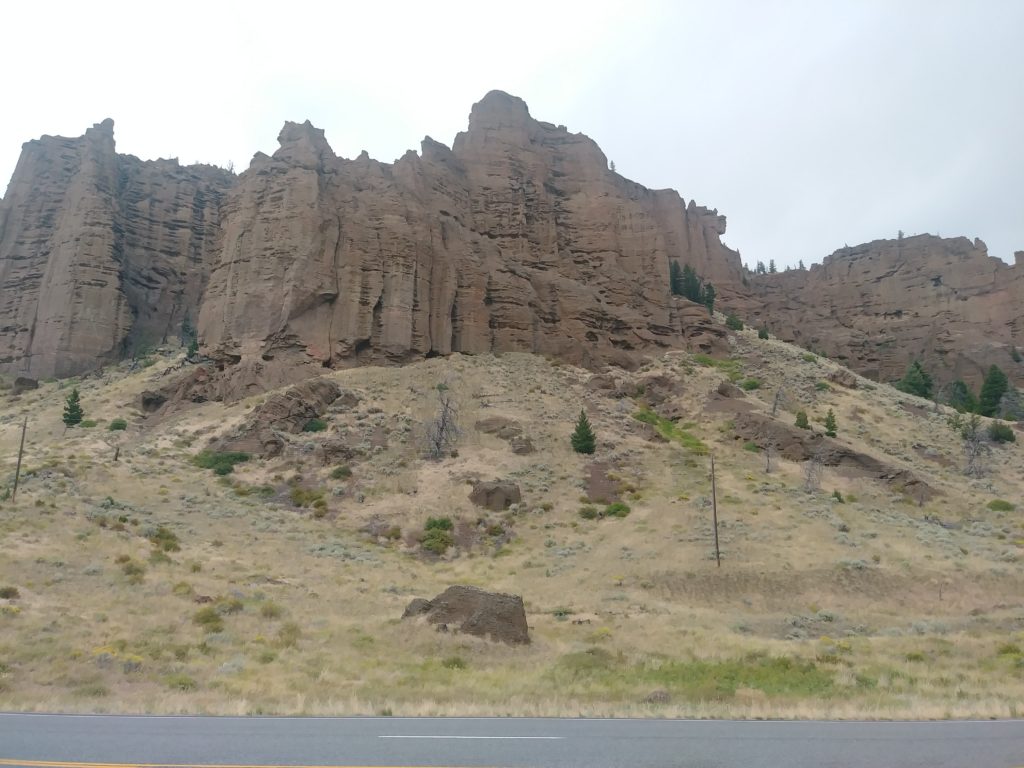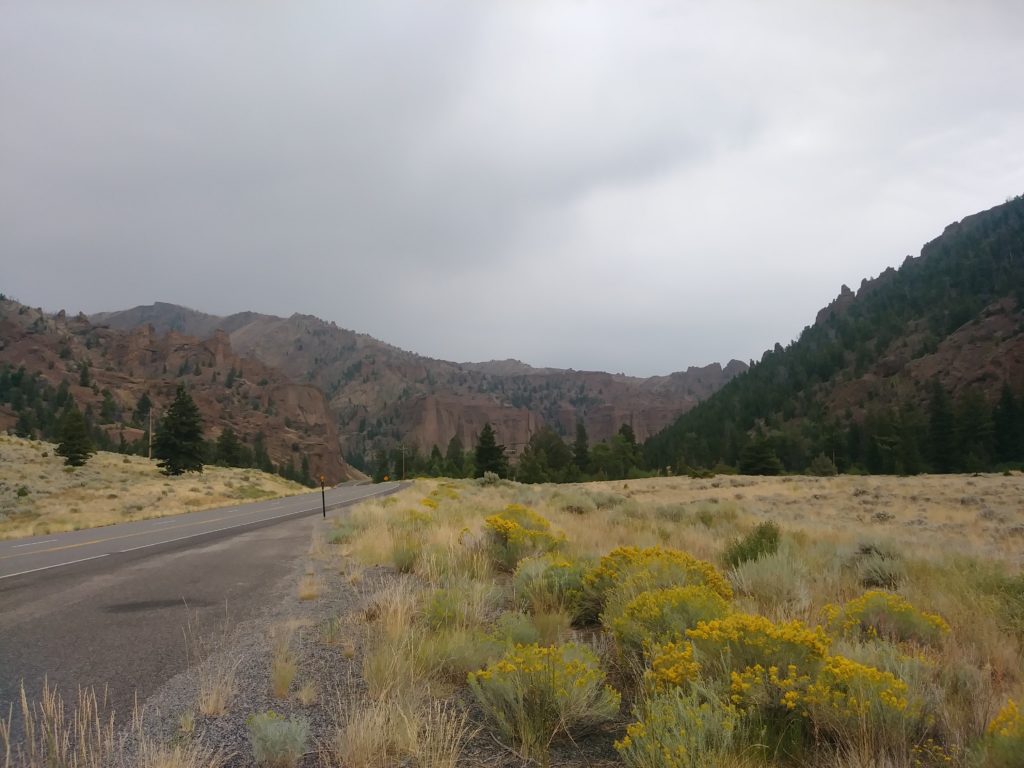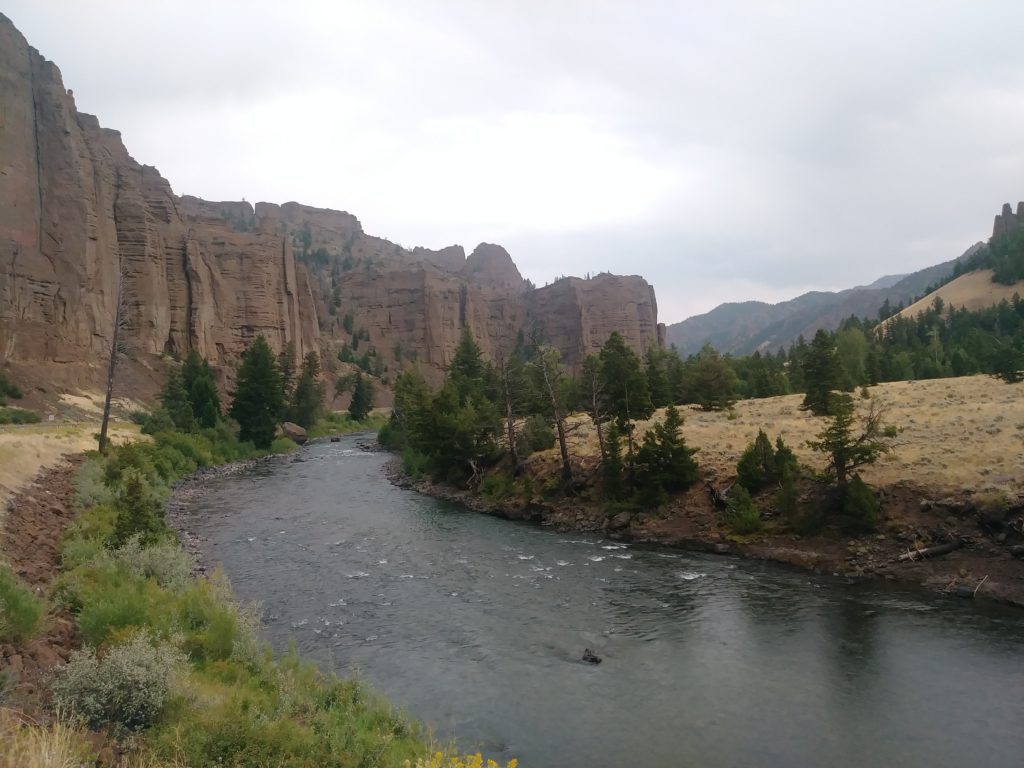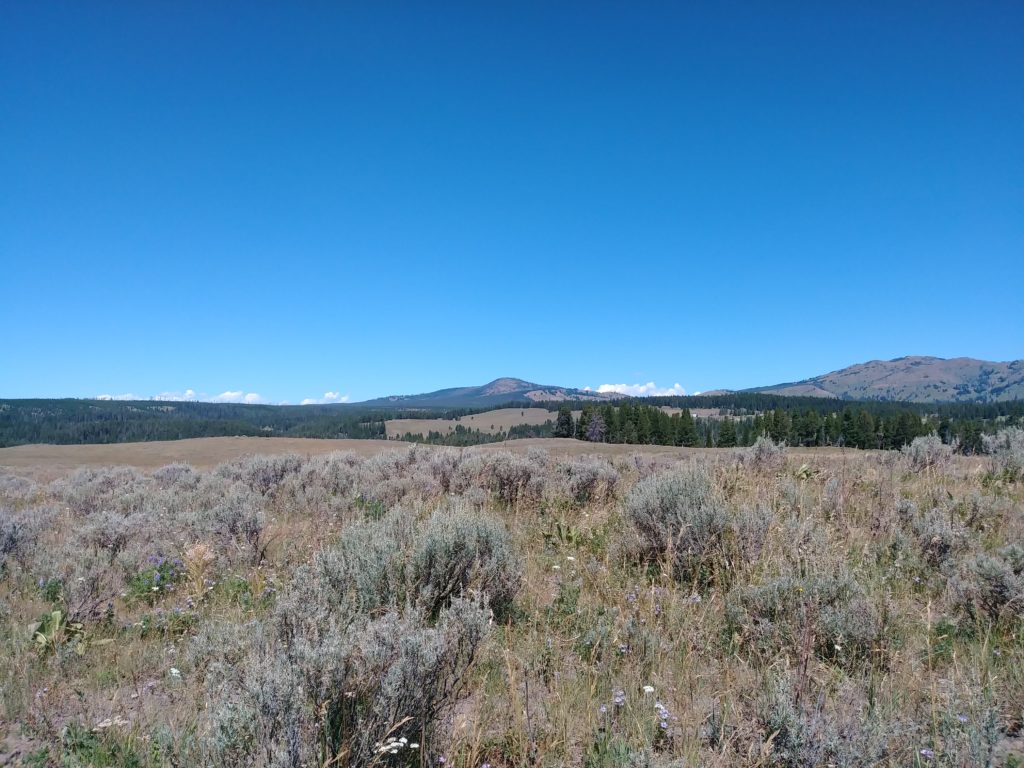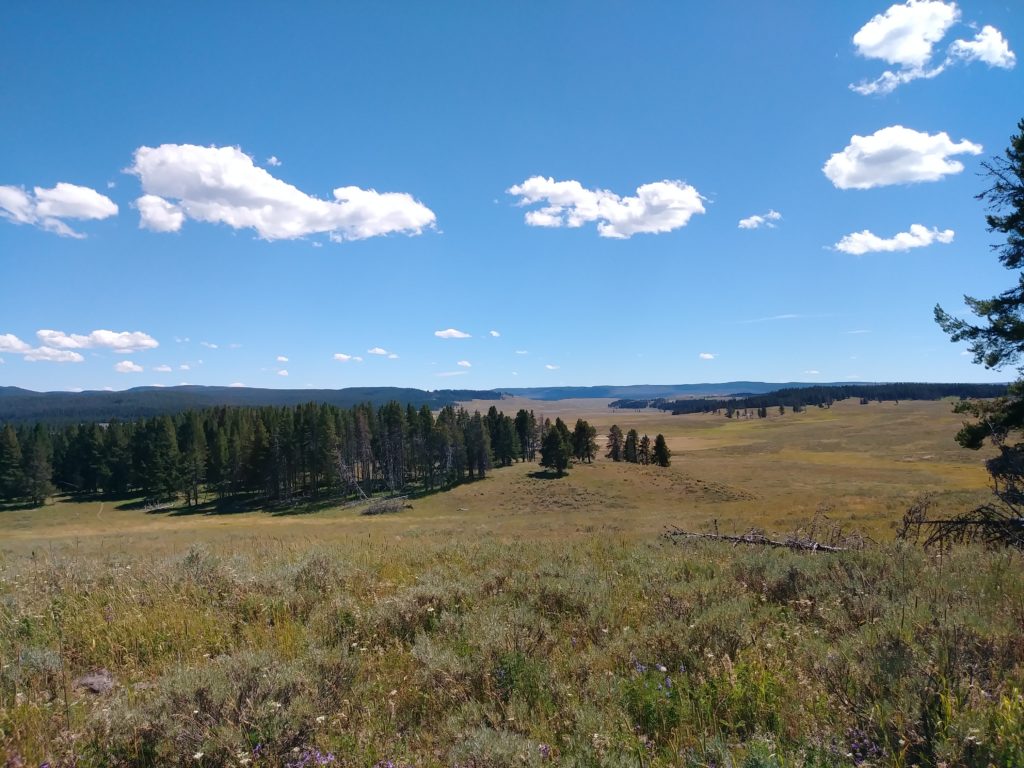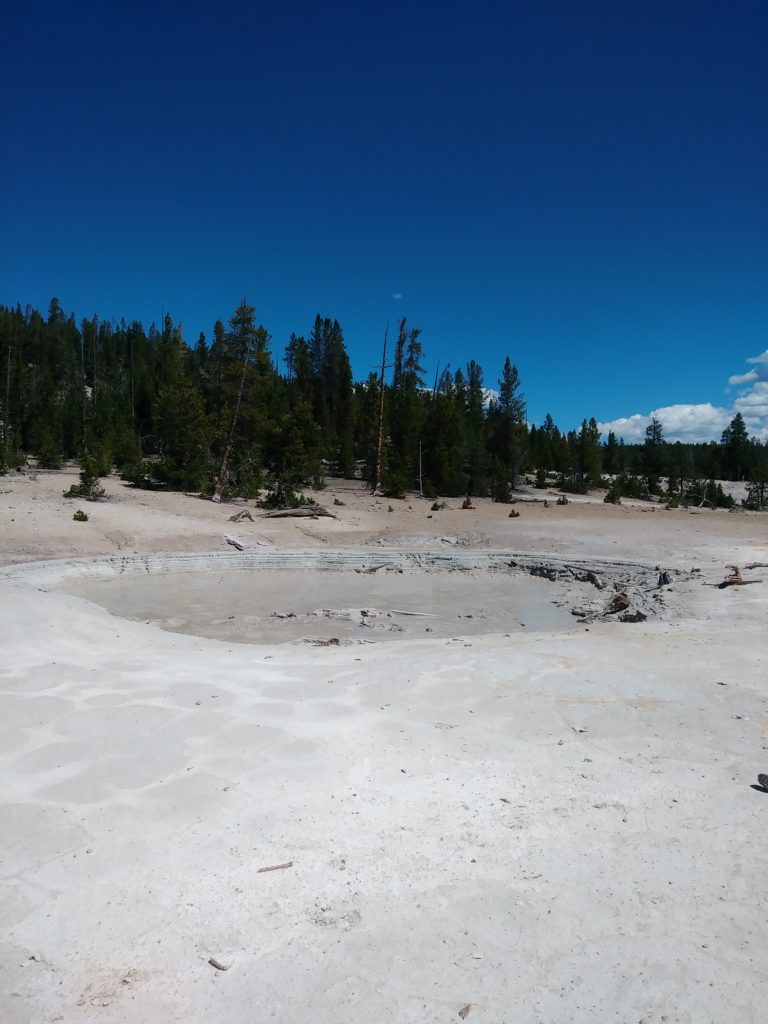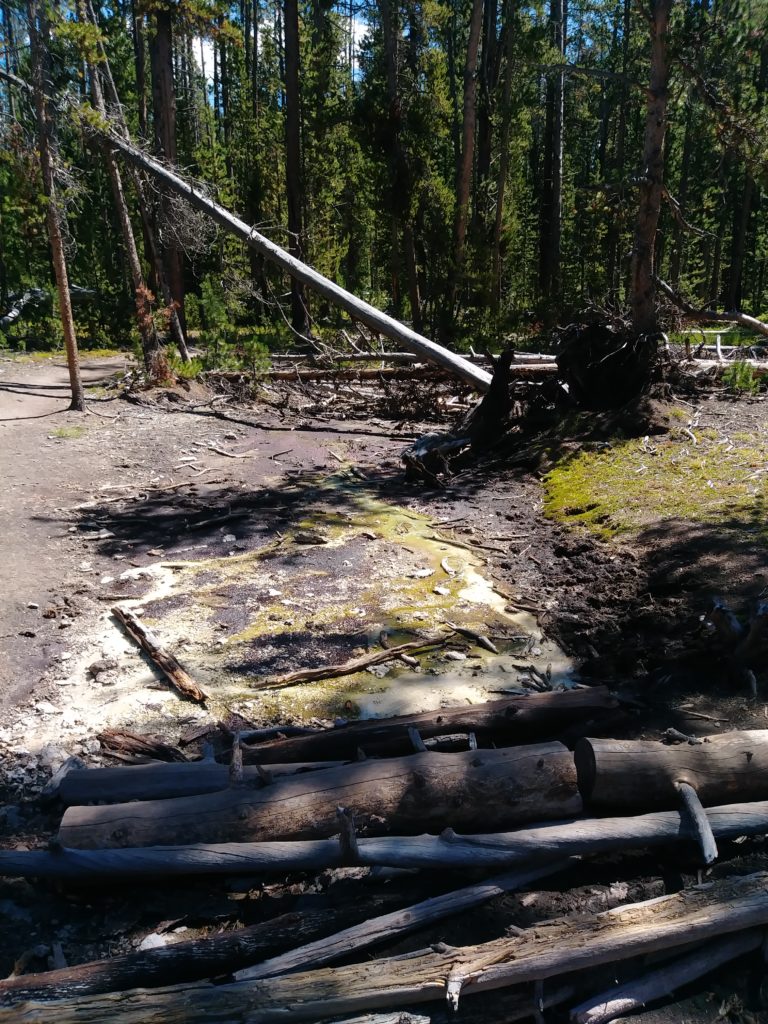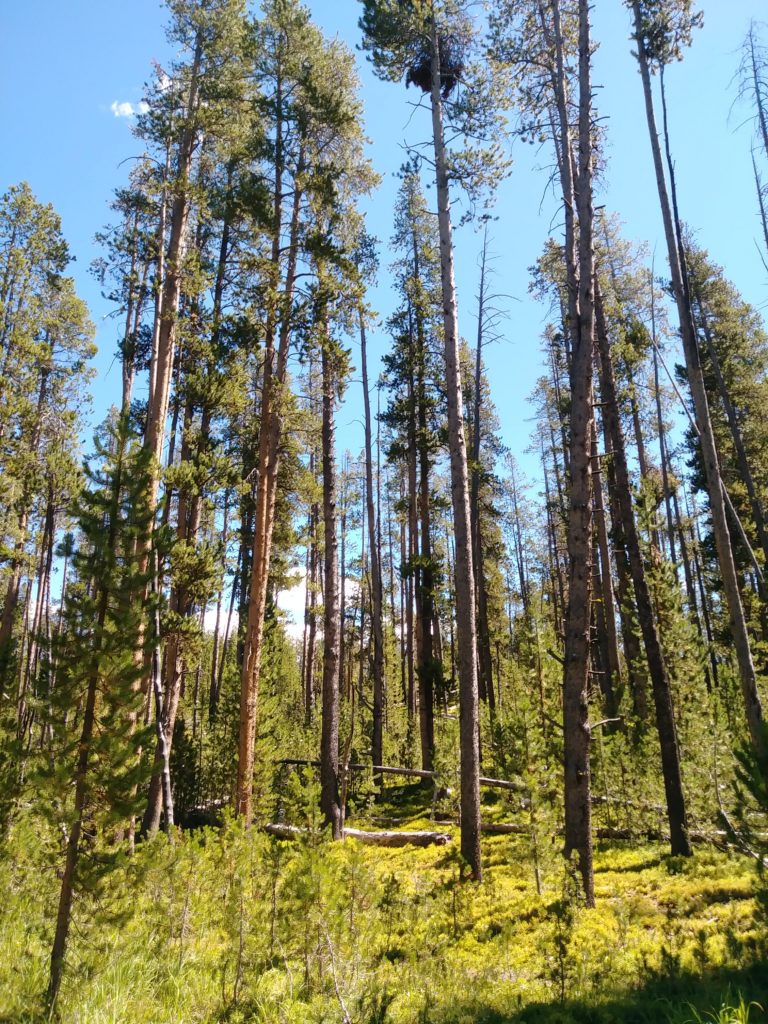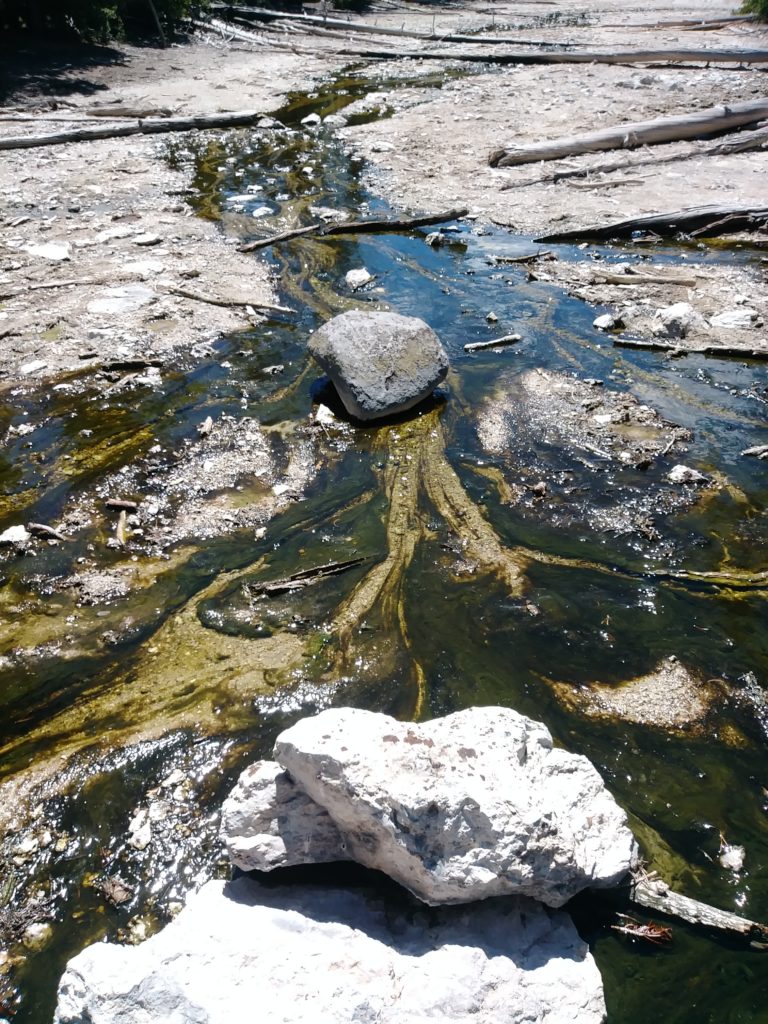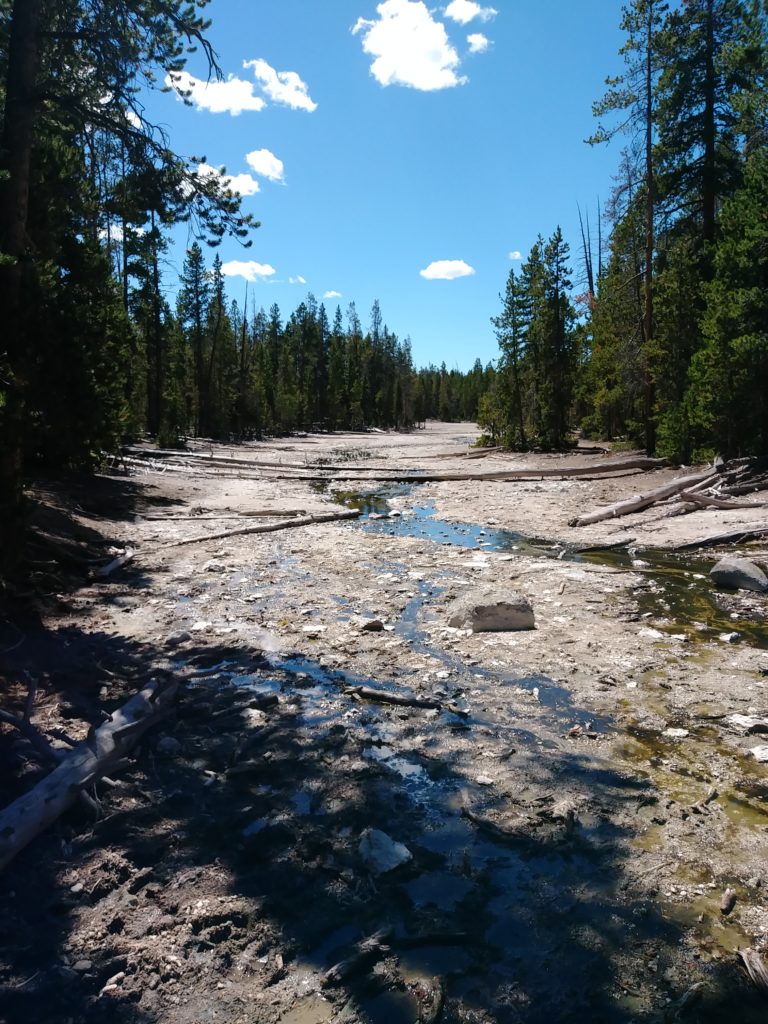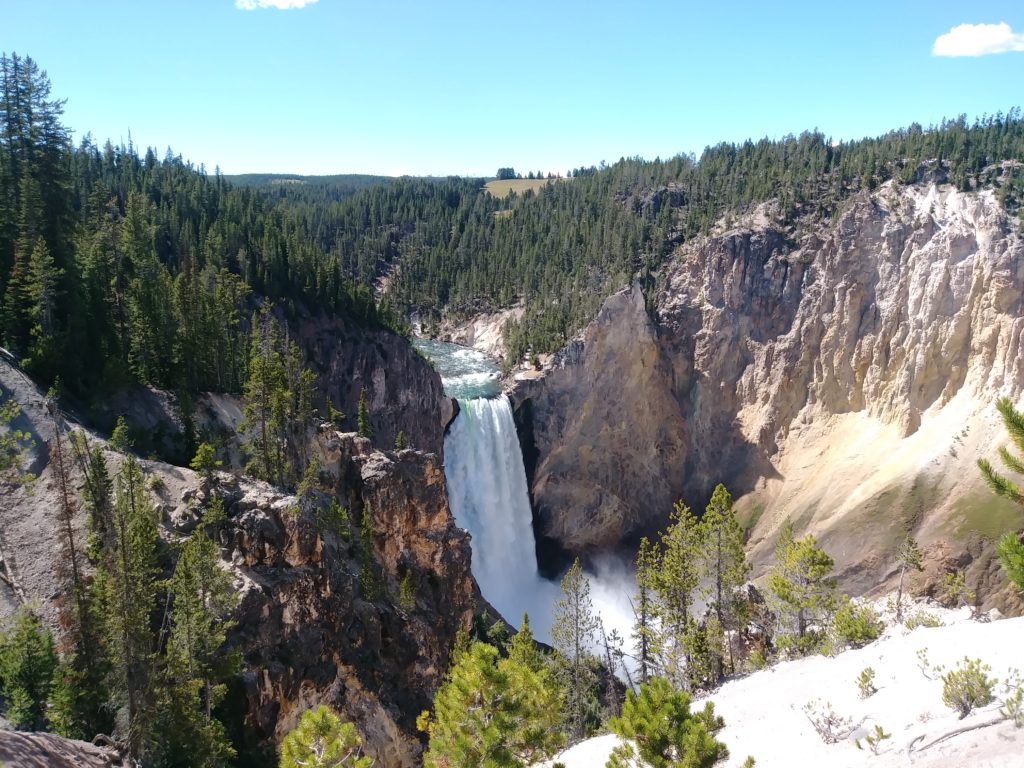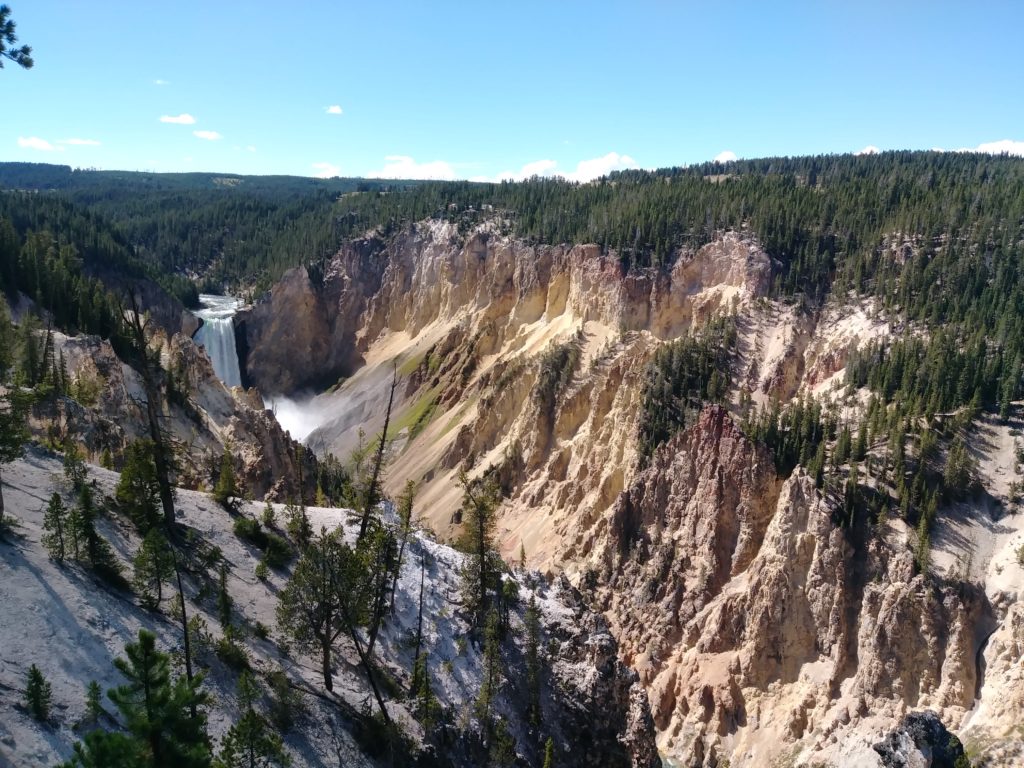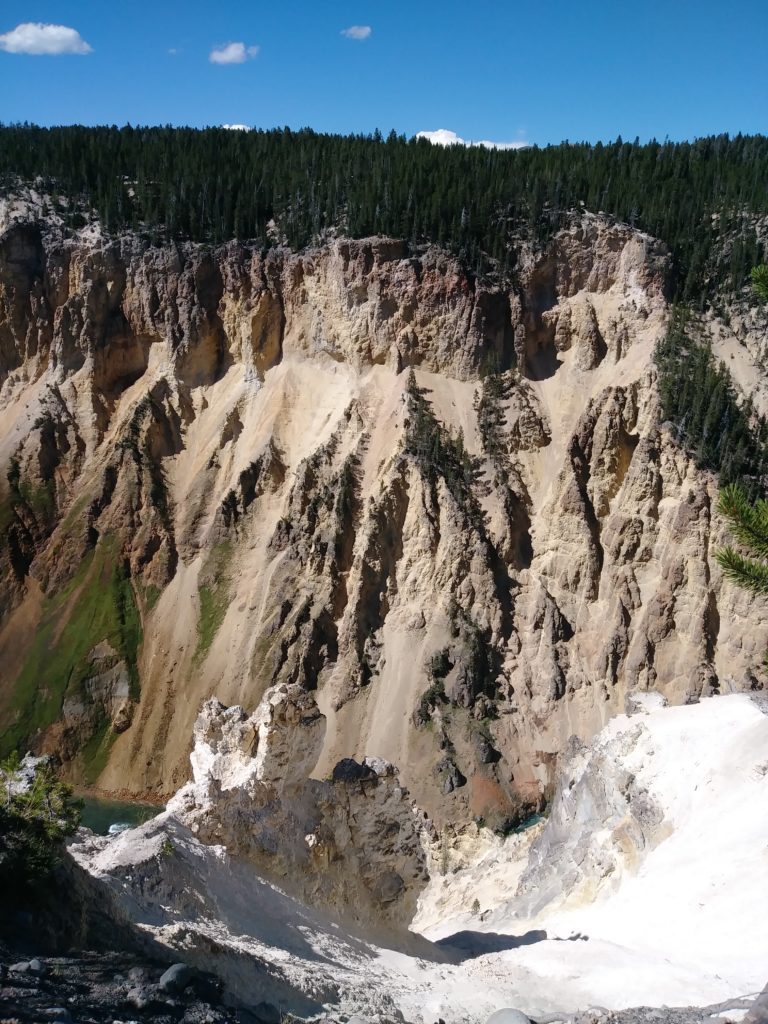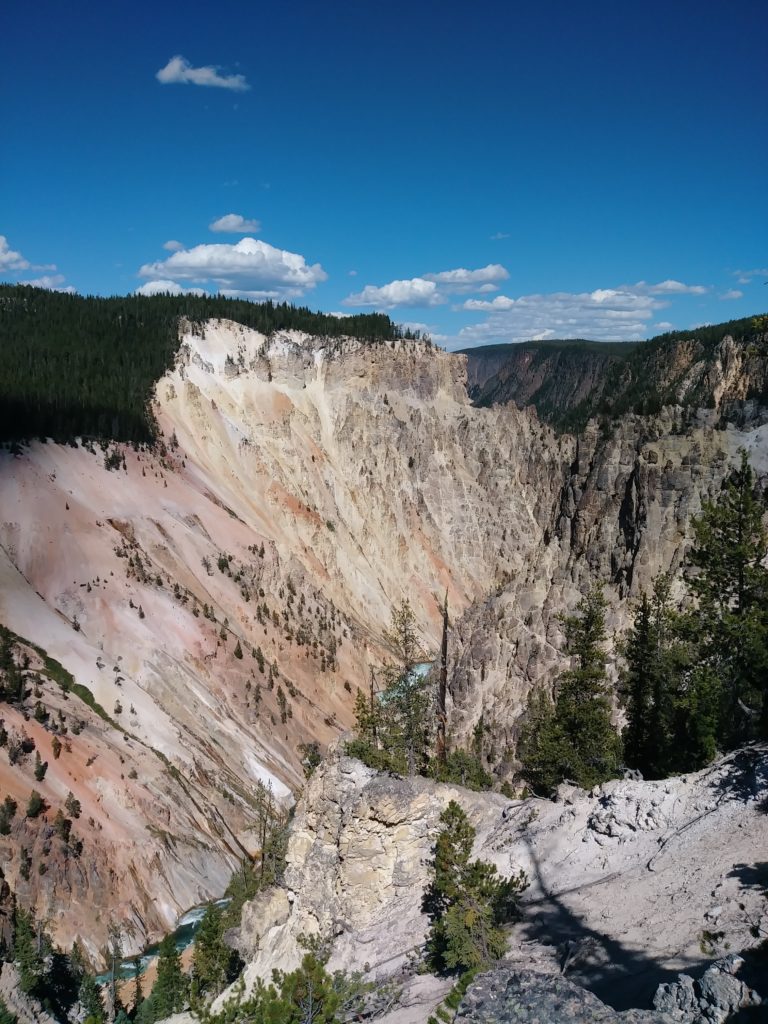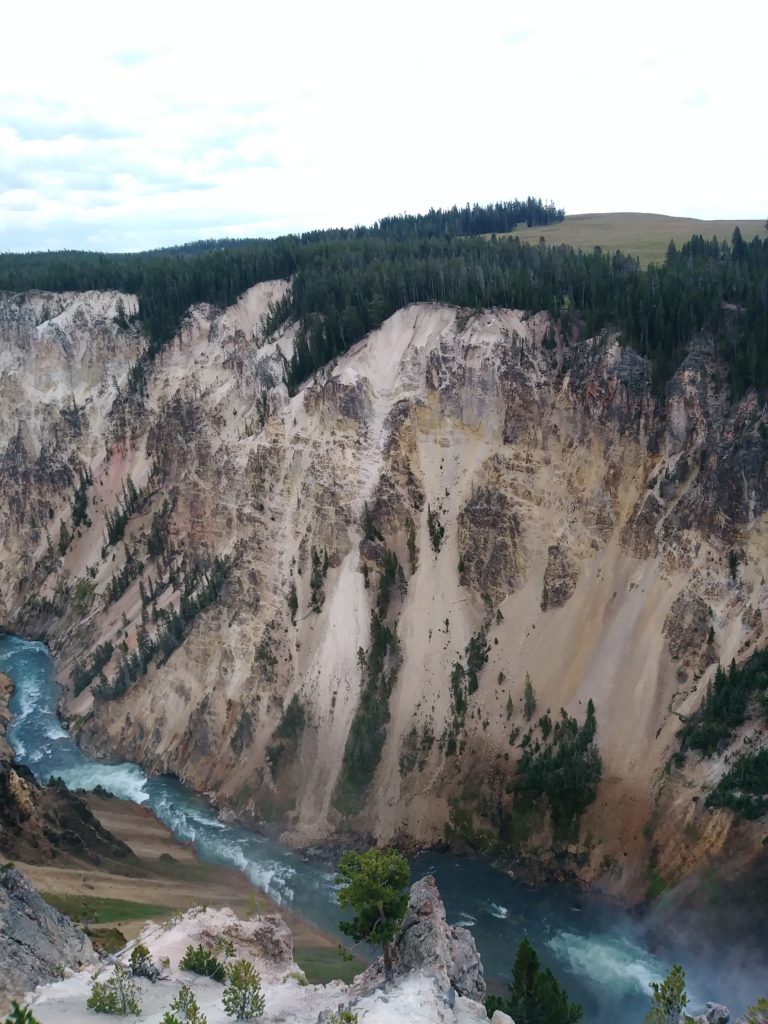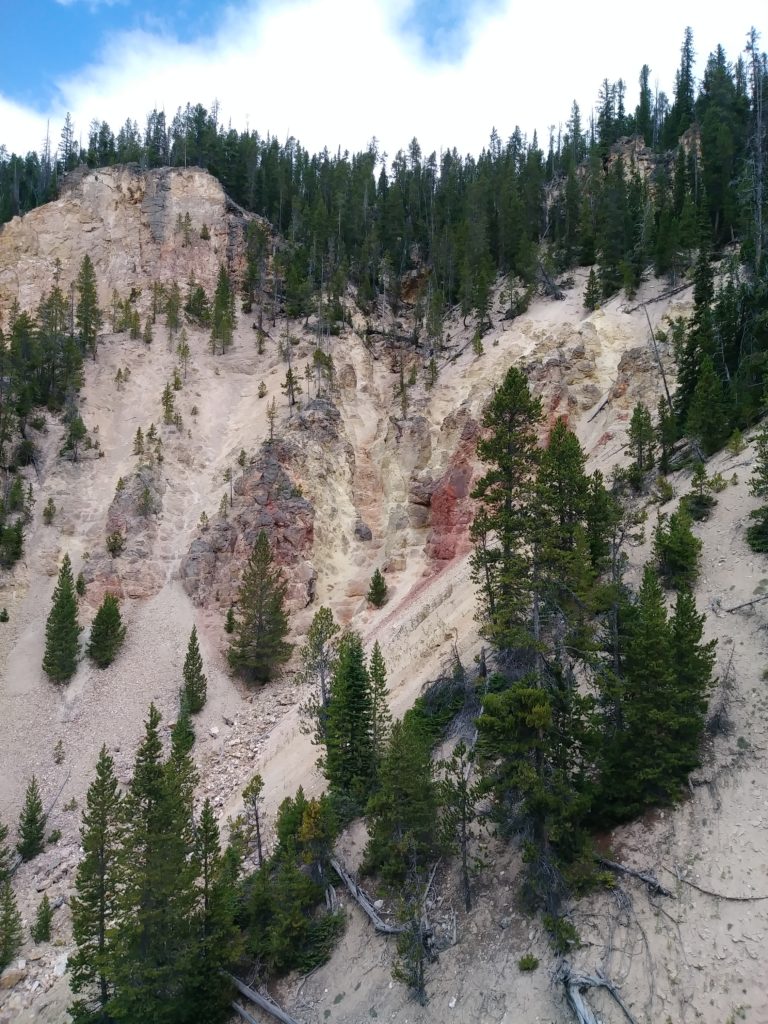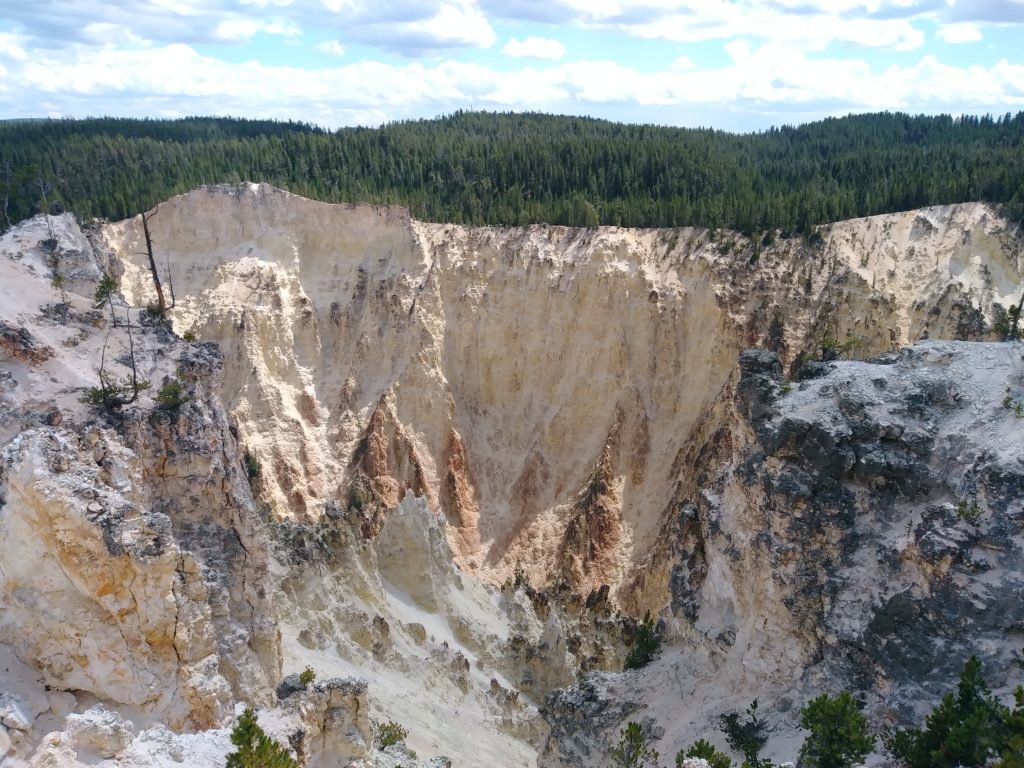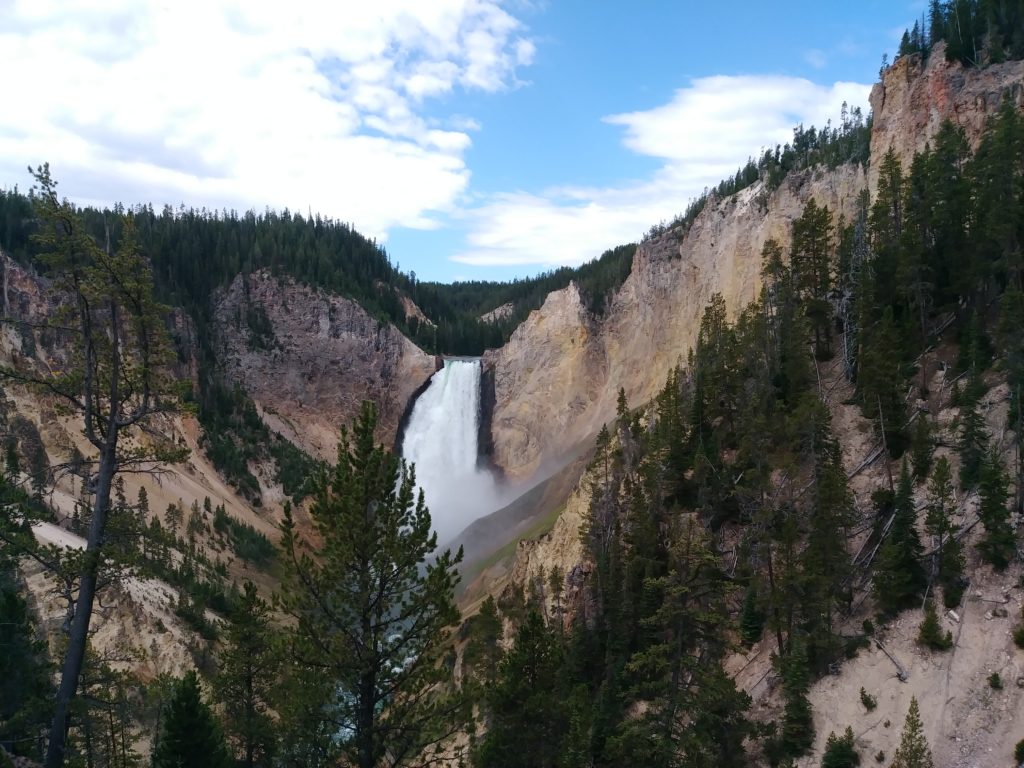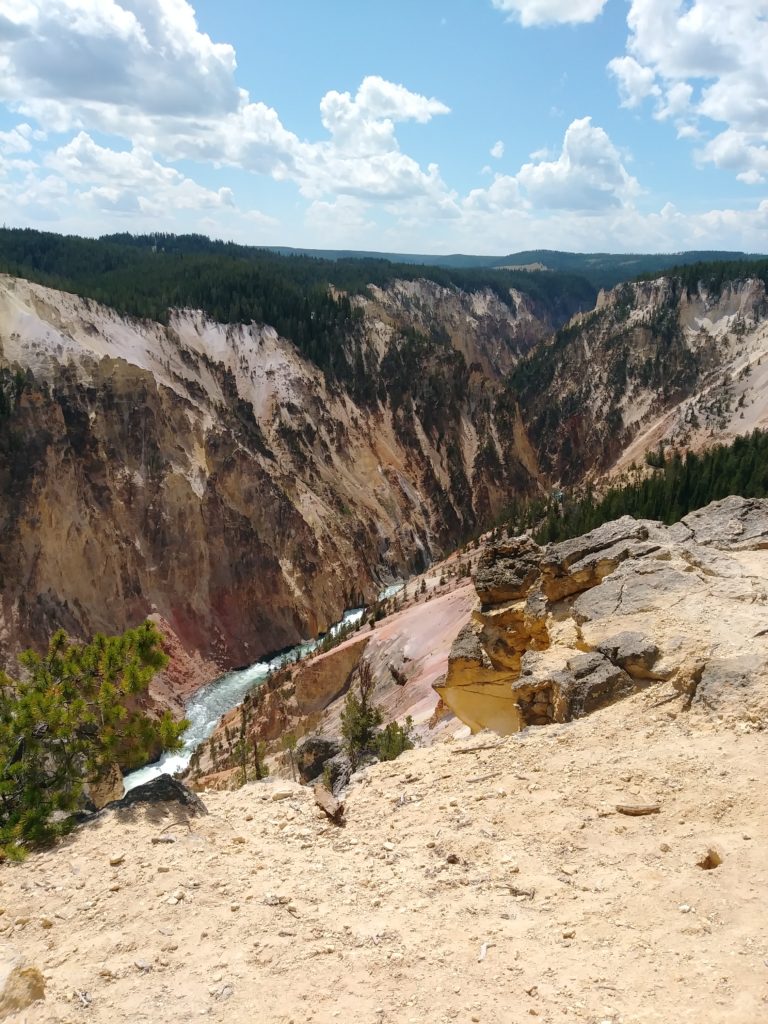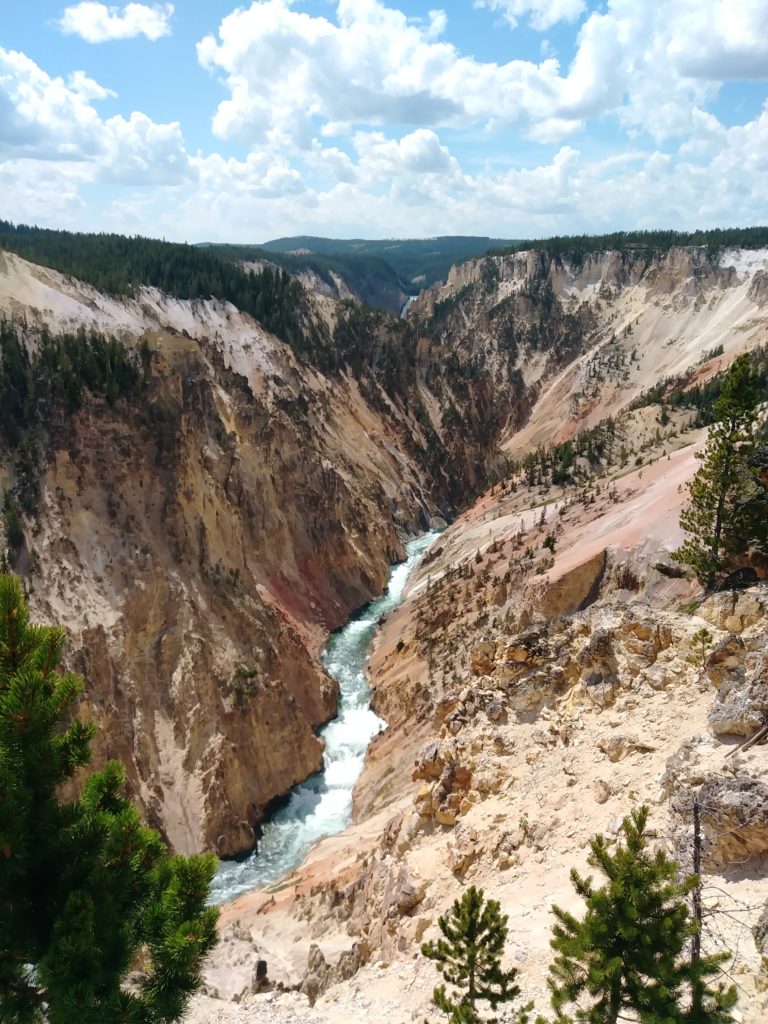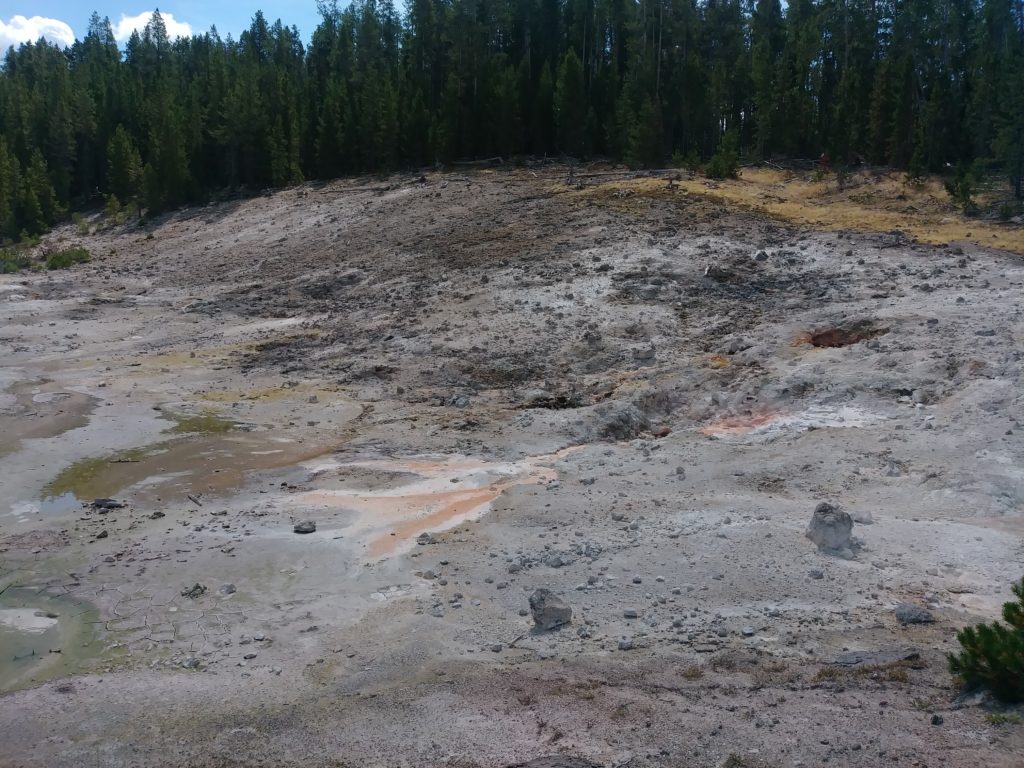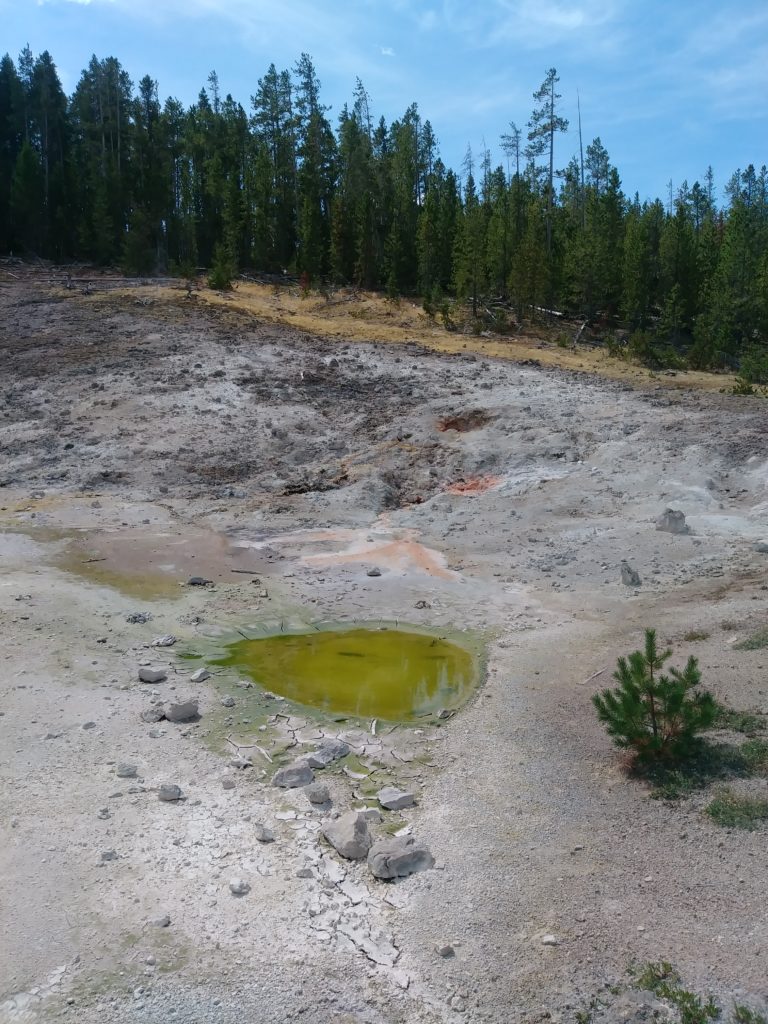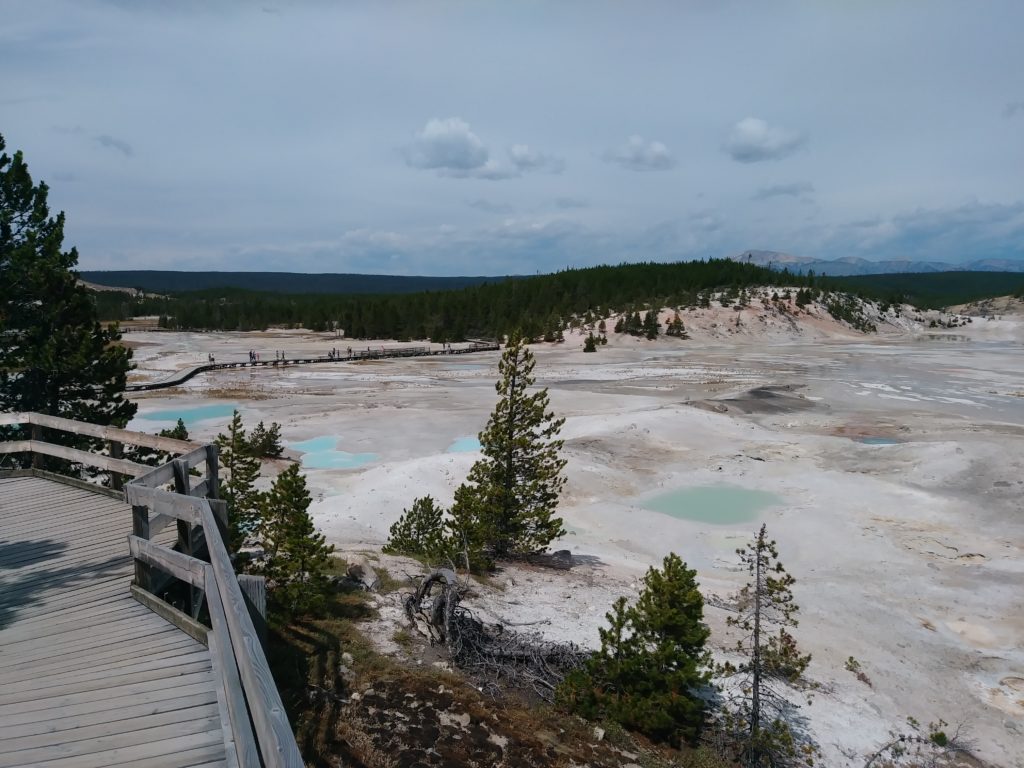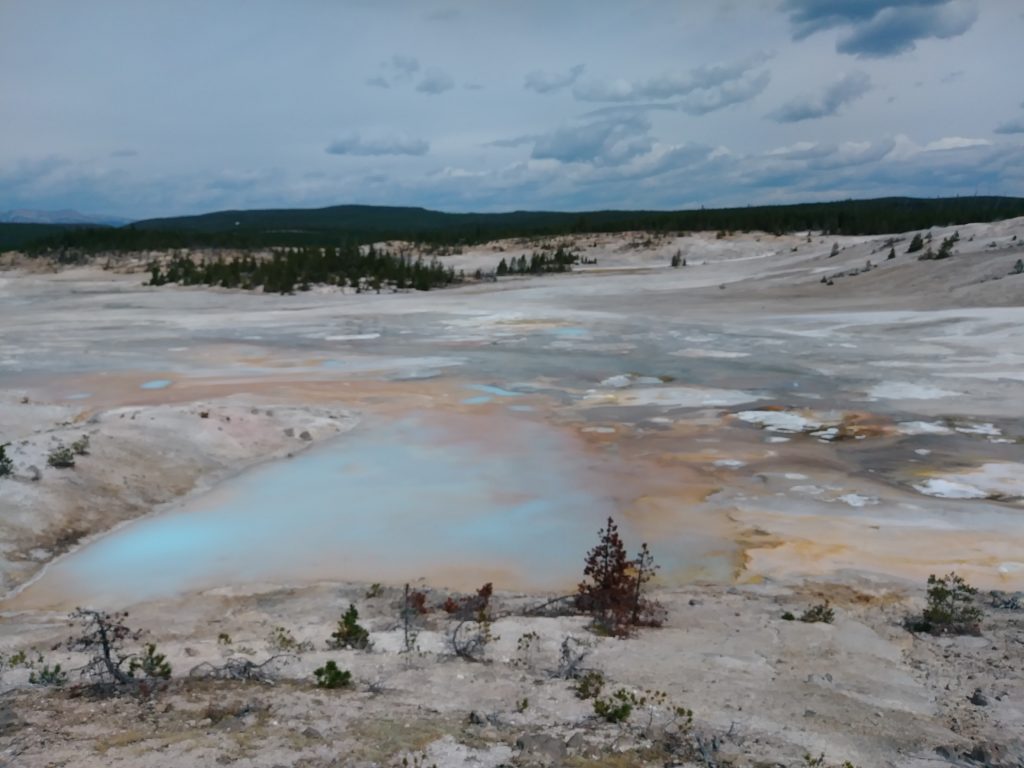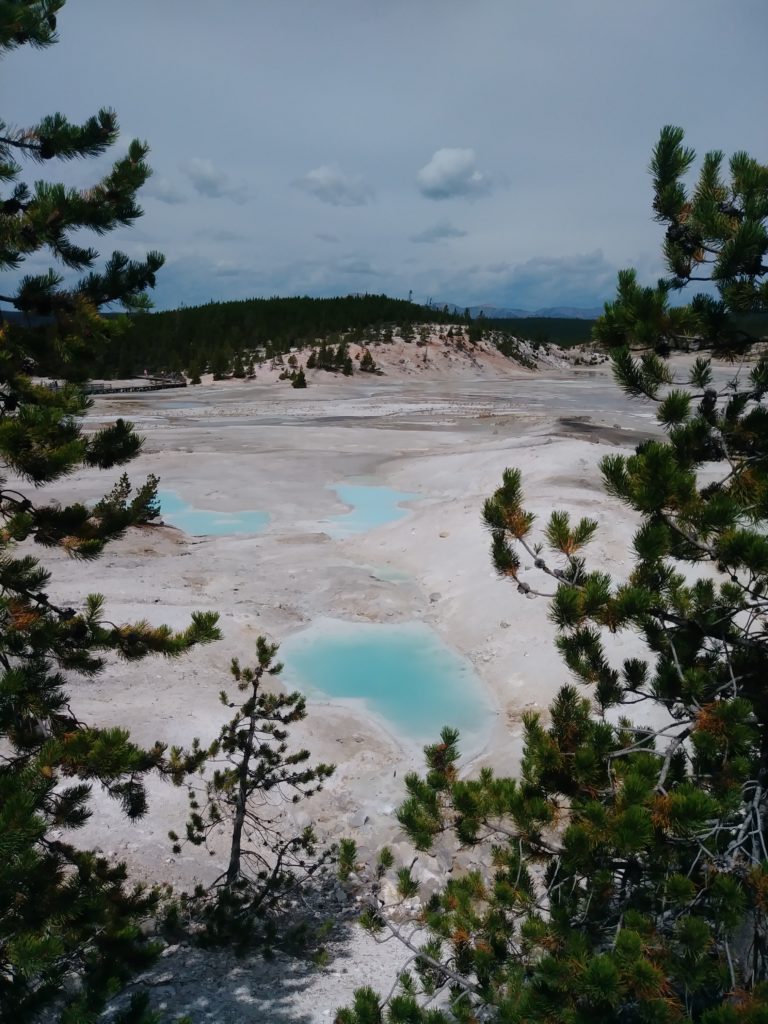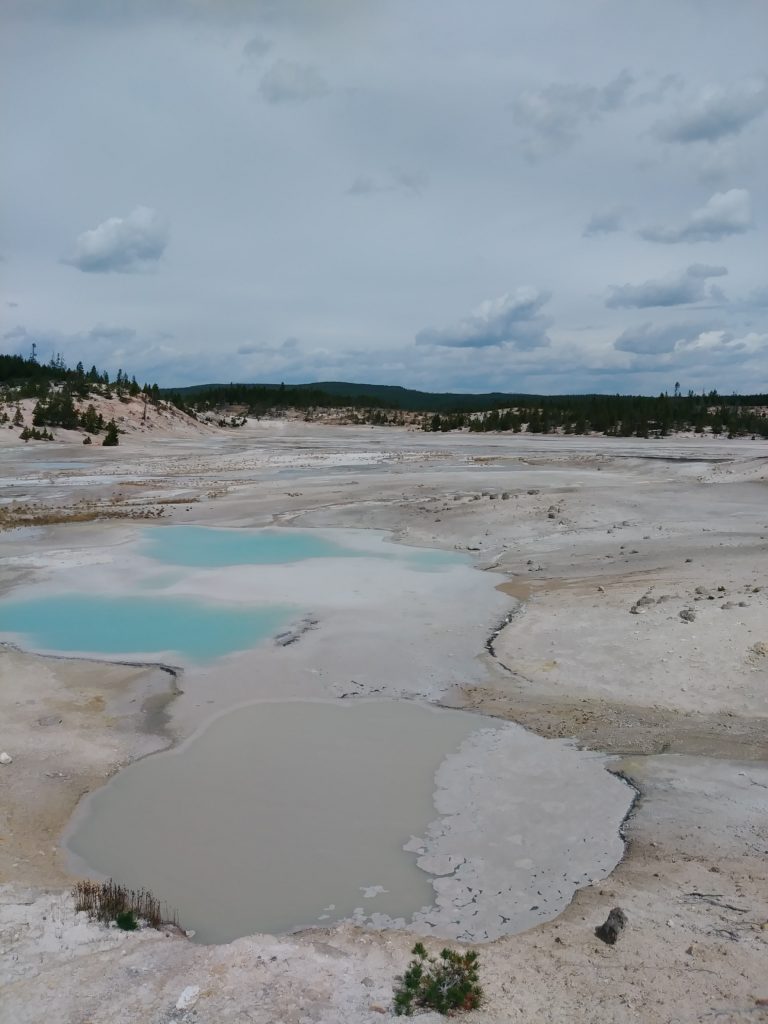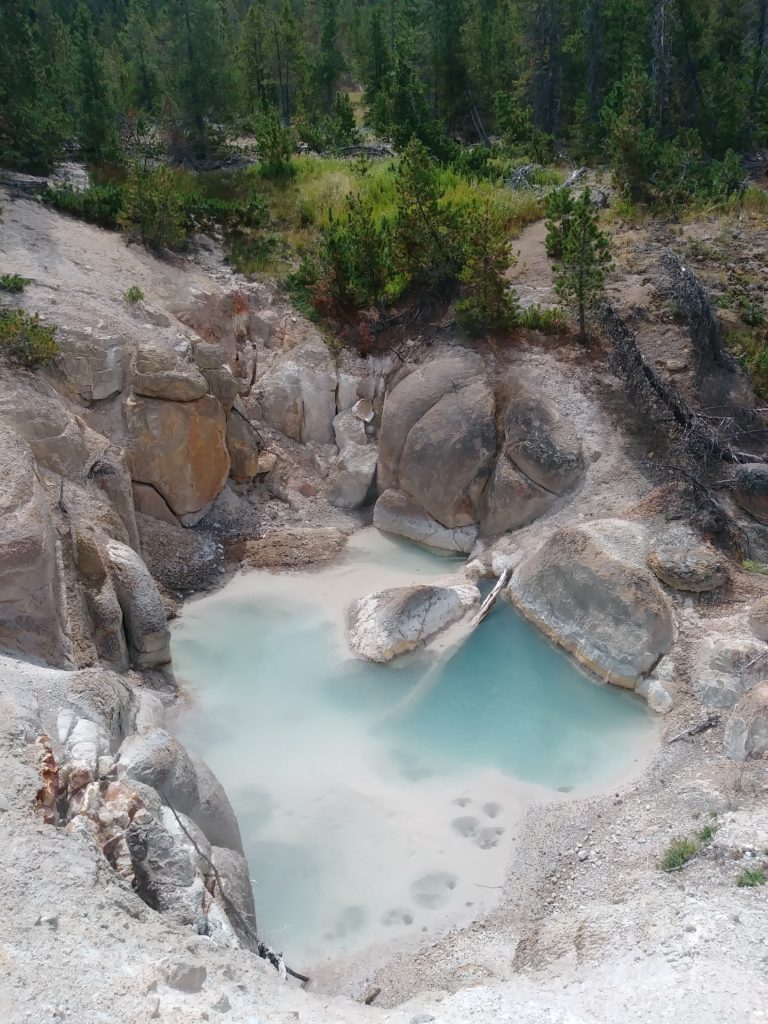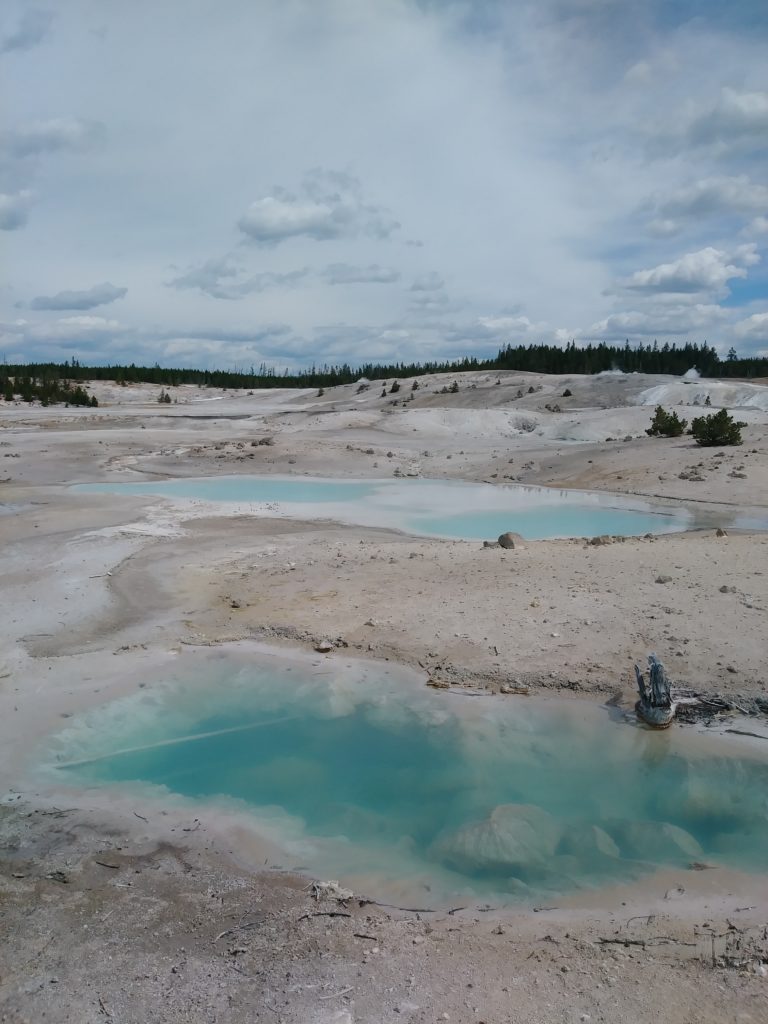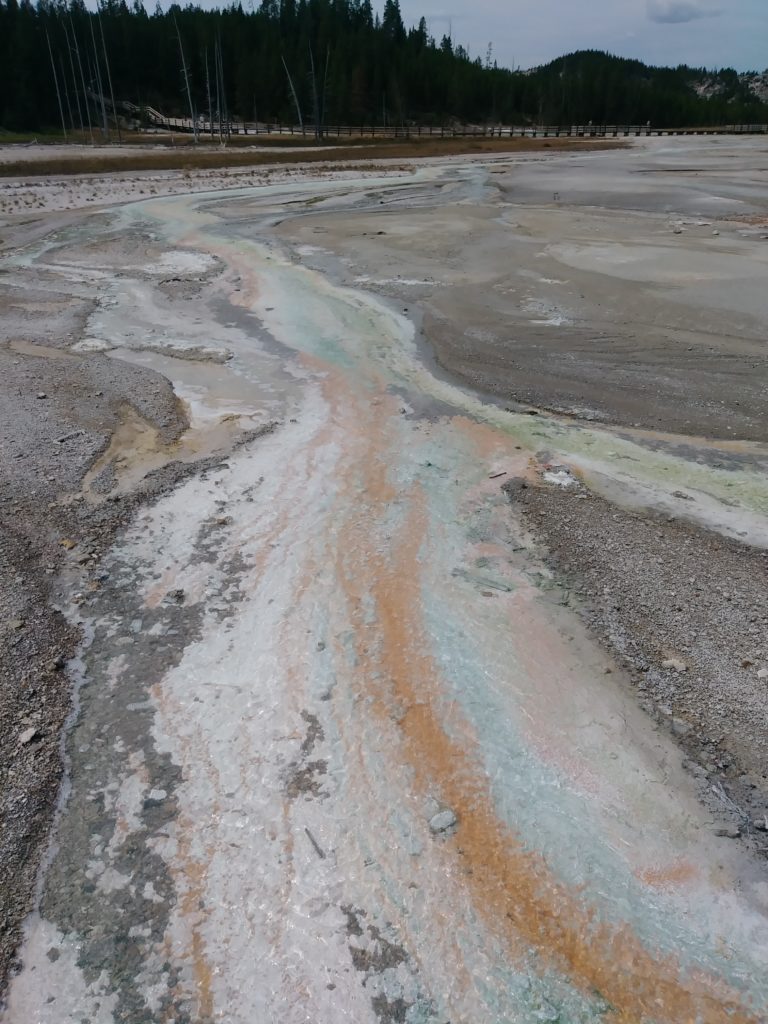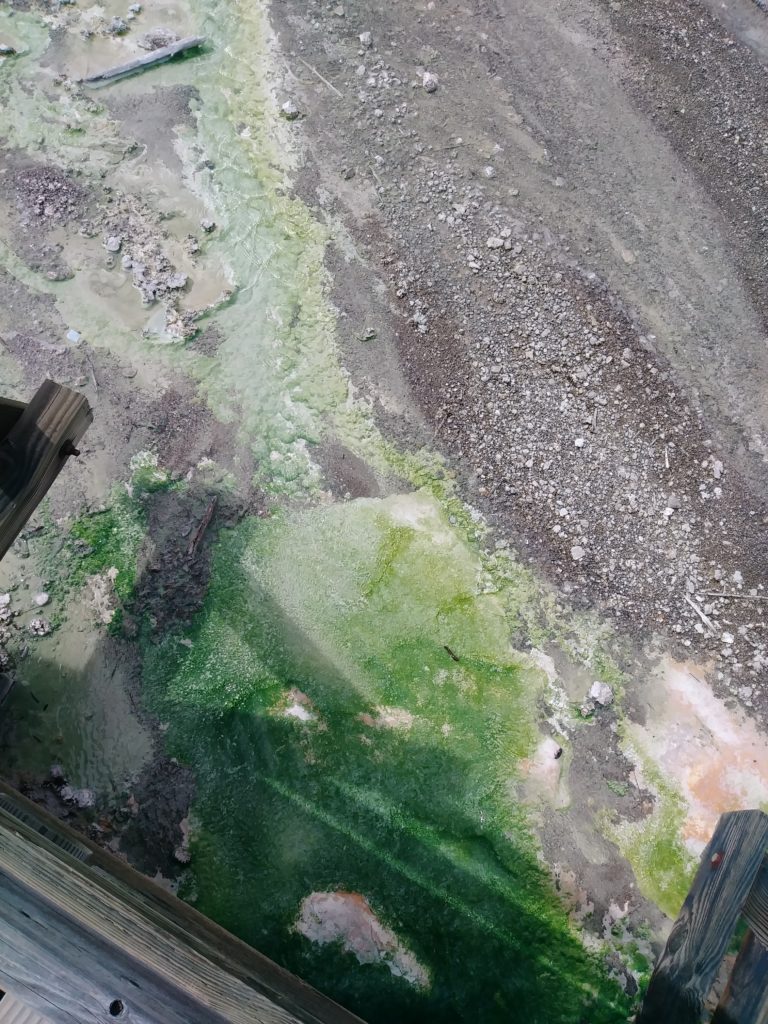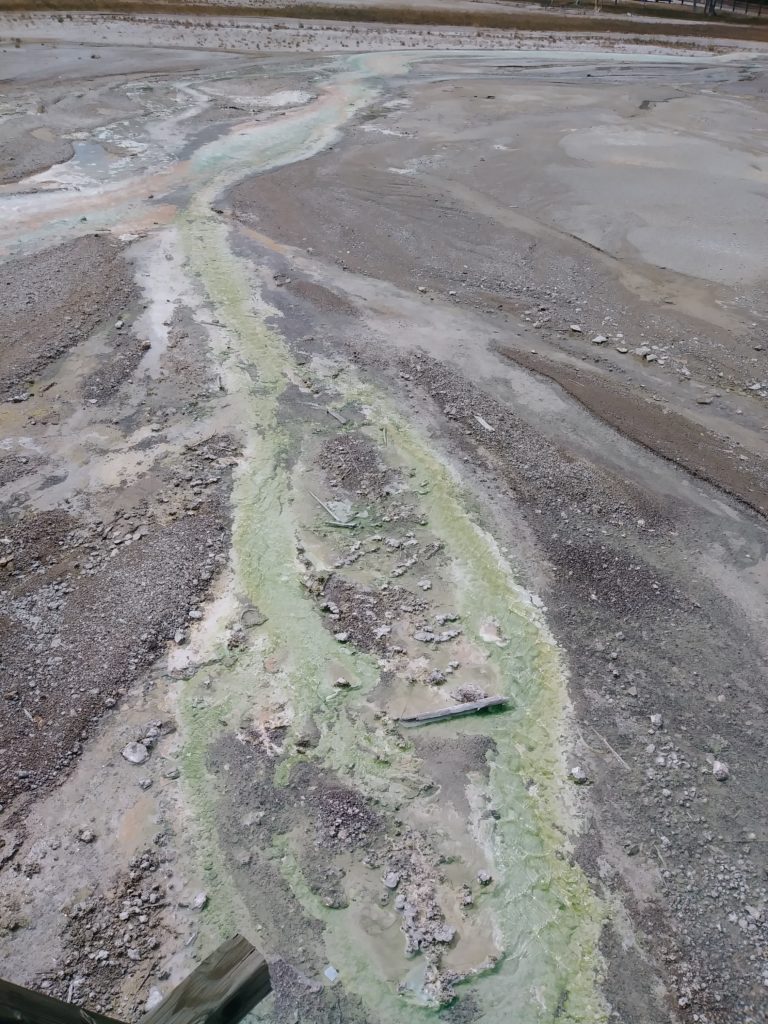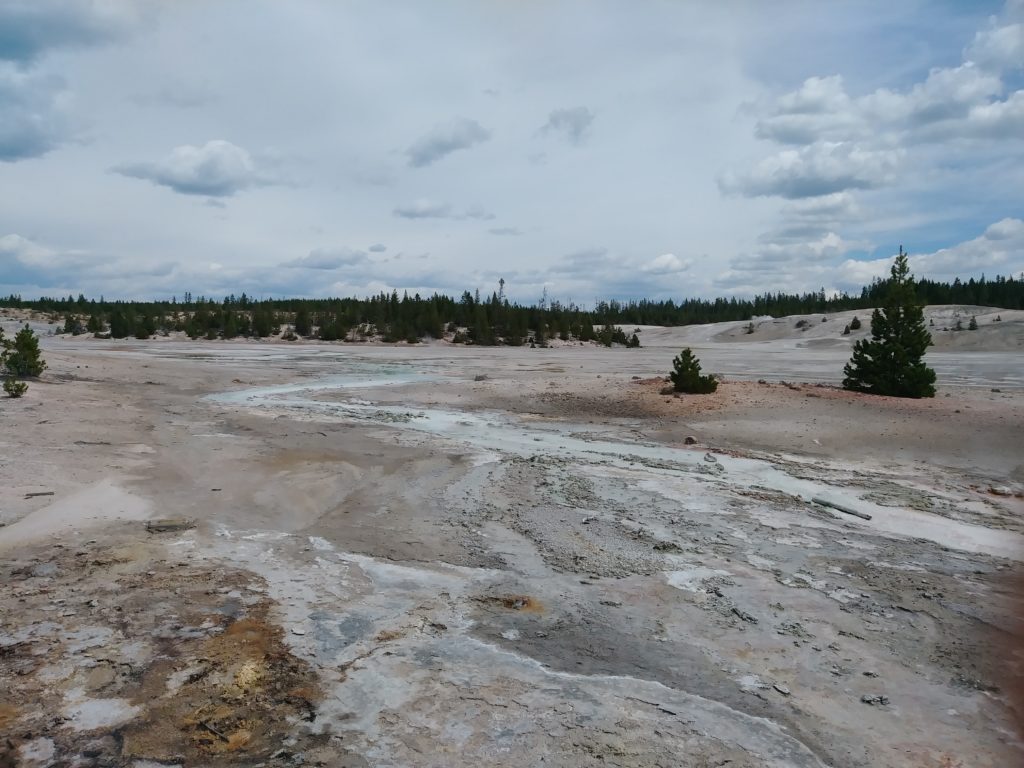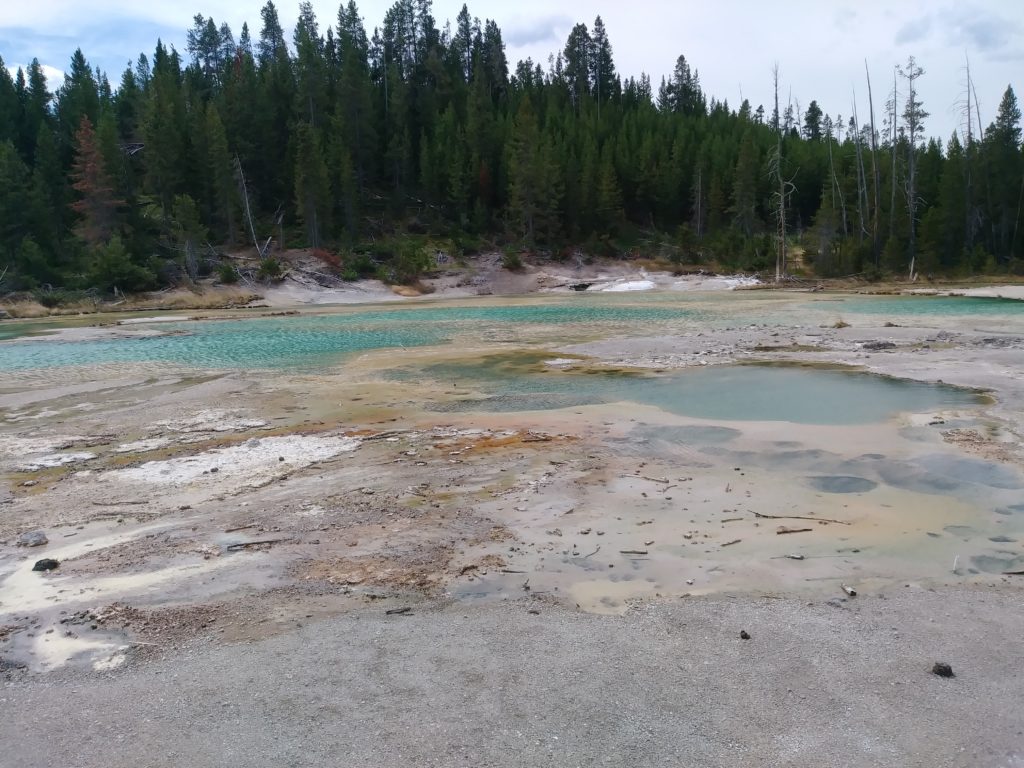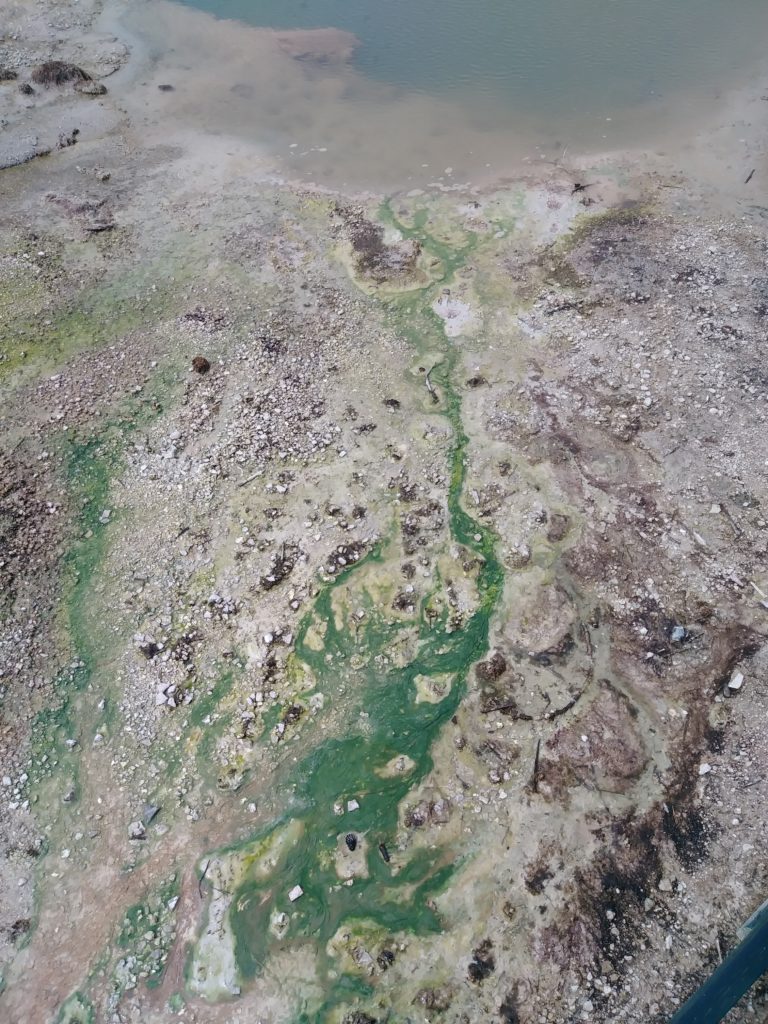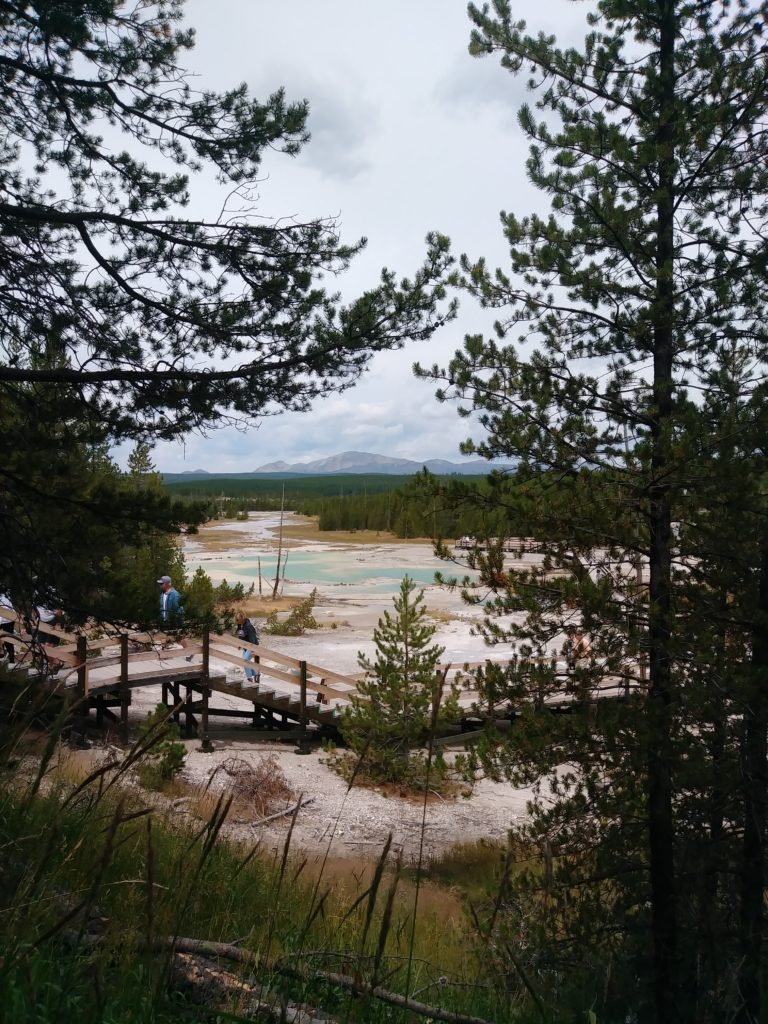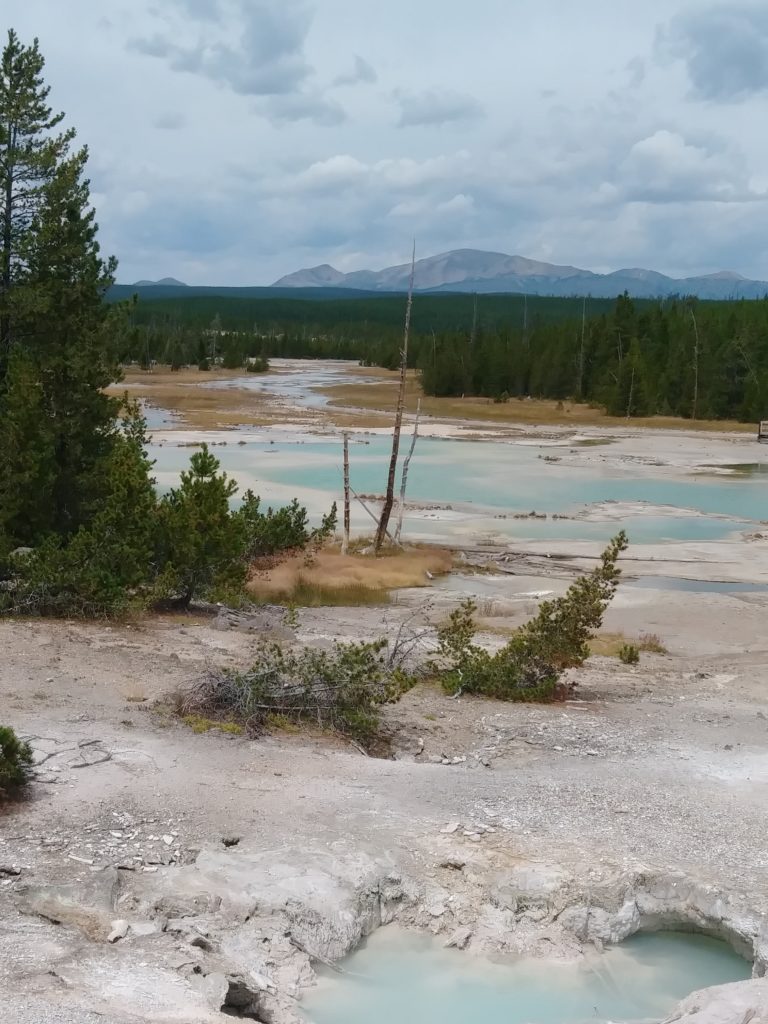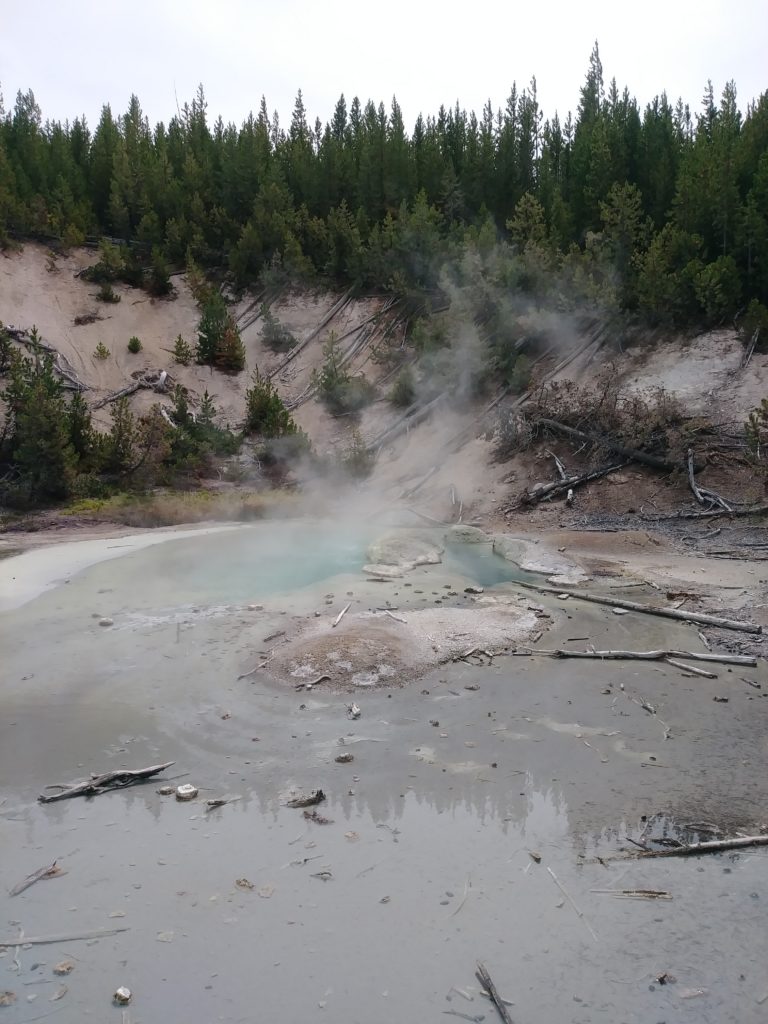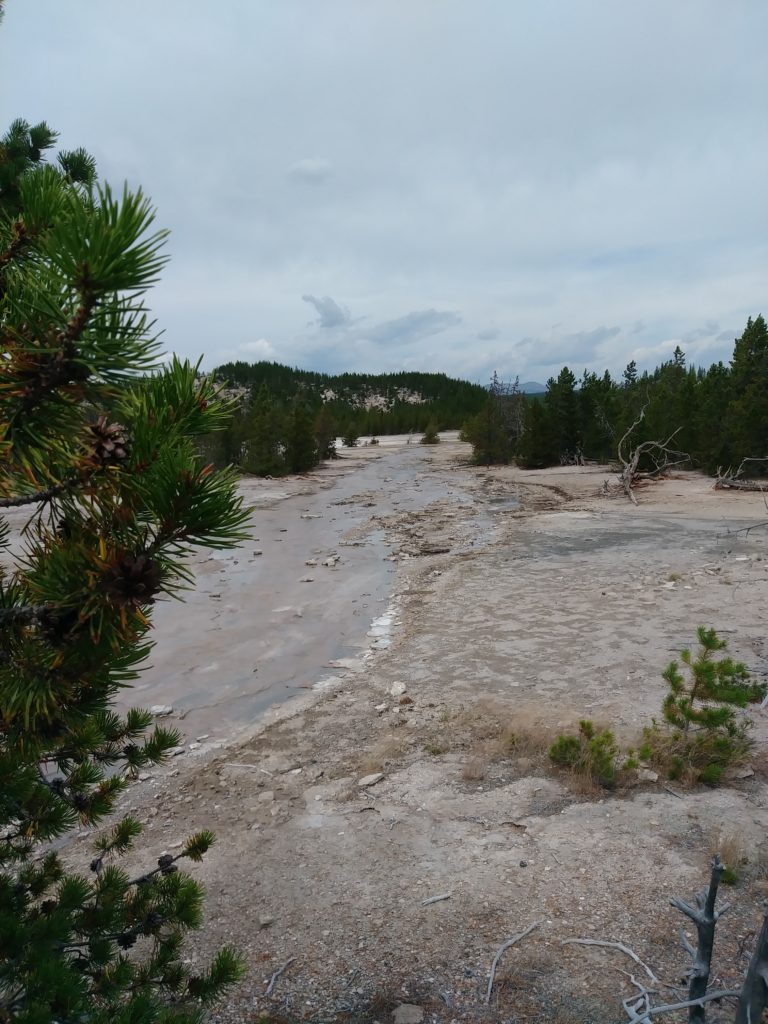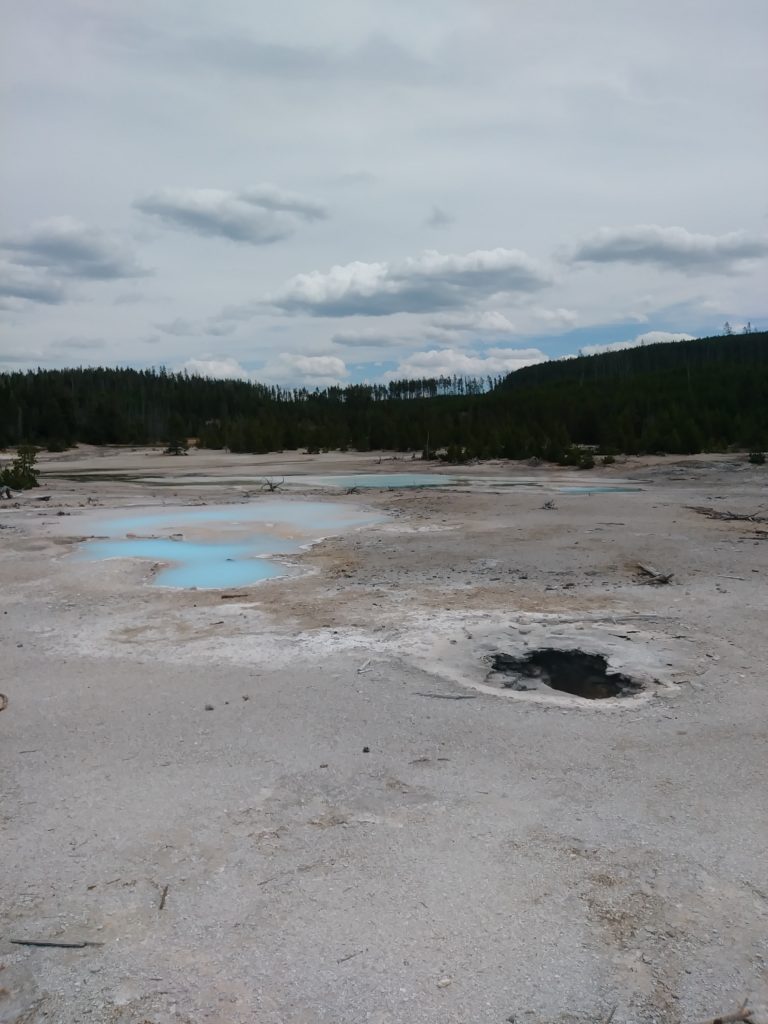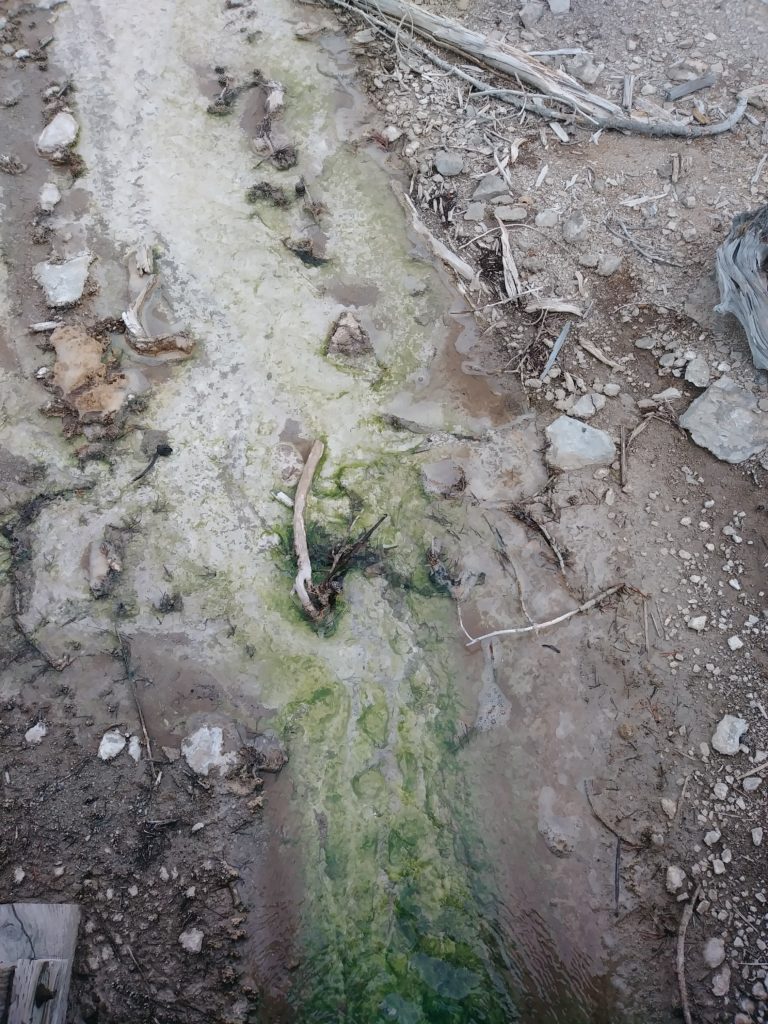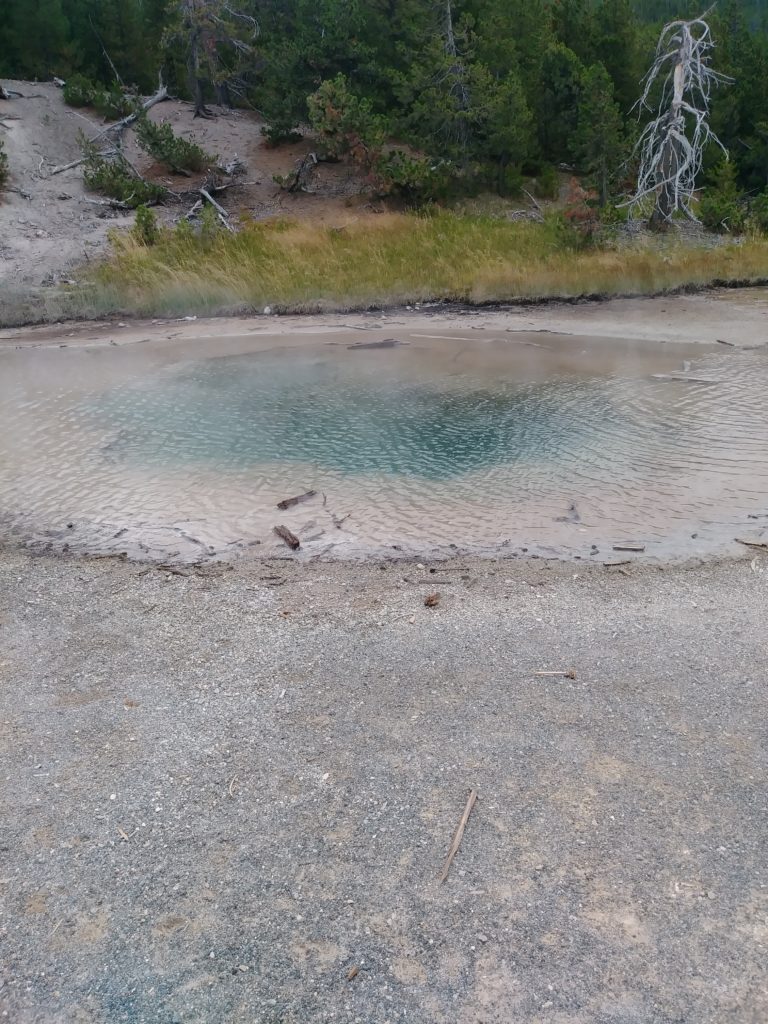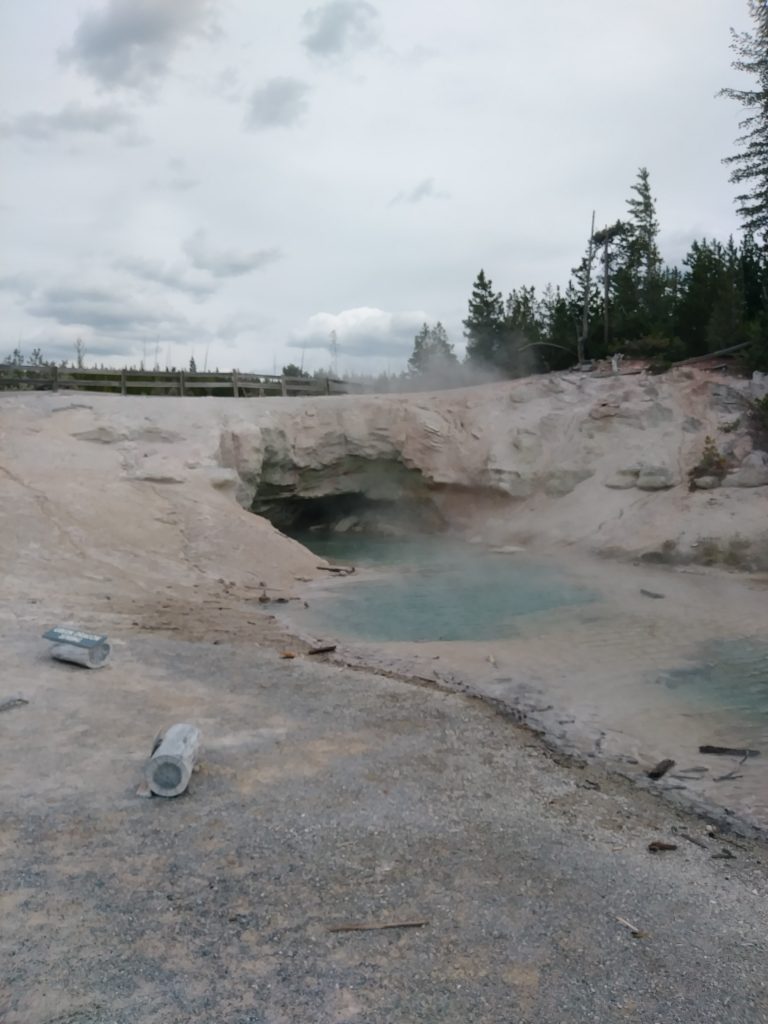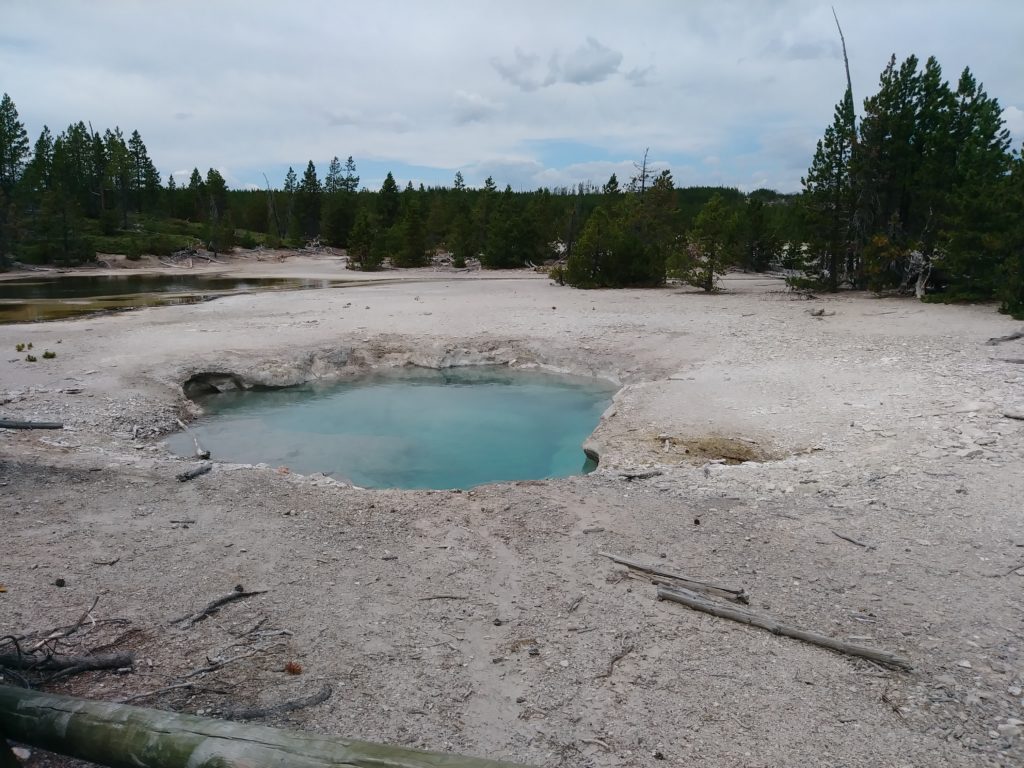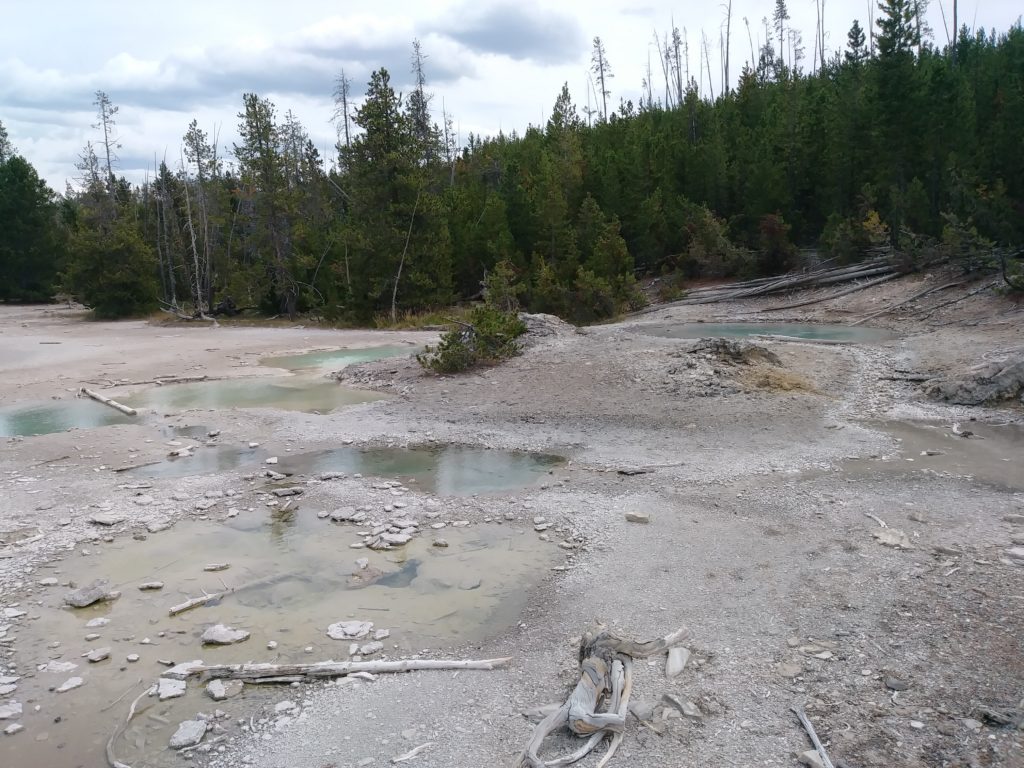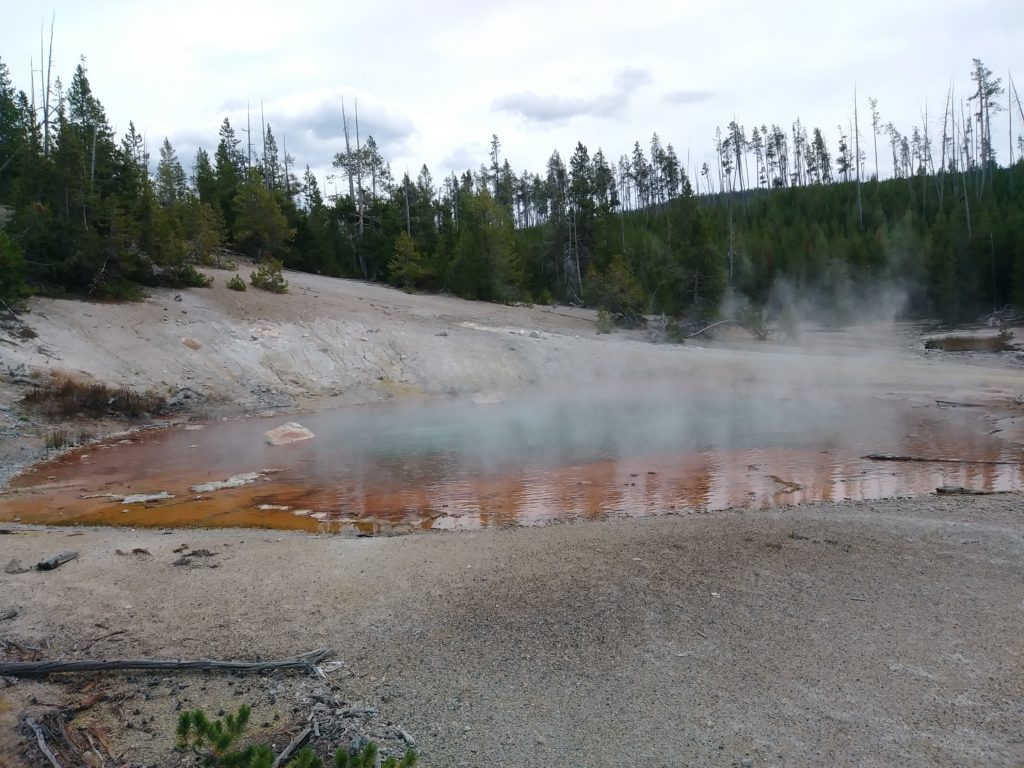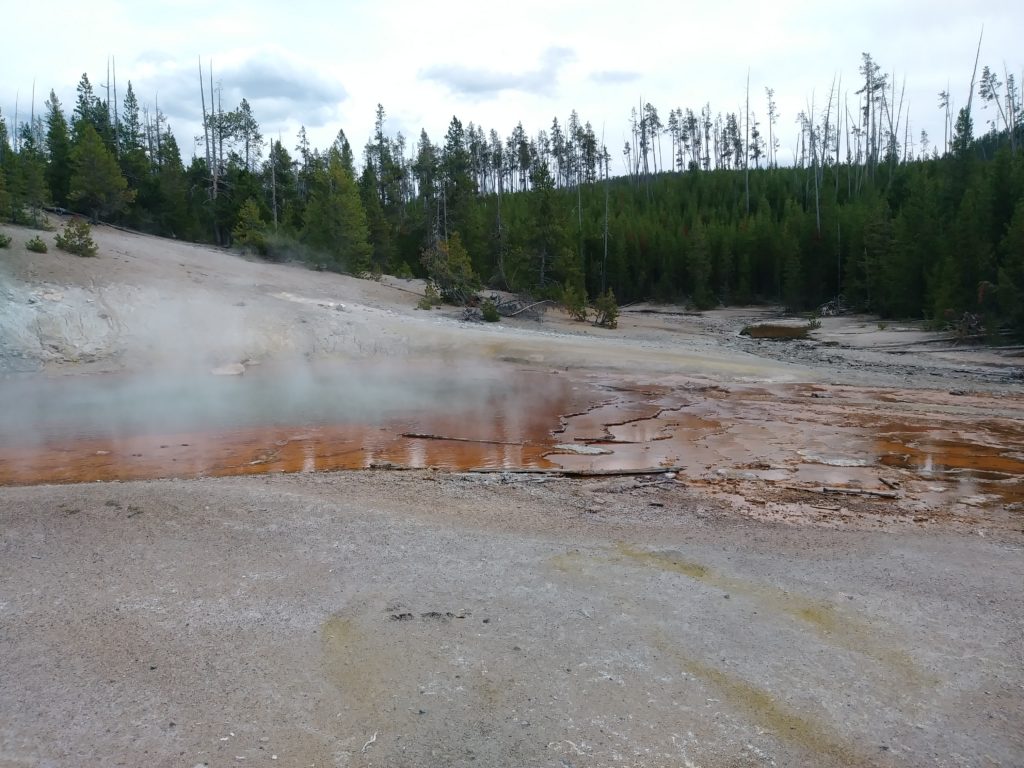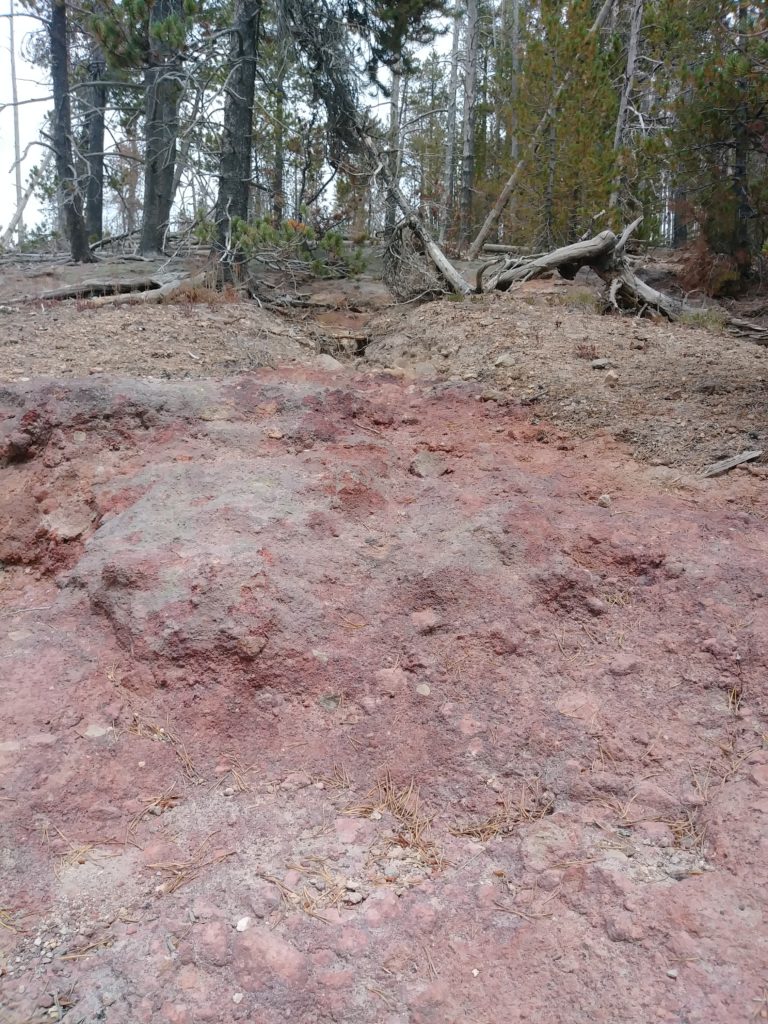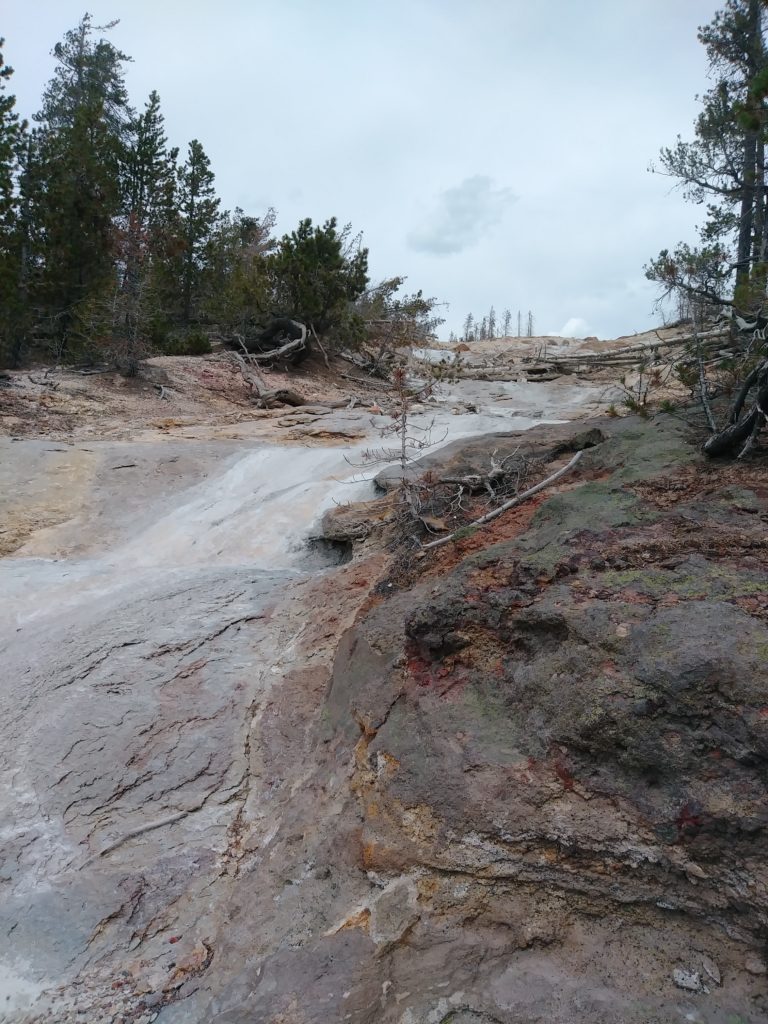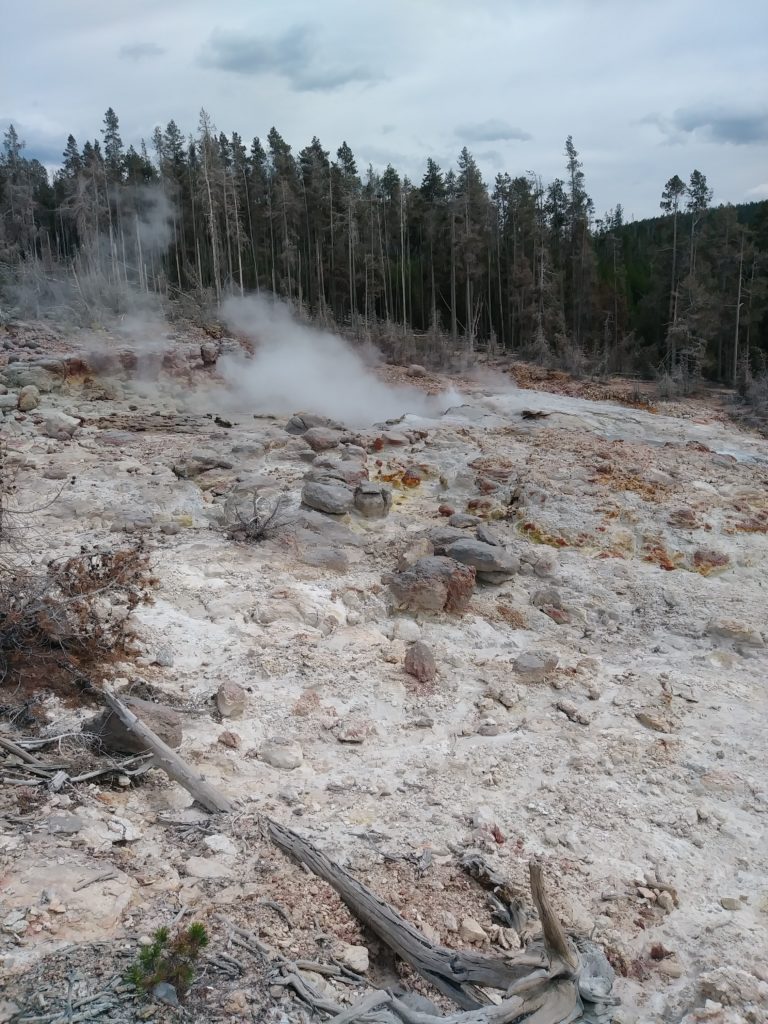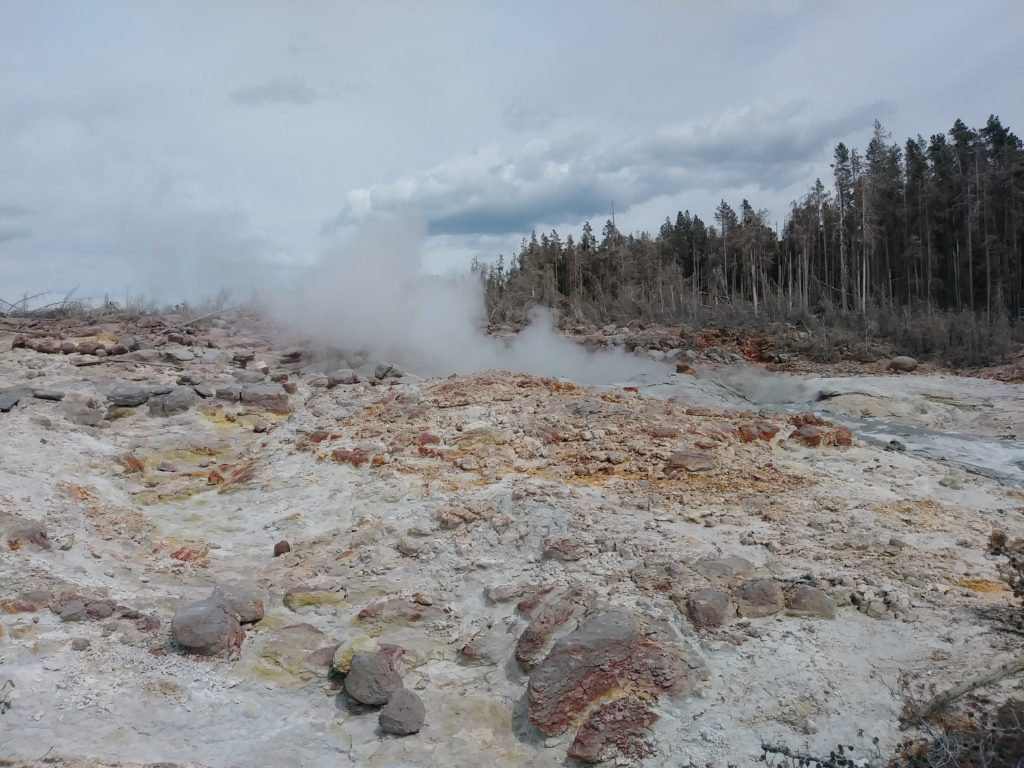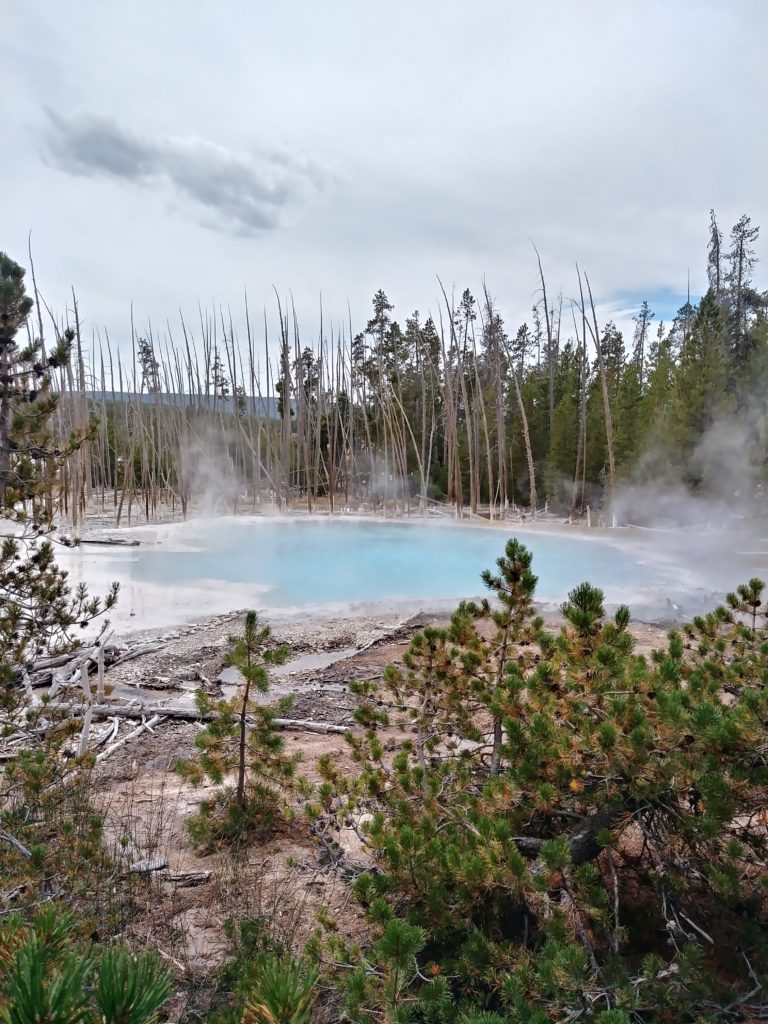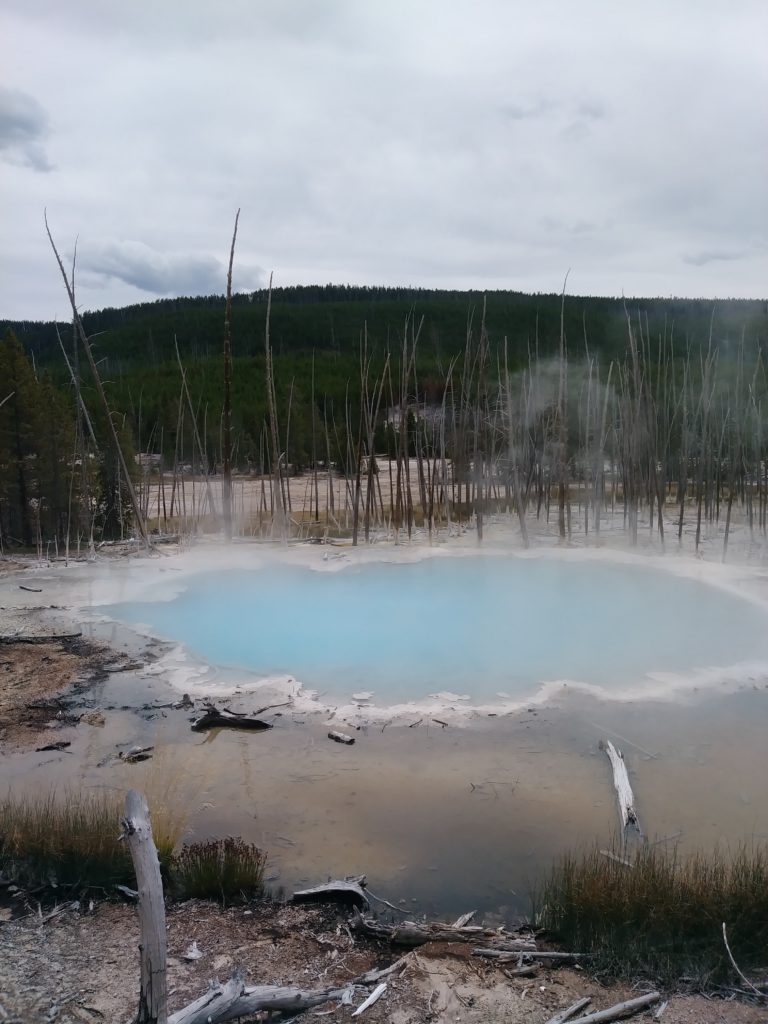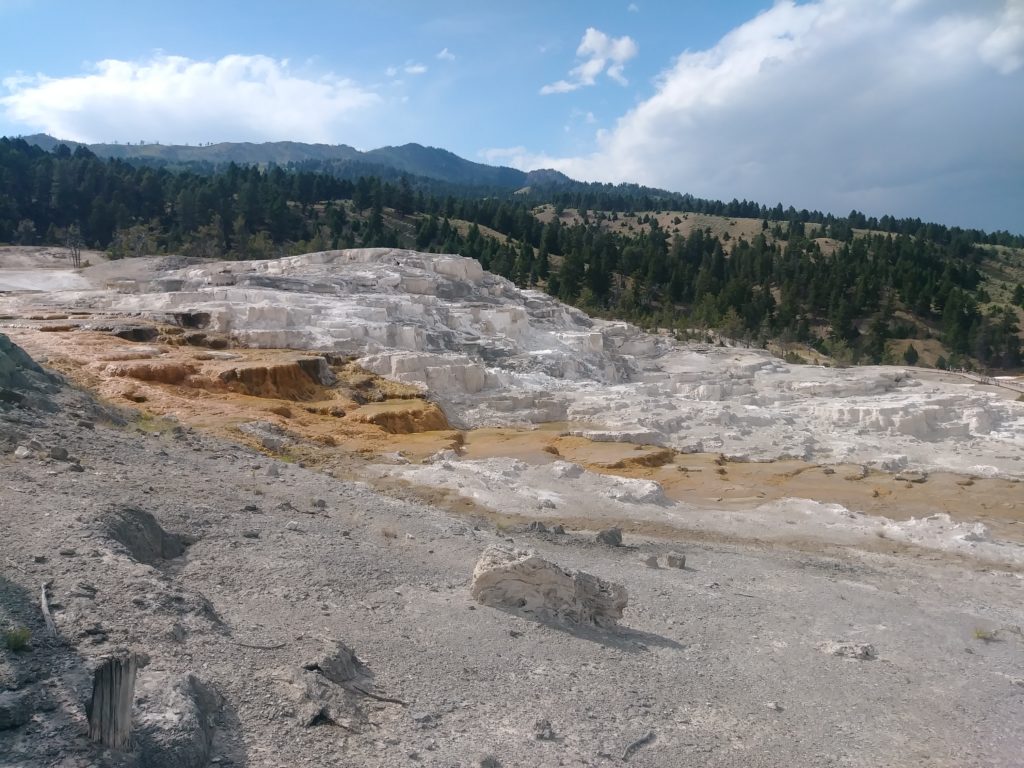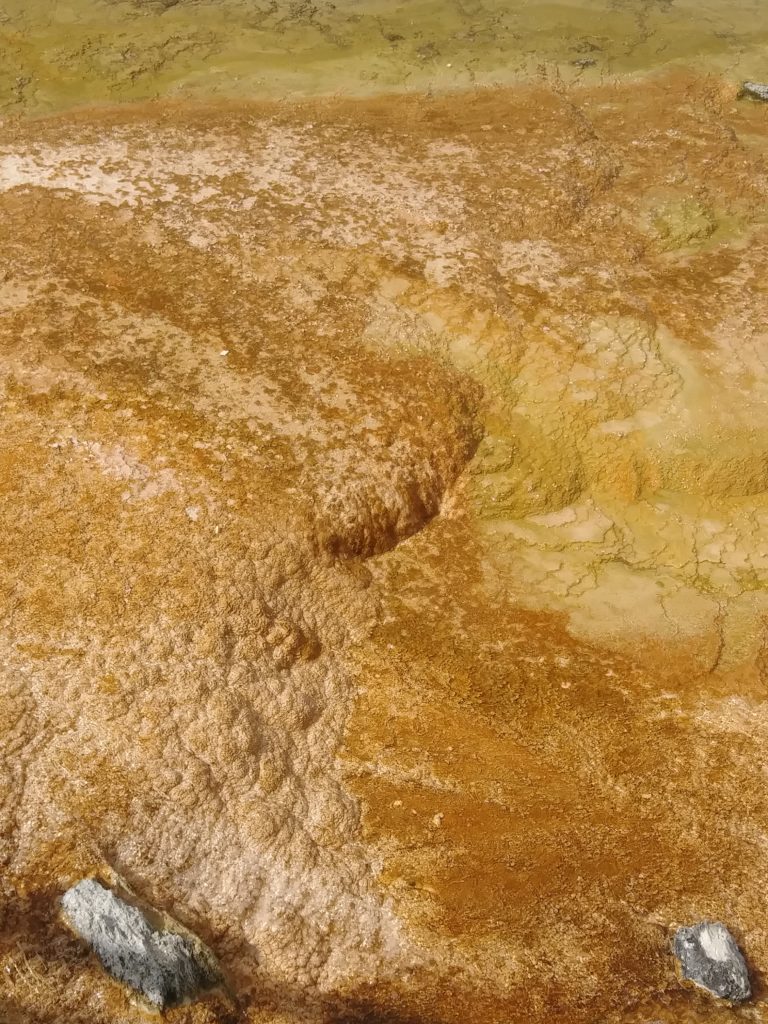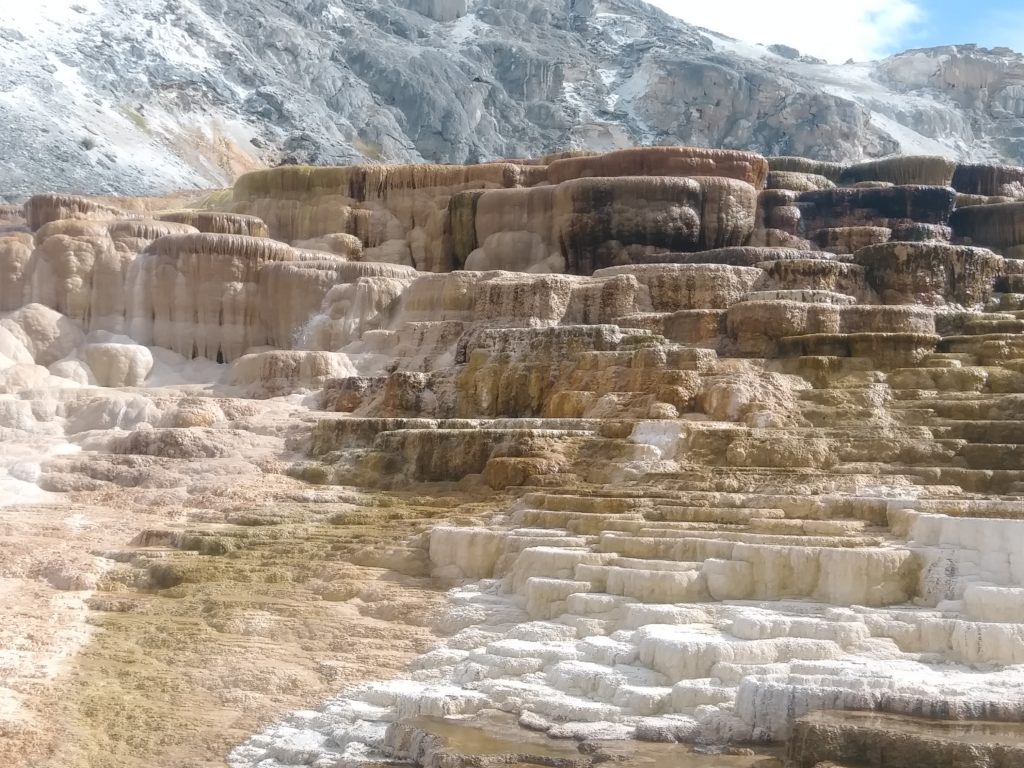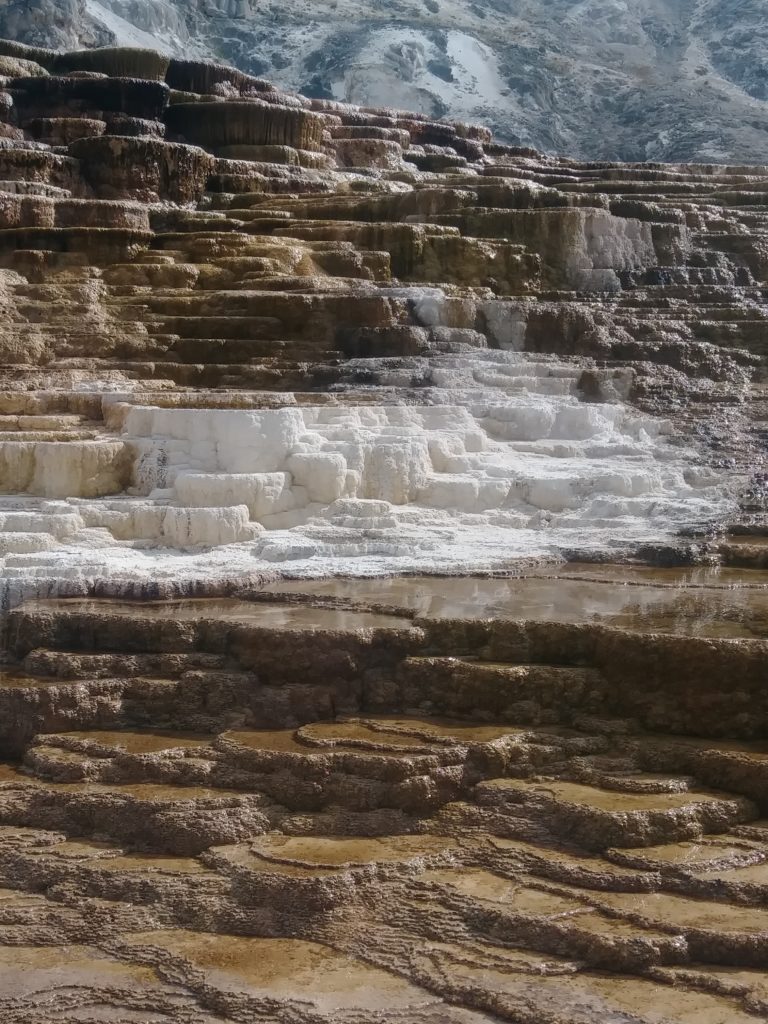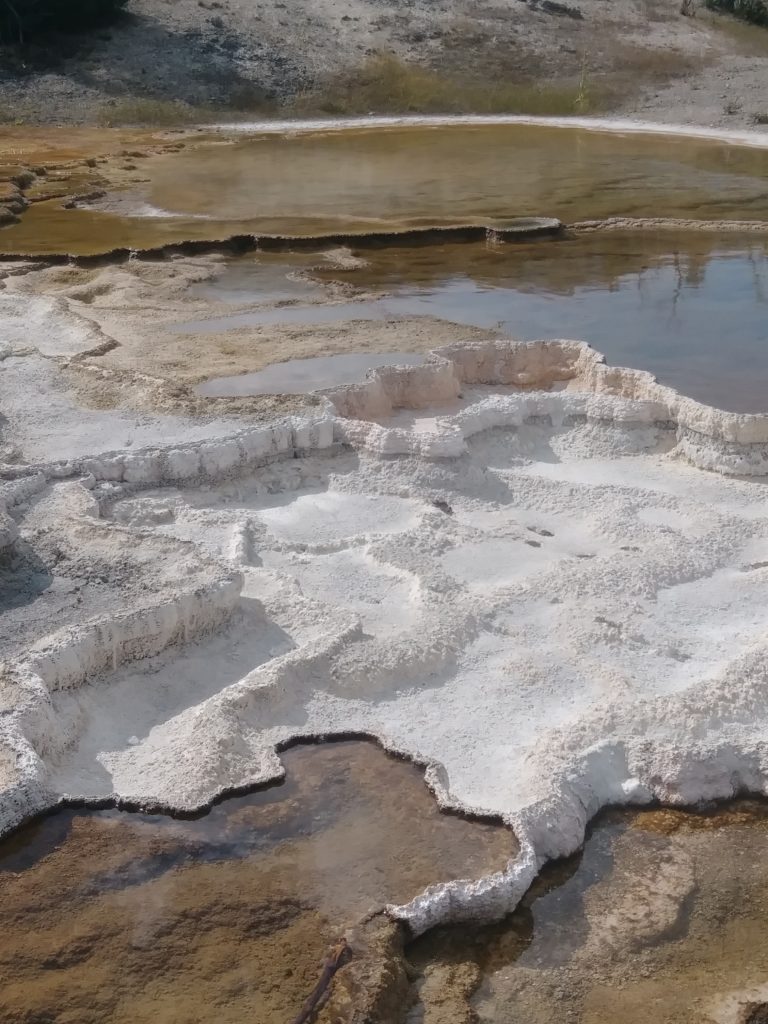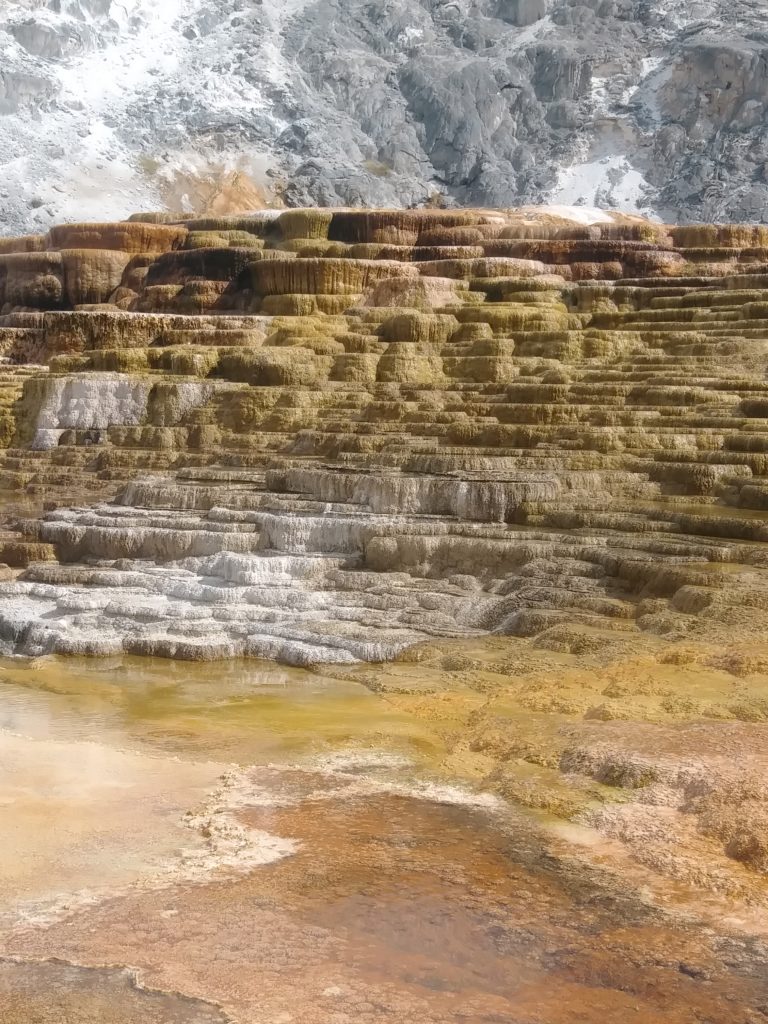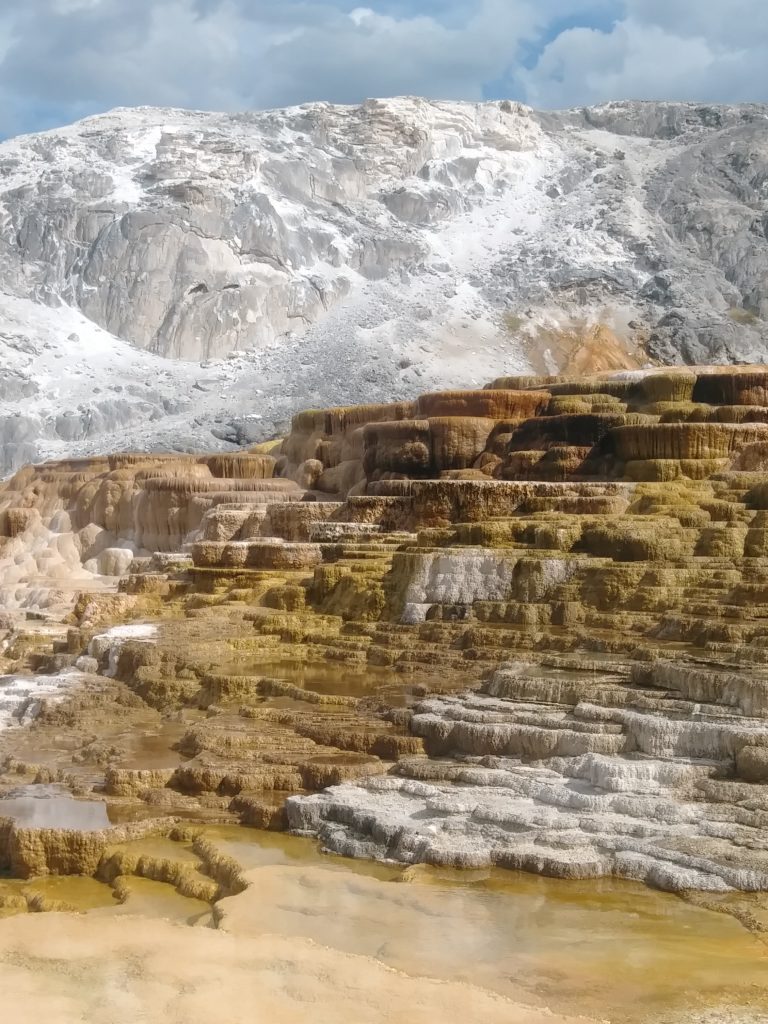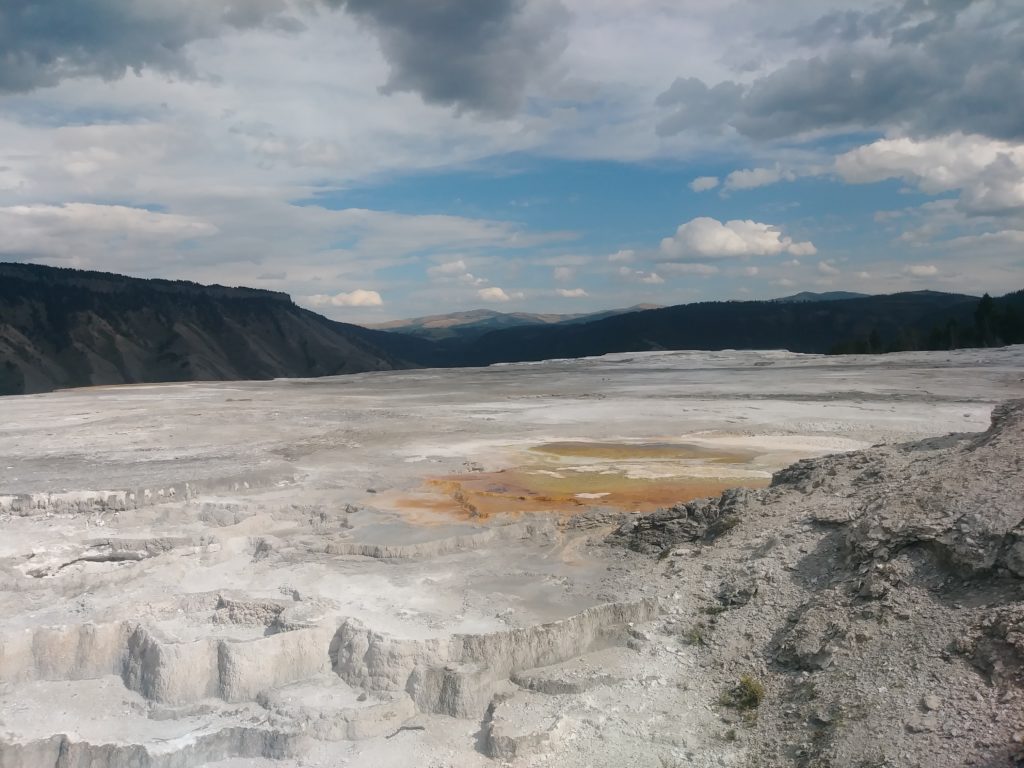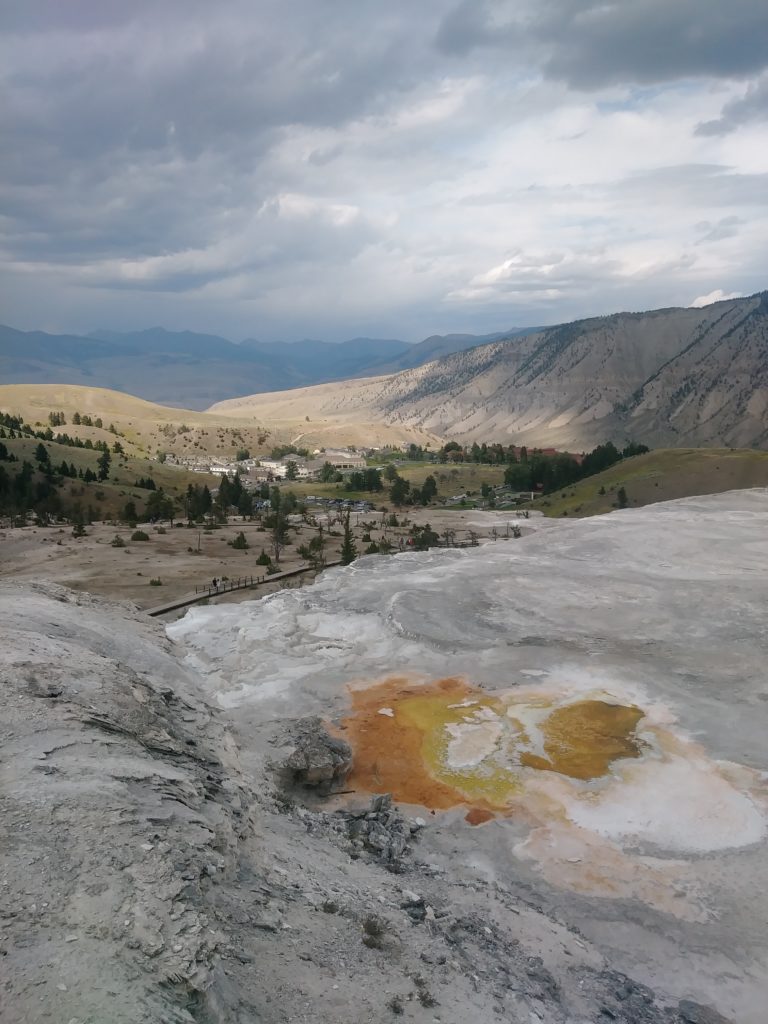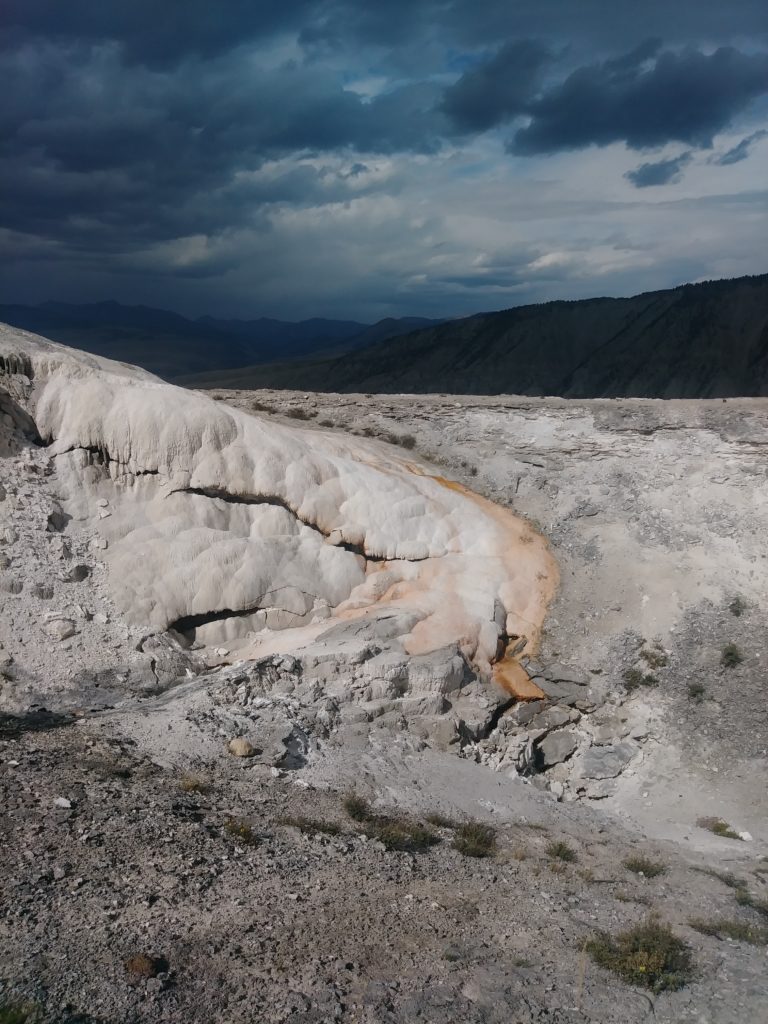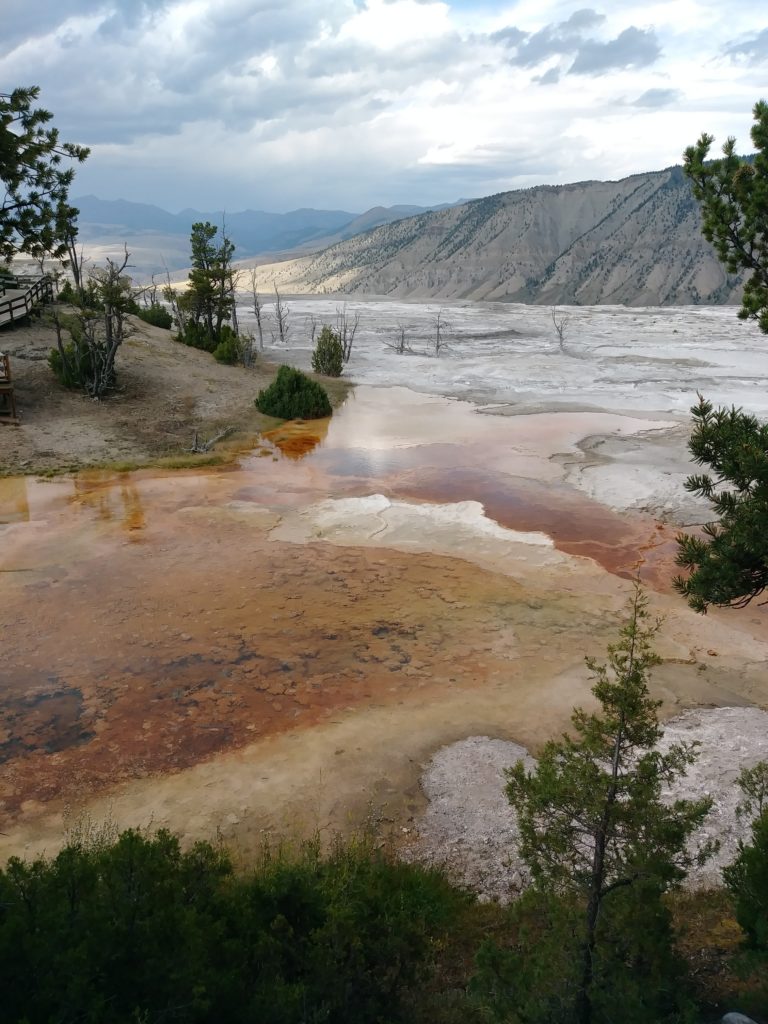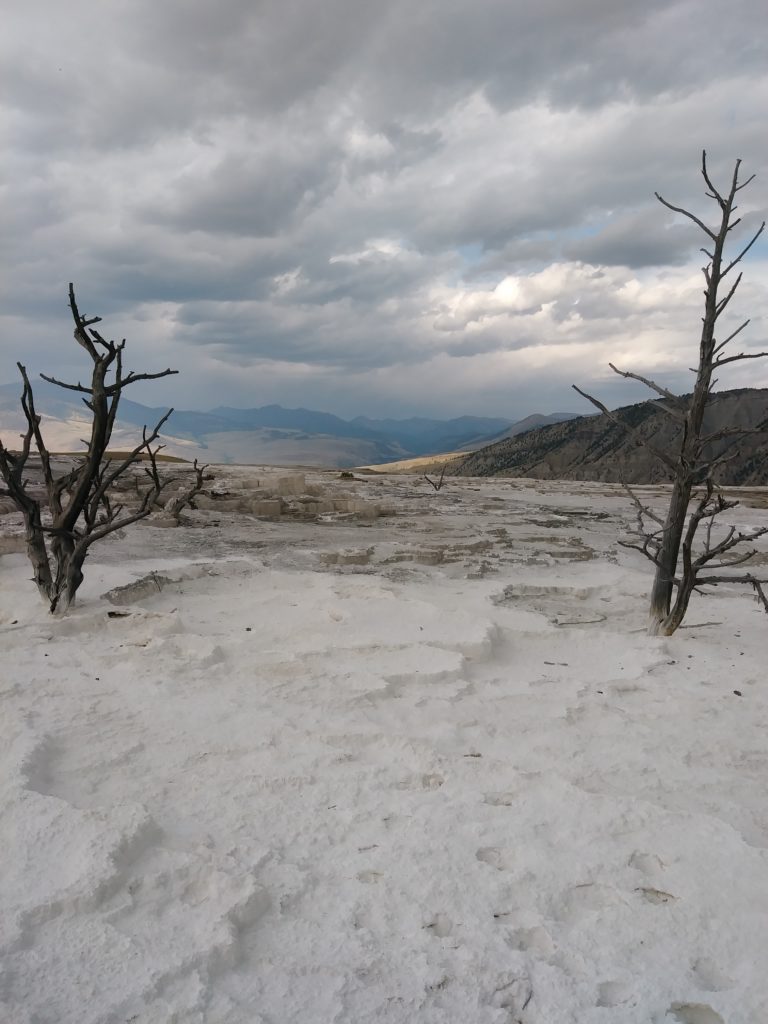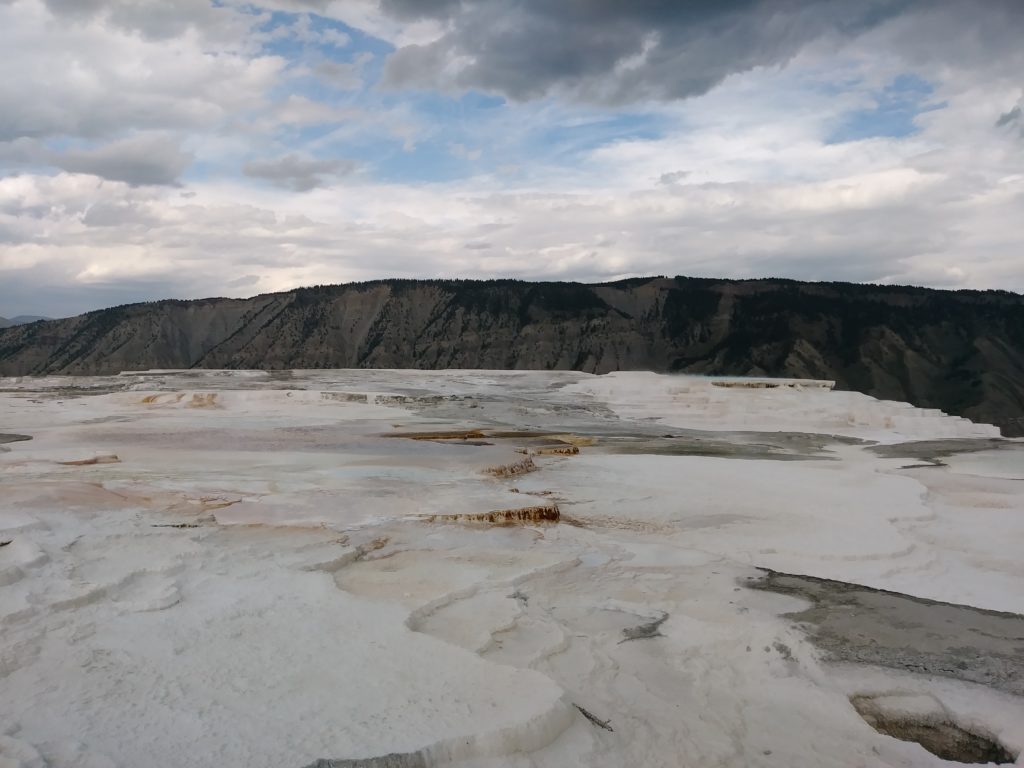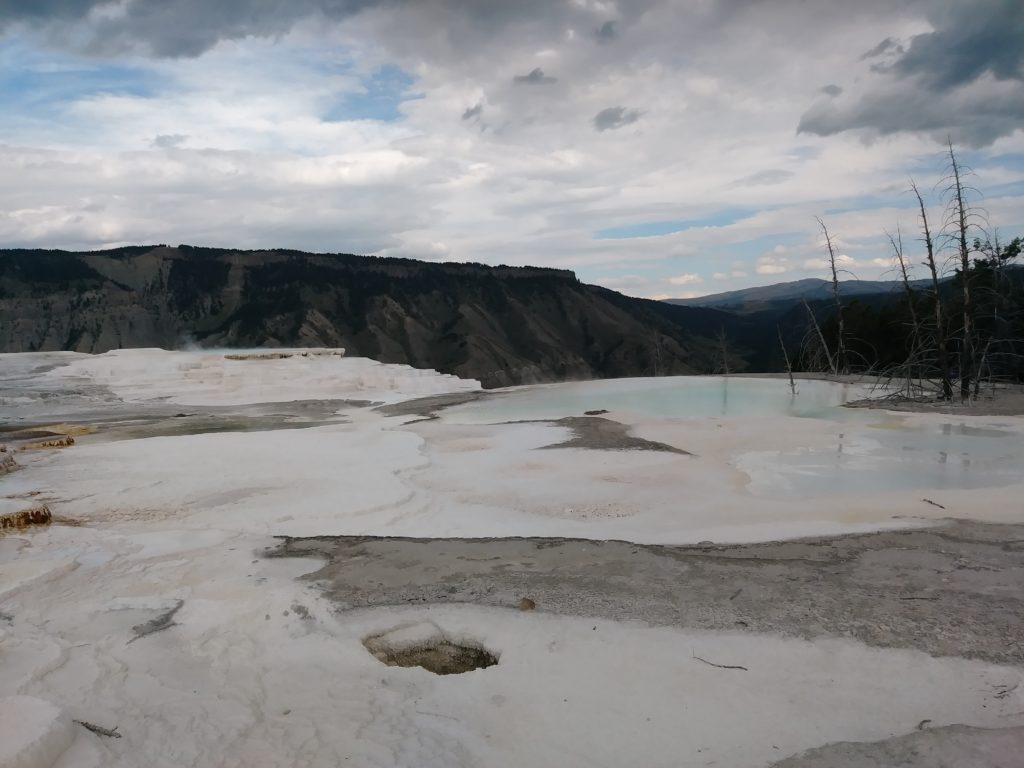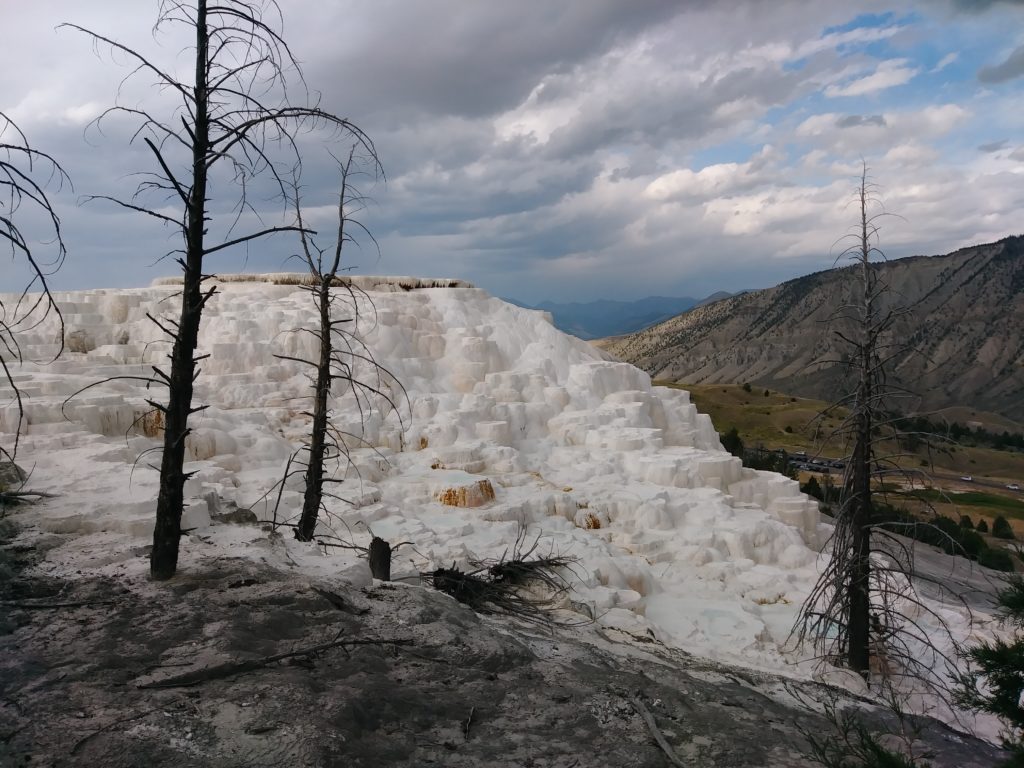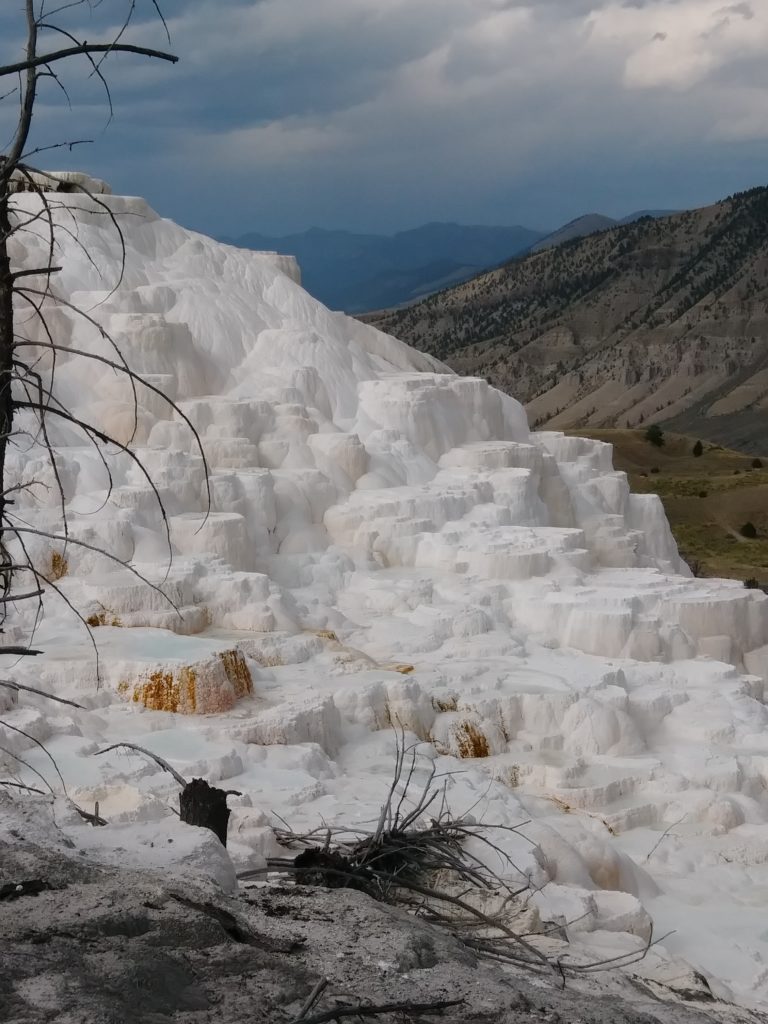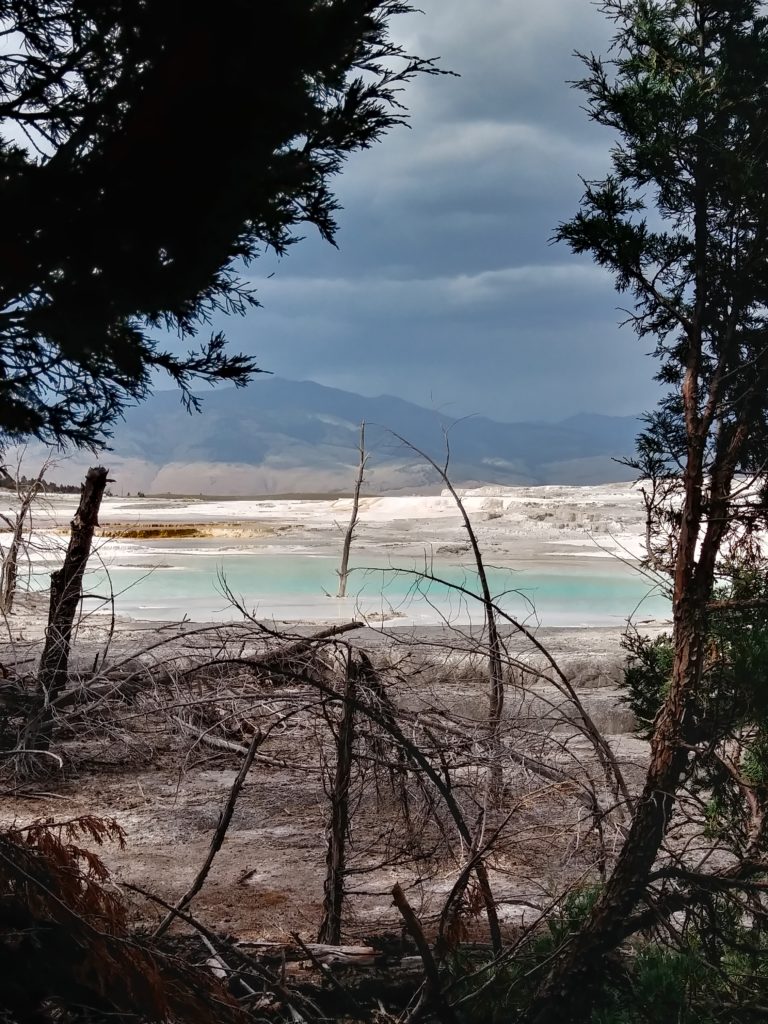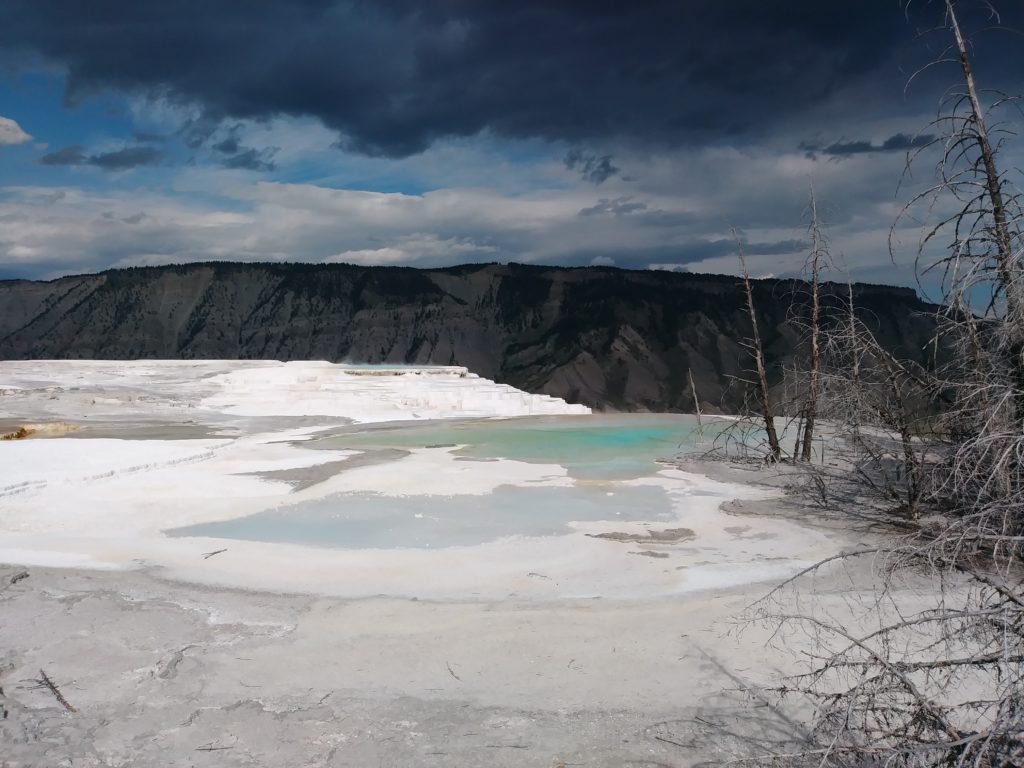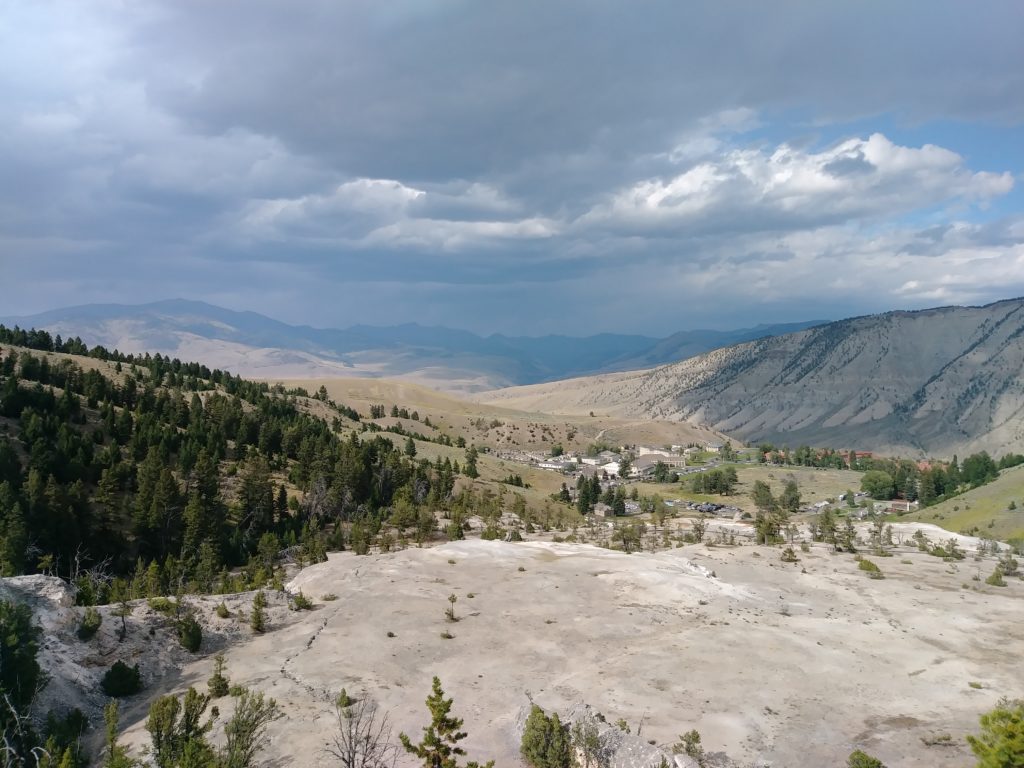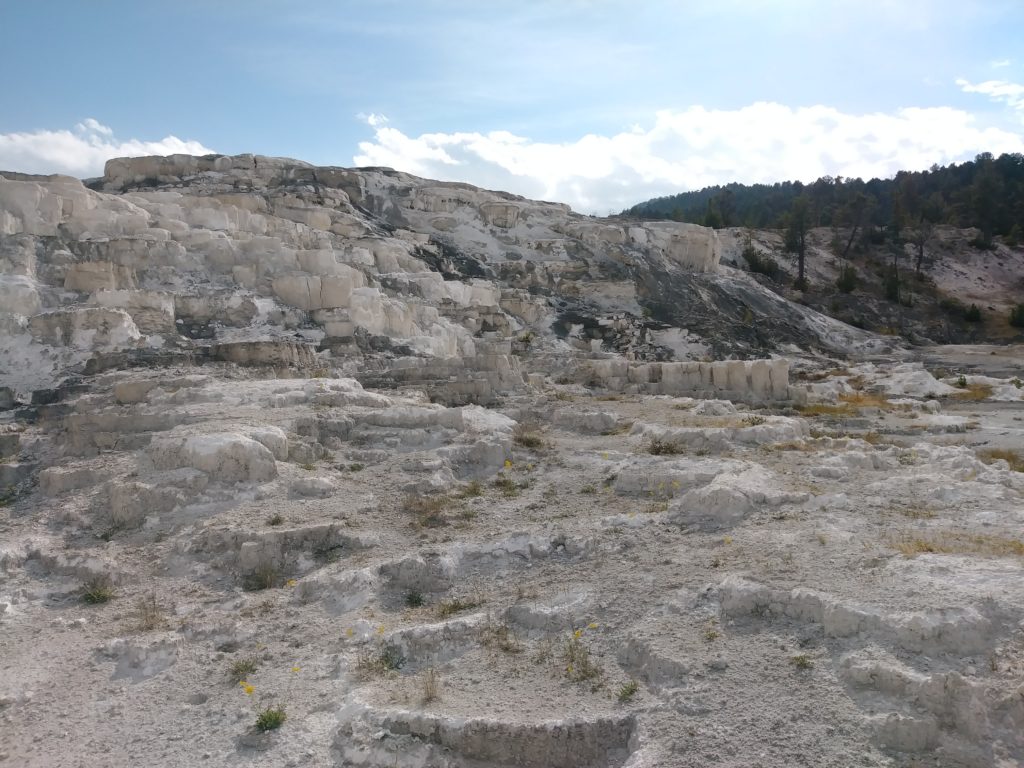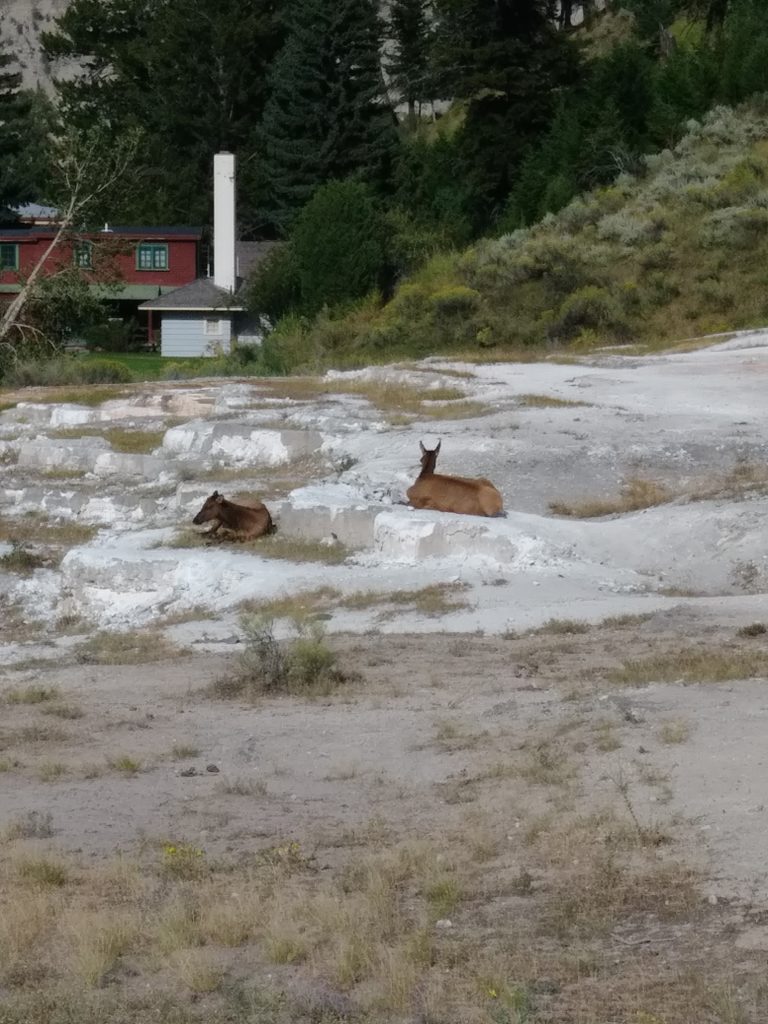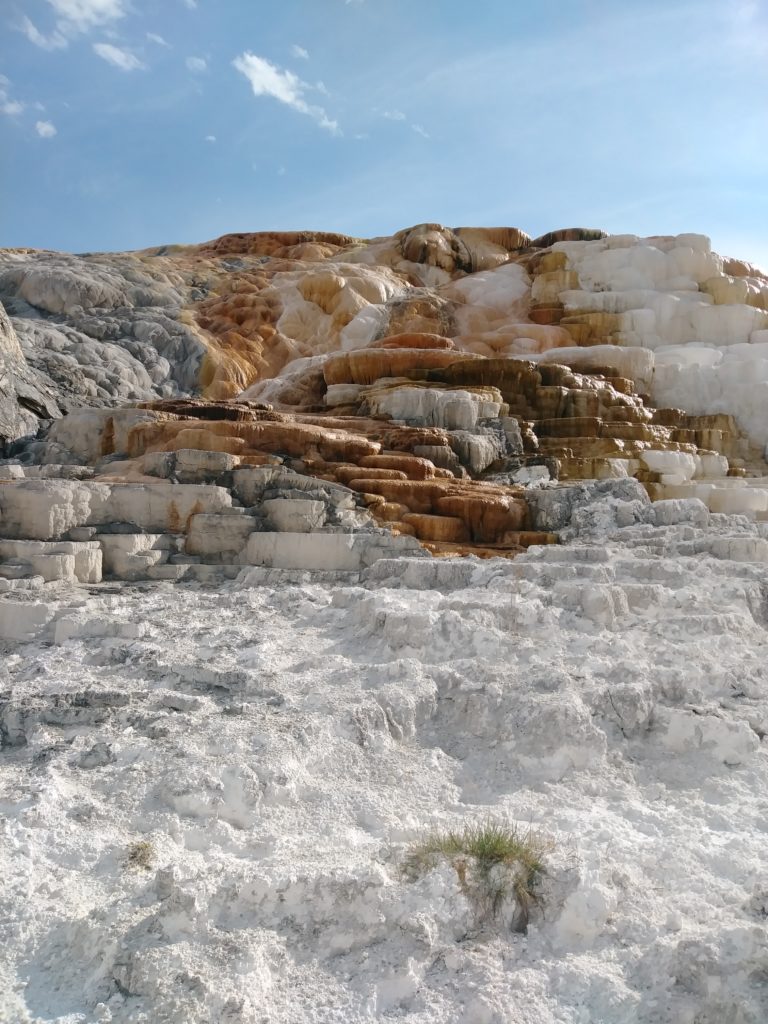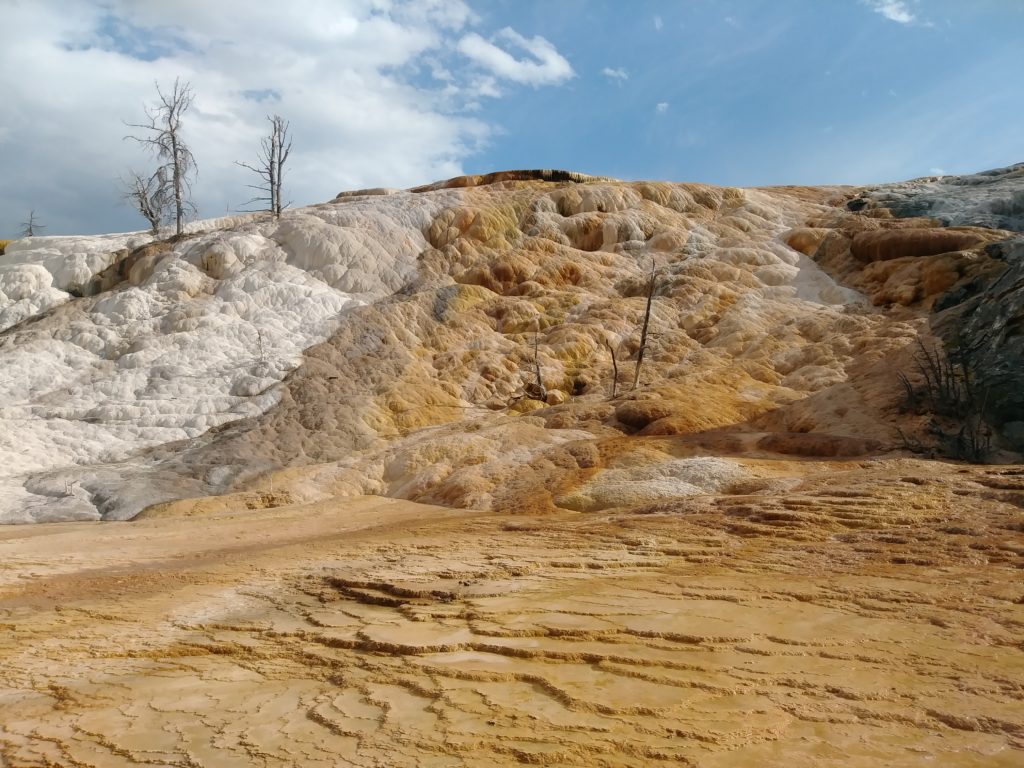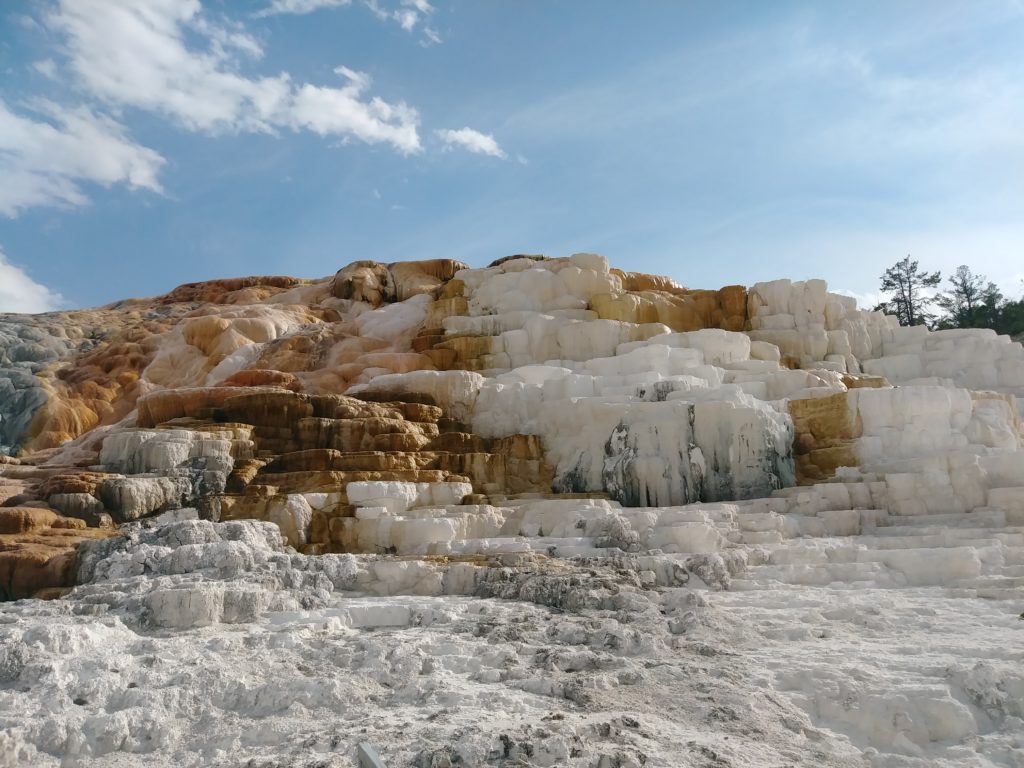Hello, my lovelies!
I have emerged! Huzzah! I was obliged to endure a fast from the internet, cell service, and civilization in general whilst in Yellowstone National Park.
Have I got loads to tell you.
Also, I seem to have taken approximately 1,000 pictures; I’ll endeavor to present the best of those and no more.
Bloody hell, do I need a shower.
Or five.
Week 1, Base camp: Canyon Village
The odyssey begins
I do believe that I left off in Cody, WY, where I was updating you beautiful, blog-reading creatures from Rawhide Coffee Co., who supplied me dosages of caffeine large enough that they should probably have been illegal.
I was rather fond of Cody, and of Rawhide, and of Majestic Lube whose oil change dramatically increased Parker’s gas mileage. Cody is named after Buffalo Bill Cody, and hosts the Cody Stampede (that’s a rodeo, if you were wondering). You walk down the main street, and looming right over you to the west are blue-purple, rugged, sage-covered, rocky hills. They aren’t distant- they’re right there. You really do feel as if you’re on the verge of plunging into an adventure in the wilderness.
Cody was by far my favorite of the towns that live just outside the entrances of Yellowstone.
By the time I had resupplied at the local Walmartians and gotten underway for Yellowstone, it was late in the day. I had two hours of driving left- challenging driving, though with delightful scenery.
The approach to the East Entrance of Yellowstone National Park from Cody takes you first through Buffalo Bill State Park , which appears to be dominated by a giant reservoir (Buffalo Bill Reservoir- sensing a theme yet?). The reservoir is large and beautiful, nestled among the rocky hills. You drive through three tunnels to reach the reservoir, two of them short, the third quite long and thrilling- the walls are the bare, blasted rock of the mountain.
Now, after one drives through the state park for a while, one naturally thinks one ought to be near Yellowstone.
One is not.
After the state park comes Shoshone National Forest. The road follows the Shoshone River, and, had I only been riding a horse, I would have fancied myself in the middle of a western. The river- the rugged hills- the sagebrush- the sparse trees on the riverbanks…. beautiful.
Also, a bit annoying when one is tired and wants to pitch the tent already.
Yellowstone is entirely too enthusiastic about being the USA’s first national park.
Once through the East Entrance, the fun driving is only beginning. There’s a sheer drop on one side, and a rock face of the mountain on the other side. You’re climbing for absolute ages- twisty curves, steep inclines… eventually the drive levels out, and you start skirting Yellowstone Lake.
Every now and then, at this point, you smell sulphur. The first time I picked up on it, I wondered if I had perhaps forgotten to use up those eggs I bought last week.
Not a happy thought.
Yellowstone Lake is huge. Its elevation is 7,732 feet, the largest high-elevation lake [a category defined as lakes over 7,000 feet] in North America. The lake, which eventually drains into the Atlantic via the Yellowstone River, has the largest population of wild cutthroat trout (I have questions about that name) in North America.
Not a terribly interesting fact, until you learn that this fishie generally only lives in waters that drain into the Pacific. There it is, swimming about in a lake that goes to the Atlantic. The working hypothesis is that Yellowstone Lake used to drain the other direction, to the other ocean. (source)
I find this extremely whacky.
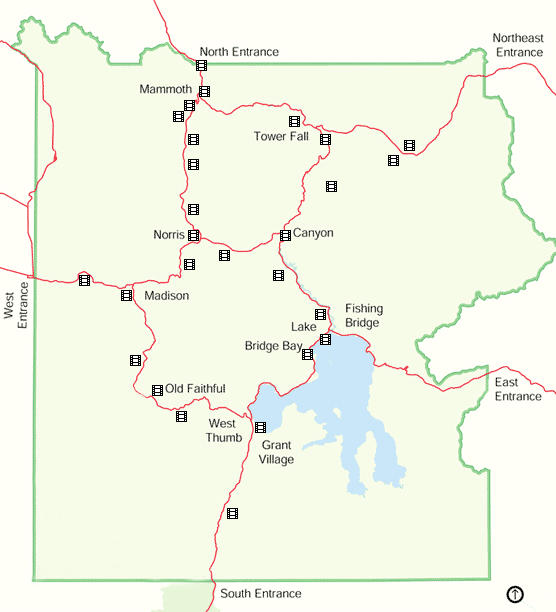
I was headed for the campground at Canyon Village, so my route left the shores of Yellowstone Lake and followed Yellowstone River up Hayden Valley. (Named after Ferdinand Hayden, who led an expedition to Yellowstone in 1871. It’s a sub-alpine meadow, formerly part of the lakebed of Yellowstone Lake, which is not as large as it once was.) There, even after 19:00 hours, tourists were clogging up everything and behaving in perfectly irrational fashion- slowing down, hanging out car windows with cameras, half pulling off the road, generally making nuisances of themselves unnecessarily- desperate for glimpses of the tasty critters like bison and elk that come out to graze at dusk.
I do not have natural reserves of patience for dealing with this type of foolishness.
After observing this behavior, I began packing snacks and treating this lunacy as live theater. It was a surprisingly effective coping mechanism that, with slight modifications, worked very well for when I was sitting in construction traffic in other parts of the park.
Anyways, at the campground, I dutifully packed all my food and toiletries in the provided bear box. There was a laundromat, and I gleefully made use of it.
It seems a little strange to experience such delight over doing one’s laundry. But my laundry smelled.
The laundromats were open, but the pay-by-the-minute showers were closed due to the plague. Having spent the previous week with no shower access, either, this was a heavy blow.
I grimly accepted that it was my fate to join the great unwashed masses. Going on a Great Trek requires a variety of sacrifices. Personal hygiene, alas, is one of them.
Ystone conditions
So, Yellowstone. It’s immense- vast- it abounds with wonders. It’s profoundly disturbing. The drive in alone impressed upon me just how massive the place is- the scale of the lake, of the mountains, of the freaking animals wandering about. (The park is 3,500 sq.mi.)
Conditions summary: marginally hospitable to human life.
Temperatures ranged between 30°-45°F at night and about 72°-83°F daytime during my stay. You could experience the full range of those daytime temperatures within an hour if you made a significant change in elevation.
The respective elevations of the two places I camped were 7,900 feet and 7,800 feet above sea level. That is just below the elevation where altitude sickness is most likely to occur (8,000 feet, the threshold for “high altitude” classification). Remember when I was going on about having hiked up Black Elk Peak? That was 7,200 feet, more or less.
So, while the Black Hills were a good preparation, I still immediately noticed the change in elevation in Yellowstone when I went running my first morning there. Generally speaking, the first week, I tired too quickly when I was really exerting myself- running uphill or tackling a sharp incline while hiking. I think it took most of my first week there to sort through that.
I started my Ystone experience properly, my first full day. No, I don’t mean by rising early and running whilst it was still 40°F. I mean what I did immediately after that.
I went and washed my hair in the campground’s dishwashing sink.
Did you know it’s possible to get a brain freeze from the outside?!
The air temperature was still in the forties. I shudder to guess what the water temperature was, except for damn well colder than that.
I made a further unamusing discovery that, at those temperatures, shampoo (but, strangely, not conditioner) turns into a semi-solid slime that must be warmed with your rapidly diminishing body heat before it will adhere and spread in your hair.
I suffered for my luscious locks, my lovelies. But there’s no way to get one’s hair clean with baby wipes or alcohol pads, so there we are.
In hindsight, a little dry shampoo might have gone a long, long ways on this trip.
Right. That was just the excitement prior to 9:00. After that, I started hiking in Ystone.
The Grand Canyon of Yellowstone
Armed with numerous maps and loaded with newly purchased bearspray, I went off to hike and see the sights.
Bearspray. Litteral industrial strength pepper spray, and they sold it to me- strongly suggested I buy it, in fact- me, one of the most eagerly destructive agents of chaos and mayhem that the world has ever known. Ah, capitalism is a beautiful thing.
As you may have guessed from the name, my campground was near the Grand Canyon of Yellowstone, so I began my explorations in that area on my first day. This was what impressed upon me that the vibe/energy of Yellowstone is disturbed; the place made me uneasy. Yellowstone just smells- sometimes the lodgepole pines all but overcome it, and the meadows usually mask it with their own sharp, borderline unpleasant smell. But there’s no getting around it: the smell of sulphur and burnt yuck is a constant reminder that you’re actually on a giant hellhole.
All due respect to Joss Whedon (and there may in fact be a Hellmouth in Cleveland, and have used to be one in Sunnydale), but if there’s a Hellmouth anywhere on Earth, it’s here.
There are over a thousand miles of trails in Yellowstone. I spent two weeks there and never even scratched the surface.
[PSA: The day hike handouts for each area of Ystone that the rangers give out are of varying helpfulness and quality. For example, the one for Old Faithful area wasn’t bad, but the one for the Canyon area absolutely sucked balls. Maps posted at trailhead parking lots tend to be far more accurate and useful, and, of course there’s nothing like paying $15 for a waterproof map that can actually get you where you want to go.]
Wapiti Trail
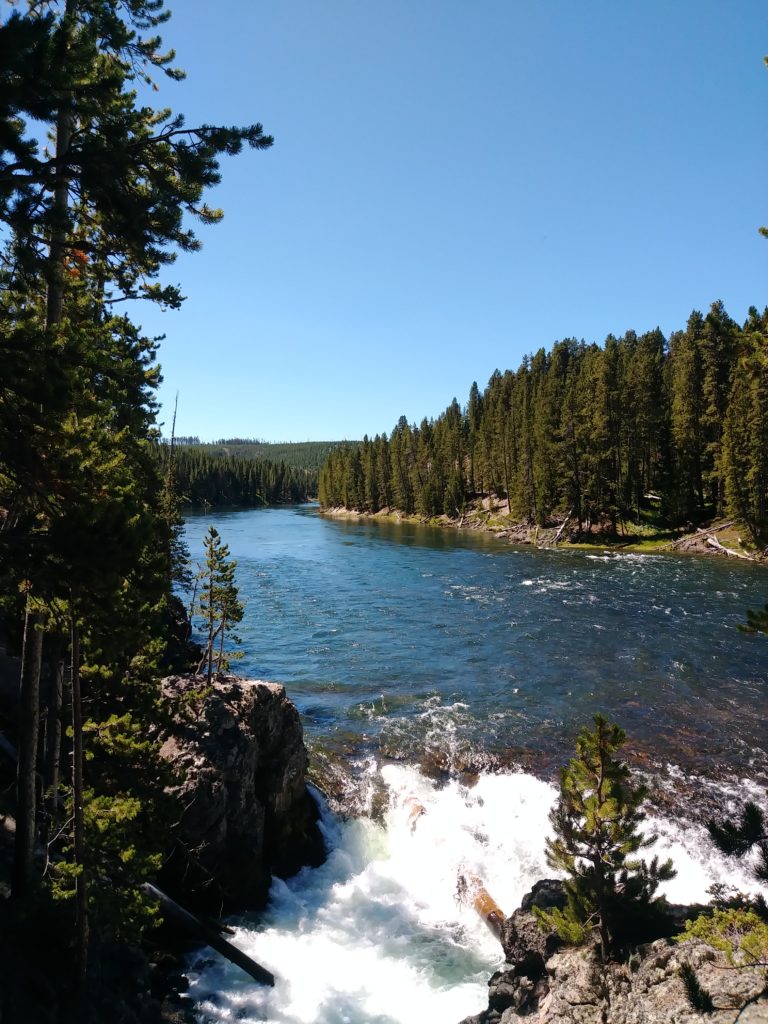
Due to the map difficulties that I got sorted out by the end of the day, I wound up taking my first hike on Wapiti Trail- not one that makes the guidebooks as a must see. But then, I was on an adventure, a Great Trek, in fact, and part of venturing out on one of those is to see a path, not know where the hell it winds up, and to go out on it.
Speaking of hell.
To start, there were strong Sound of Music vibes, with the meadows and the dark green mountains in the distance, and a generally vaguely alpine feeling.
Off I tramped to Clear Lake.
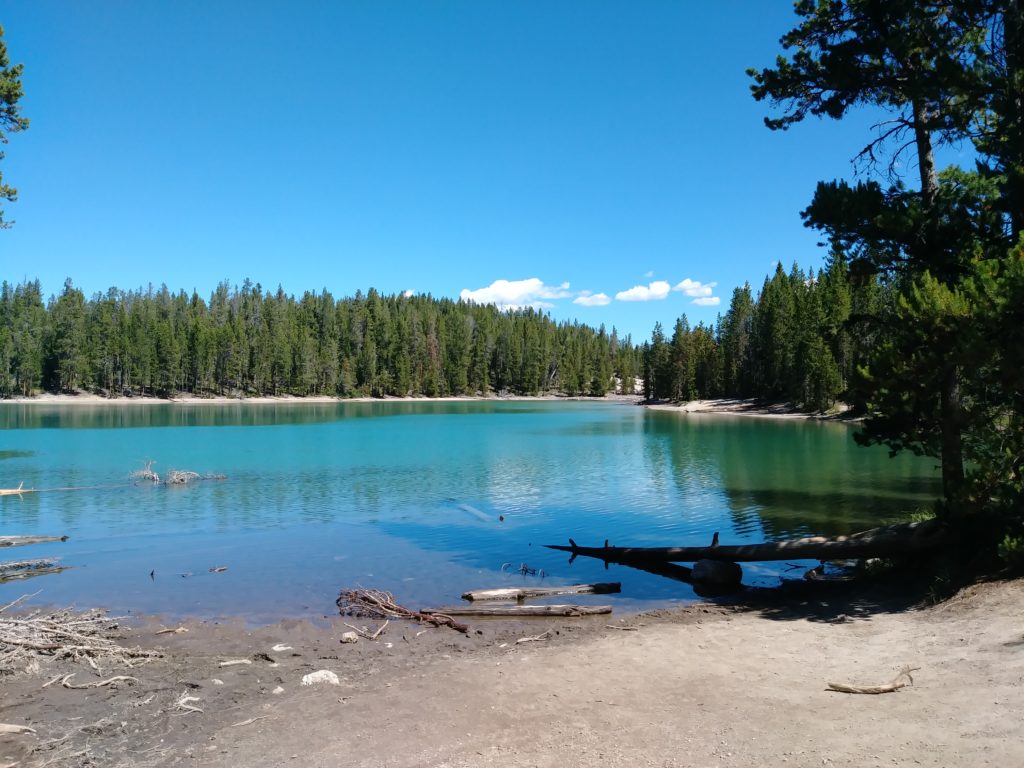
See how gorgeous that looks in the picture? But it has an unwholesome odor to it, which should have been my first clue that this was not going to be some soothing ramble in the woods, and instead was going to scar me for life.
I could have turned around there, but that’s not my style. I pushed ahead, and suddenly it’s a smoking wasteland, terribly noisome; I had absolutely zero inclination to snack for the rest of the hike.
There were fissures making evil gurgling and hissing noises as steam poured out of them. There was a sickly mudpit that bubbled threateningly. The bleached rocks and gravel and sand- it was exactly as I imagined hell would be, except with trees. It doesn’t take much of a flight of fancy to imagine evil spirits lurking in those pits, and issuing from them. I felt like I was wandering some nightmare hellscape, searching for Lucifer- had the urge to call out for him, but the dread suspicion he’d actually appear if I did, not least of all because it was suddenly so hot, out in those super reflective rocks. Plus, the smell.
Well, you hurry through that and get back into the forest. I was so grateful for the scent of trees and their healthier energy- but even these struggle to grow in such an unfriendly place. The forest floor is carpeted with the lodgepole pines that’ve tapped out; the ones that only half fall to the ground, and instead get hung up on their living brethen, give unnerving groans every time the wind stirs them. The streams were so noisome and mephitic that I positively refused to get my boots wet when I crossed. I was afraid the soles would get eaten off by acid or something.
(Actually a legitimate concern, as I would learn in a day or so.)
There’s a reason this isn’t a place they send the tourists. The geothermal features I’d explore later in my stay had living critters classing them up- thermophiles that added a splash of gaudy color- and much more water, collected in pretty pools or jetting out of geysers. This area almost entirely lacked those. It was dry. It reeked. It unnerved me.
Unwholesome, unsettling, disturbing: that’s the initial impression Yellowstone made on me. Even once you escaped back into the forest, you’d come upon pockets of ash and geothermal activity, or streams so sluggish and foul smelling that I was very careful to cross without getting my boots wet.
The meadows were no better, with their acrid, sharp smell, and every now and then the white bones of elk and bison providing a reminder that there are plenty of things willing to eat the meat off your bones if you aren’t careful here.
The thing that made me most uneasy about Yellowstone is that there are never any birds singing. In fact, there are almost never any birds at all- for two weeks, I only saw a few on the lake, one sweetie at Mammoth Hot Springs (pictured below), a handful of hawks, and a poor birdie being dissolved in the mephitic waters of an acidic hydrothermal feature.
There is actual sulphuric acid in those things, okay?
Yeesh.
South Rim
Whew.
Deep breath. Let’s not panic that I’d taken a wrong turn into Dante’s Inferno just yet.
For anyone who has visited the real Grand Canyon in Arizona, it’ll strike you as a bit pretentious that they just copied the name instead of figuring out something else to call the big canyon in Yellowstone.
There were a number of trail closures [on both the North and South Rims] that (mostly) prevented me from going down to the canyon floor and seeing the falls at eye-level. Still, there’s plenty to see from the rim.
I covered the South Rim out to Artist’s Point, and, I have to say, Artist’s Point isn’t any better than any other lookout along the trail. Big deal over nothing.
The Yellowstone River is grand and rushing; the two waterfalls (upper and lower) are majestic. Still, you can’t escape the smell. My clothes stank. My truck stank. I was reminded of one of my favorite memes of all time:

Except, of course, that there was no Google Maps to be had in Ystone, because I didn’t have a stupid cell signal.
North Rim
I took a much more relaxed approach to the North Rim of Ystone’s Grand Canyon, the initial surge of arrival adrenaline having worn off and left my brain once again (semi-)functional.
By my second full day in Ystone, I realized I’d have to take notes on paper during my stay. Electrical outlets when tenting in Ystone are bit like moose: exists somewhere, but good luck spotting it. So I sat on a handy rock on the rim, at a certain point, and wrote, and soaked in the view.
“As I sit on the rocks on this overlook, beautiful as it is looking at the canyon and hearing the falls, I am buffeted by the chilly wind (cold when the sun hides behind the clouds); and the word that springs to mind for Ystone is mephitic.”
Like the South Rim, the North Rim was an easy walk, some parts of it paved. The only exception was the Brink of the Lower Falls- easy enough to get down, somewhat less so to get back up.
I went all the way out to Inspiration Point, and that last leg of the trail was lovely- a narrow path along the rim, surrounded by what were the healthiest trees I had yet had the pleasure of walking among in Yellowstone.
It’s always the neighbors
My right-hand neighbors were a delightful group: polite, friendly, offered me a martini with extra olives. Didn’t care a bit that they were up late having fun.
My left-hand neighbor set off my finely-honed instincts the minute he opened his mouth. Actually, before then. Entitled Colorado douchebag. Called it correctly just by looking at him. Didn’t catch his name… Chad? Brad? Brody? Let’s go with Brody.
Brody was a fascinating study, though. I observed him employing his ingratiating methods with great interest (and with great relief that I’d squashed his attempt to employ them with me- it’d be terrible to endure the company of such an individual for more than a minute). I spoke one word to Brody, and it stopped him in his tracks. His other neighbors were taken in, though, and they couldn’t shake his clingy ass until they decamped. Reminded me of nothing so much as a con artist, except there was no con- he just couldn’t leave other people alone. Absolutely fascinating.
Everything was expensive inside the park, not unsurprisingly. Firewood was $8 a box (yes, it comes in boxes in that part of the USA). Gas was $2.59 a gallon.
Of course, I’d stocked up at the Walmartians’ in Cody, and I managed to not buy a drop of gas within the park boundaries- Parker really did get fantastic mileage after her oil change.
My next explorations took me to hydrothermal areas more commonly frequented by tourists.
Norris Geyser Basin
I loved it here. There was much more water and color than at the geothermal features I’d seen along the Wapiti Trail. The smell wasn’t quite so bad- perhaps I was growing accustomed to it, or these were simply less noxious. There was a brisk breeze the whole day, too, and I suppose that helped.
The Norris Geyser Basin is Yellowstone’s hottest geyser basin. It has two parts to it: Porcelain Basin and Back Basin.
Lime green pools and orange bubbling water- you don’t see that every day.
Let’s take brief minute to go over some helpful terms. Some writers differentiate between geothermal features (something involving heat from within the earth) and the subset of hydrothermal features (something involving heat from within the earth, plus water). Also useful for us:
- Hot springs: pools of hydrothermally heated water
- Geysers: Hot springs with constrictions in their underground plumbing, which causes them to periodically erupt to release the pressure that builds up.
- Mudpots: Hot springs that are acidic enough to dissolve the surrounding rock, and typically also lack water in their systems.
- Travertine terraces: Hot springs that rise up through limestone, dissolve the calcium carbonate, and deposit the calcite that makes the travertine terraces. (Mammoth Hot Springs, below, are examples)
- Fumaroles: These hot features, also known as steam vents, lack water in their system, and instead constantly release hot steam.
—source, with expanded definitions and further information
Porcelain Basin is so named due to the cloudy blue color of its Porcelain Springs. This milky color comes from siliceous sinter (silica, more or less) that’s “brought to the surface by hot water and forms a sinter ‘sheet’ over this flat area as the water flows across the ground and the mineral settles out.
“This is the fastest changing area in Norris Geyser Basin, and siliceous sinter is one of the agents of change. If the mineral seals off a hot spring or geyser by accumulating in its vent, the hot pressurized water may flow underground to another weak area and blow through it.
“Siliceous sinter is also called geyserite. Deposits usually accumulate very slowly- less than one inch per century. Older sinter is gray in color, while the newest is white.”
I read the signs, okay? Sometimes they say interesting things.
Sometimes, they just list off rules that I completely ignore.
However, some of the signs had warnings that I took to heart, having no desire to die an ugly death just at that moment. The geyser basins in Ystone, pocked as they are by all manner of hydrothermal features, are accessible by boardwalks. The ground in these areas is dangerous for walking- apparently solid ground may simply be a thin crust over boiling water and steam and scalding mud.
Which do you suppose would kill a person first- suffocation in the mud, or having your skin boiled off? According to the warning signs, over 20 people have died and 100s have been disfigured by chemical and water burns.
That’s right- the crap in these pools can melt the soles right off your boots.
*shudders* My boots were far too expensive for that bullshit.
Now, the ground might be too dangerous to walk on, but that doesn’t mean the boardwalks were much better. The boardwalks of Ystone- rickety things, riddled with dry rot, acid holes burned into them, the odd board missing- cuz natural selection, bitches.
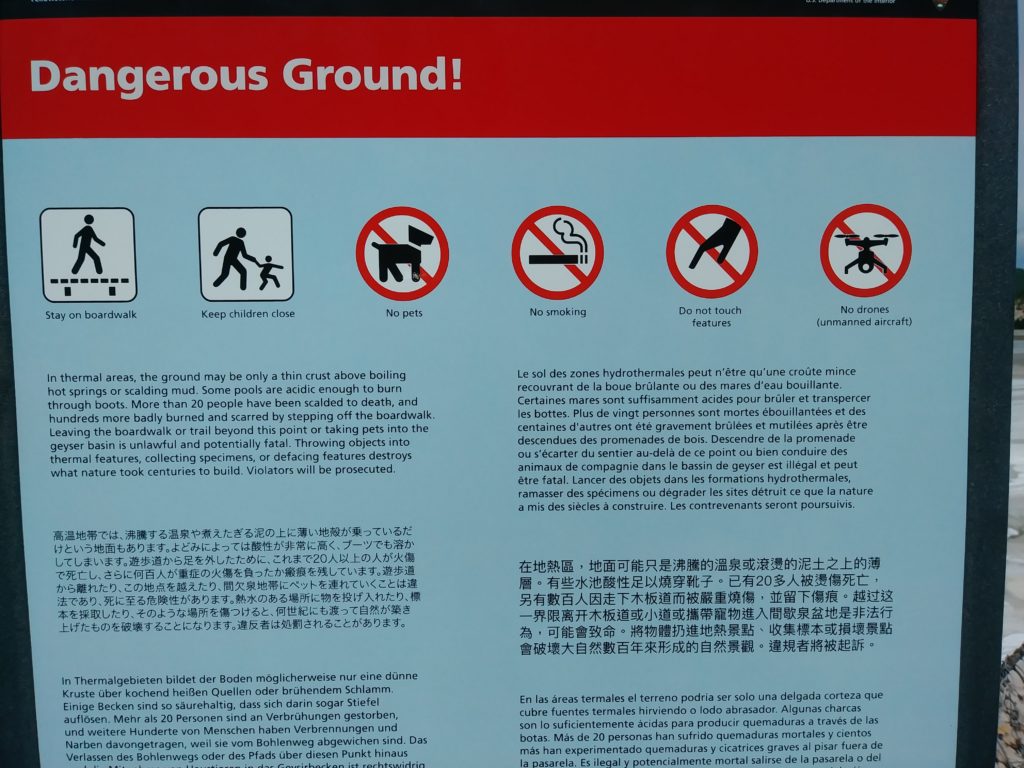
So you’re tramping about on rickety boardwalks to see things that can kill you.
Rather a bit like going to the zoo.
Back Basin is indeed in the back, and is a longer boardwalk. The features are more spread out here, but nonetheless worth investigating.
The Green Dragon Spring was one of my favorite sights in all of Yellowstone. It isn’t incredibly photogenic, but, in person, the deep green color is striking, and, you know, it comes out of a cave. What’s not to love?
Minute Geyser
Bit of a cautionary tale, here. The main road through Yellowstone used to pass within 70 feet of it. So many people threw rocks into it that the geyser went from erupting every minute at heights of 40-50 feet, to… this. The minerals have cemented the intruding rocks together, making their removal unfeasible.
Moral of story: human beings can be real asshats.
Do you see all these brilliant colors in the water? It’s caused by teeny tiny microorganisms called thermophiles who call these hellholes home. Bacteria and algae think the heat and acidity is just peachy. Scientists think that if there’s life elsewhere in our solar system, it probably resembles these hardy critters.
On a more mundane level, the particular shade of the thermophiles in each particular hydrothermal feature tells you exactly how hot it is. (More on that in the Old Faithful section below.)
In short, it was less overtly hellish, there… but, I’d be staring at a blue pool, realizing all I could see were the edges and then a sheer drop that must extend miles for the water to get that hot; or, I’d be standing, watching a bubbling spring and the wind would shift, and it was like the devil himself was breathing down the back of my neck- wet, warm, smelled like sulphur.
Now, parking is an issue at Norris Geyser Basin, for two reasons.
First, there are signs posted everywhere, warning that, should Steamboat Geyser erupt, what it flings into the air will, at the very minimum, eat through the paint of your vehicle.
Charming.
Steamboat Geyser, styled “Old Unpredictable,” erupts between every four days and fifty years, and I did see it. Fortunately, it was a minor affair (it can send jets of scalding water 300 feet into the air, and belch steam for 24 hours), and there hadn’t been room for Parker in the parking lot, anyways.
When Steamboat Geyser has a big eruption, the nearby pool of Cistern Spring drains almost completely.
Second, there just is very little parking. I am unsure whether this was a deliberate choice to limit the number of tourists crawling about on the boardwalk and trail at any given time, or whether the parking lot was installed back when the number of visitors to Yellowstone was significantly lower. However it is, Parker and I just made a space for ourselves on the shoulder of the road. Who needs a parking lot when you have a 4×4 truck?!
Oh- there were elk tracks that went into a pool but didn’t go back out. Didn’t get a picture of that. Here’s a pretty blue pool so we can relax and not hyperventilate about visiting a freaking death trap.
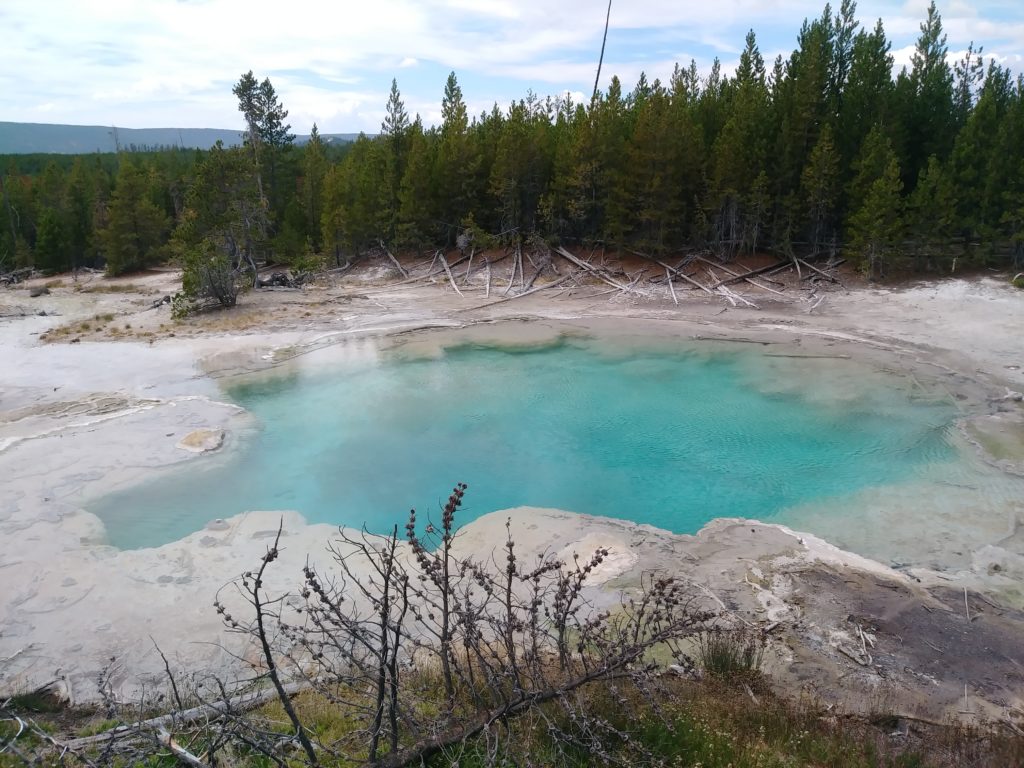
Mammoth Hot Springs and the North Entrance
I drove up to the North Entrance and out, next, just to see what Montana looked like and get gas. It was only a few miles past my actual destination, Mammoth Hot Springs, which are travertine terraces (see list of terms, above).
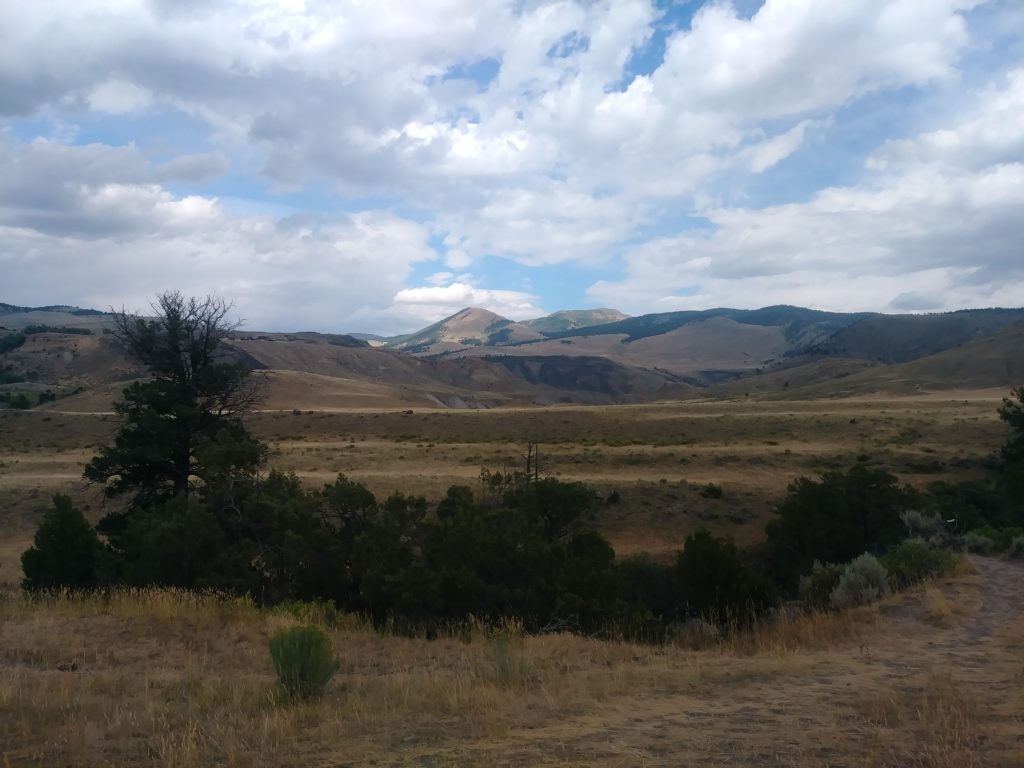
Gardiner, MT, seems to exist solely because of Yellowstone, not because of any intrinsic redeeming qualities. I was not impressed.
Can soak in Boiling River- the only place you can do so in Yellowstone- but it was closed, likely due to the plague.
The North Entrance boasts the Roosevelt Arch. I’m not sure what the big deal is. Perhaps the Romans would be excited over such a thing. I think it just looks like a rounded pile of rocks you can drive through. As with the East Entrance, the climb out of and into Ystone is no joke. The Mammoth Springs Village area was the swankiest I saw in the whole park, boasting fancy buildings such as a hotel and a grill. The traffic was a disaster, but I got there towards the end of the day, and I was able to locate parking at the terraces.
I started at the Upper Terrace, I believe, and worked my way down.
So, these are travertine terraces.
Signs about “changing landscape” which translates as lots of the pools and springs on the terraces have dried up for unknown reasons. Result: pretty, white, dry pools and almost no smell. Can definitely see why so many Roman names of features (which the boardwalk takes you to but no longer have water or color)- Romans would’ve loved the hot springs (Roman baths).
Nonetheless, the terraces were pretty. Saw three elk sleeping on lower terraces at empty pools. They’re giant deer, really. Look tasty.
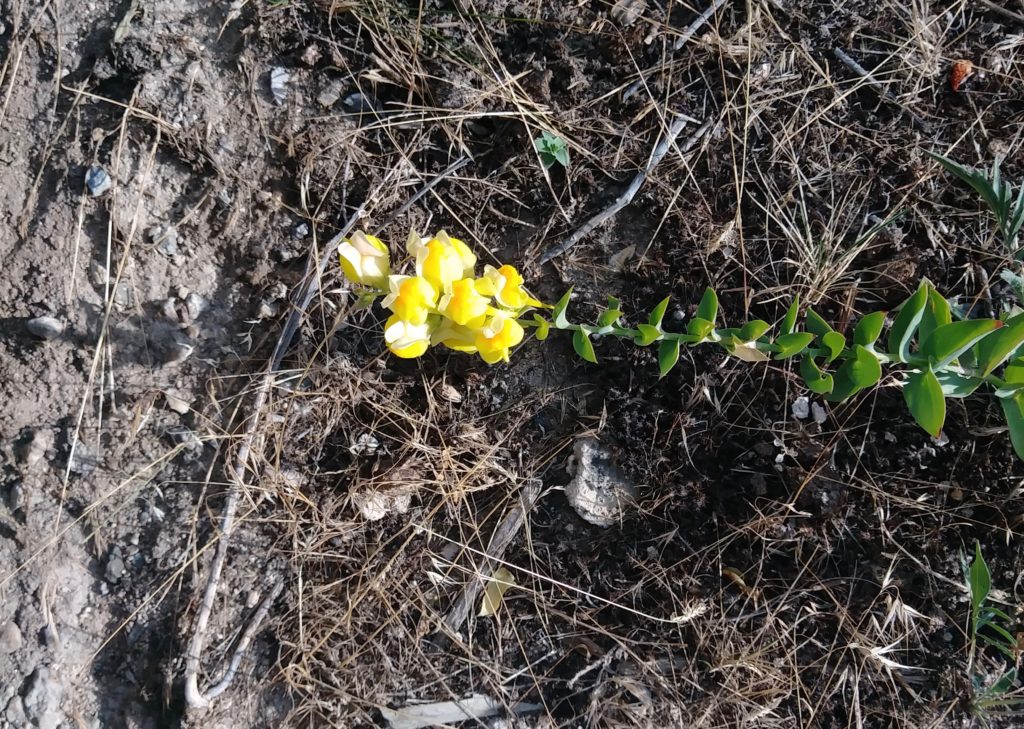
I saw wild snapdragons here, and met a lovely birdie, half the size of my fist, hopping about in a dry pool. I politely asked it if it would pose for me to take its picture, and it did.
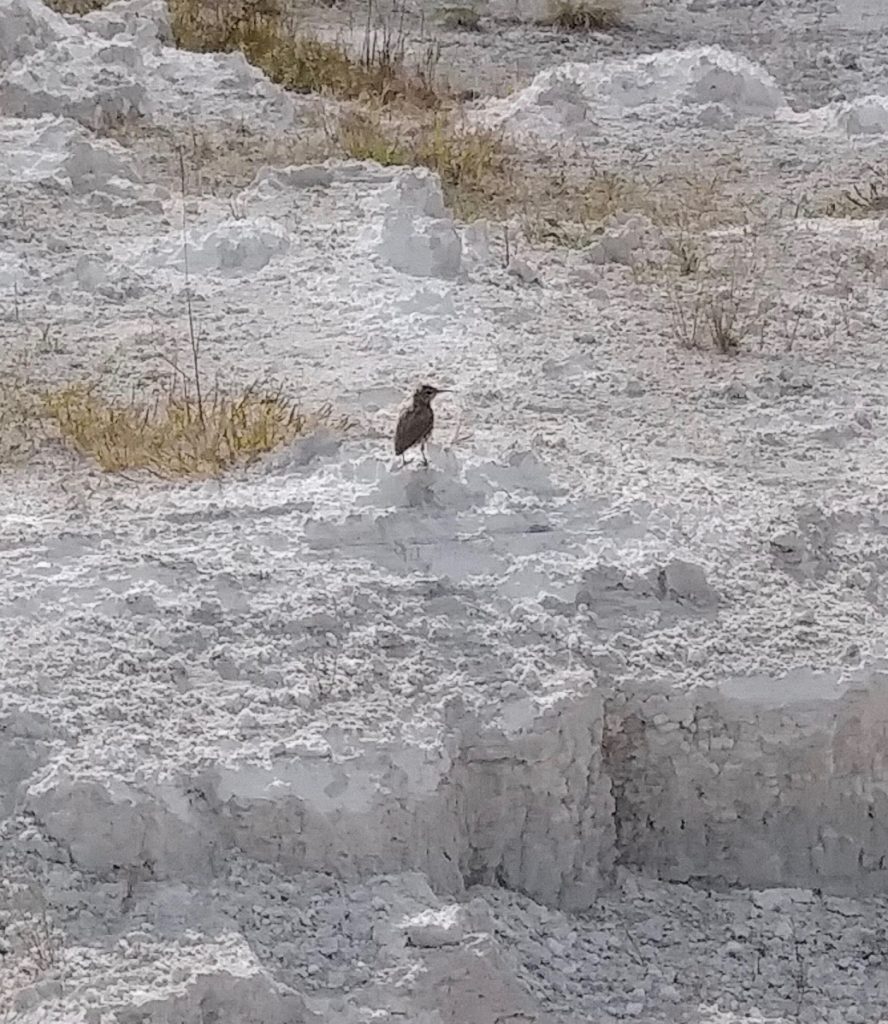
I thanked it and complimented it.
So, Mammoth Spring Terraces would be the royal courts of hell- still hell, but more gamorous than the wastes of the rest of the land.
Liberty Cap, above, was formed by a spring that is now extinct.
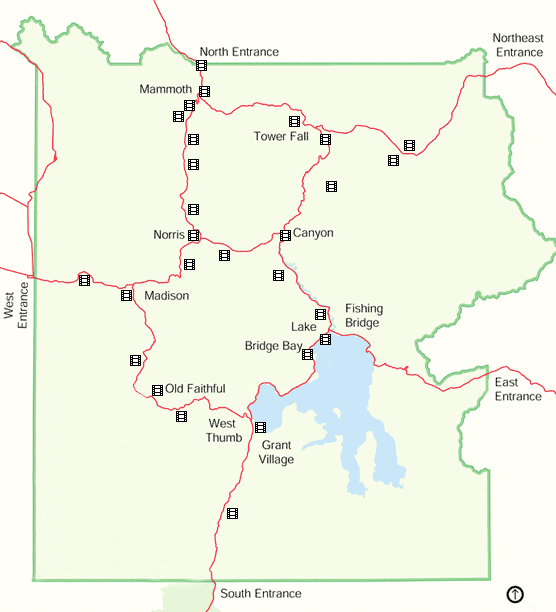
Good thing I went to Mammoth when I did. The next day, the road from Norris to Mammoth was closed indefinitely due to a water main break. Must have been some water main. Anyways, with the Tower-Roosevelt to Canyon part of the loop closed through 2022, that left no way to reach the North Entrance, or to enter the park from the north.
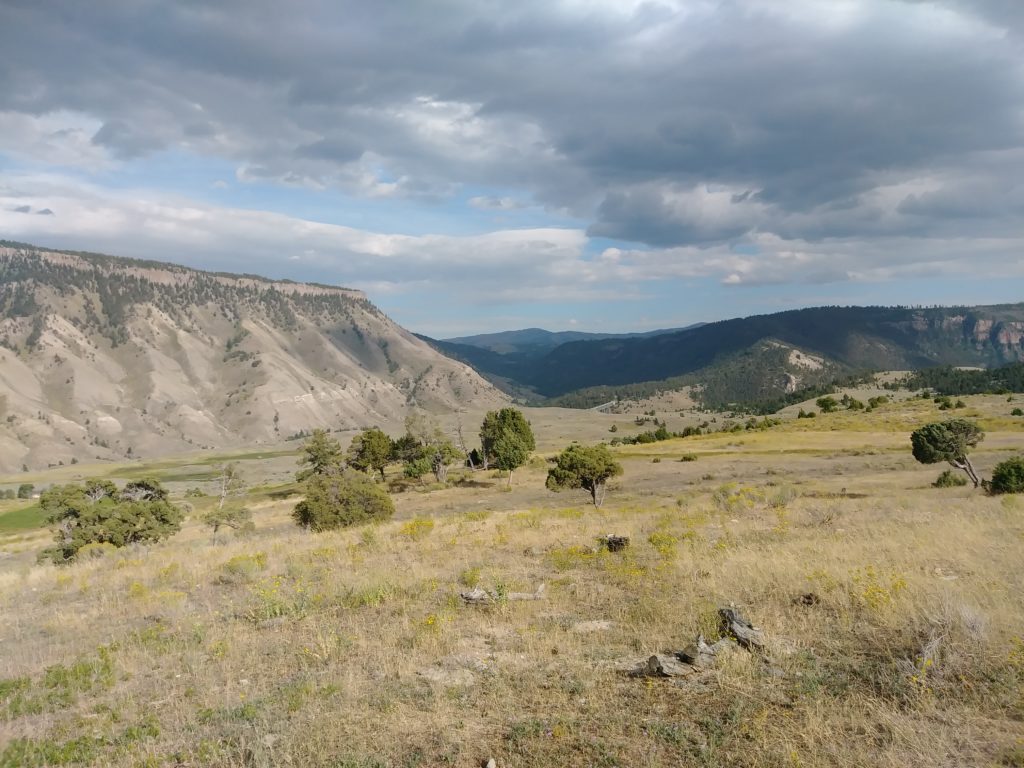
It was the day of my visit to Mammoth Springs that I noted just how much I was enjoying washing my camp pans in a sink– admittedly, a communal sink with bitterly cold water.
What has become of me?!
After Norris Basin and Mammoth Springs, my revulsion was moderated by admiration. I concluded that my remaining time would be best spent pursuing, for the most part, hydrothermal sights in the park. There are mountains and lakes and creeks and trees everywhere. When was I going to see hot springs and geysers again?
The adventure continues for a second week on page 2, where reside the best of the photographs.
